My University Life Experiences
VerifiedAdded on 2020/01/28
|51
|19261
|119
Essay
AI Summary
This assignment is a personal essay where the author reflects on their two years of university life at Bucks New University. They discuss the positive aspects of their experience, including forming strong friendships, benefiting from supportive tutors, and gaining practical knowledge through an internship. The essay highlights the author's academic growth and expresses gratitude towards their university, professors, and friends.
Contribute Materials
Your contribution can guide someone’s learning journey. Share your
documents today.
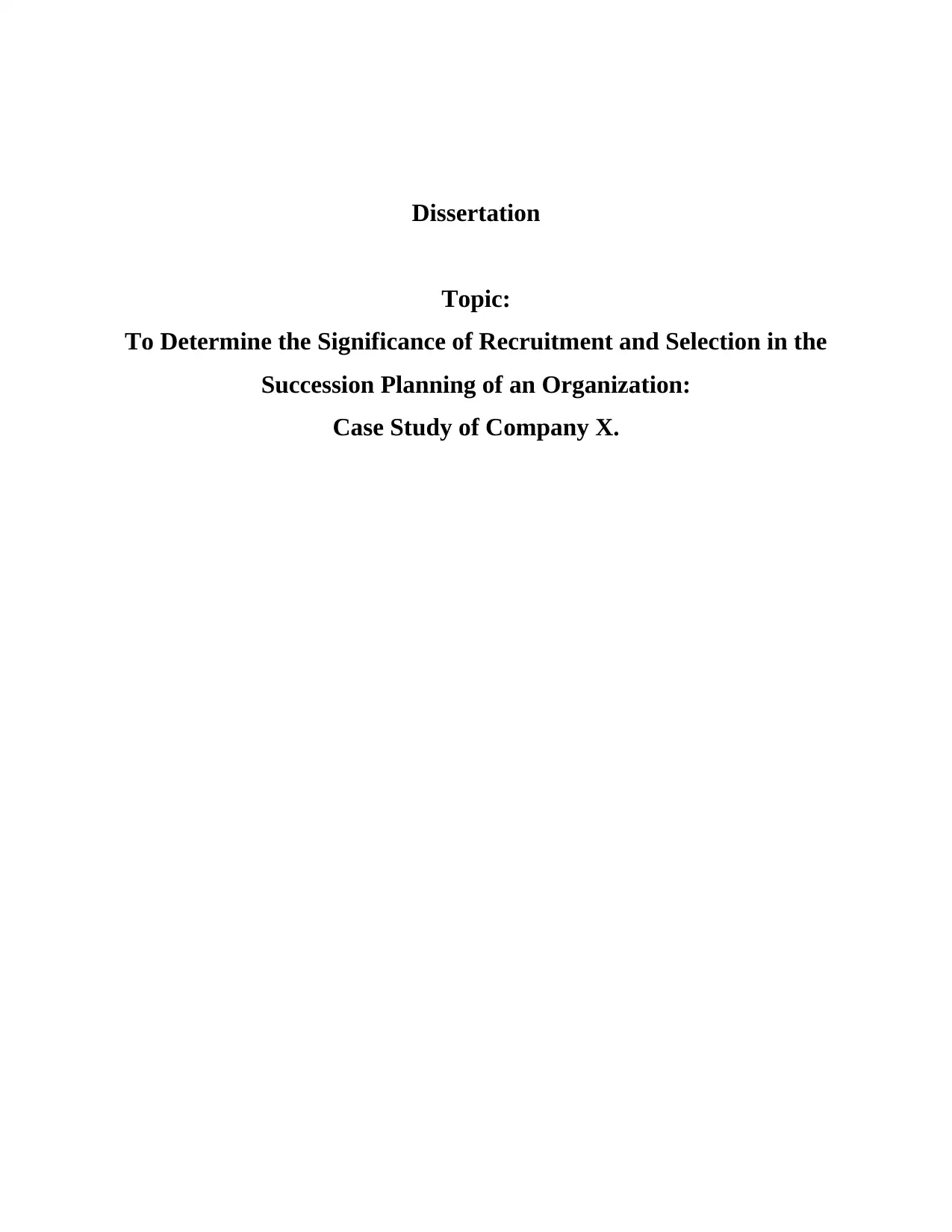
Dissertation
Topic:
To Determine the Significance of Recruitment and Selection in the
Succession Planning of an Organization:
Case Study of Company X.
Topic:
To Determine the Significance of Recruitment and Selection in the
Succession Planning of an Organization:
Case Study of Company X.
Secure Best Marks with AI Grader
Need help grading? Try our AI Grader for instant feedback on your assignments.
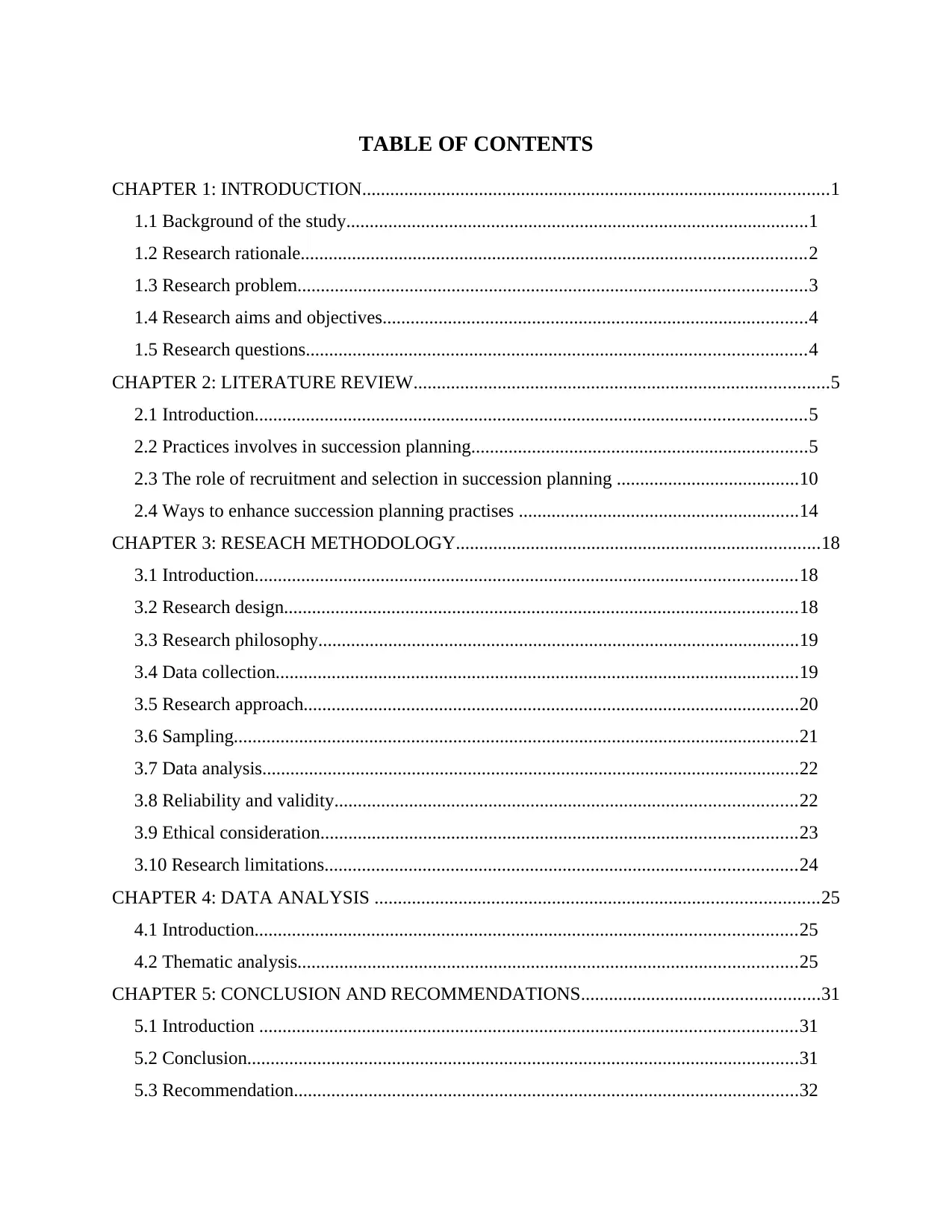
TABLE OF CONTENTS
CHAPTER 1: INTRODUCTION....................................................................................................1
1.1 Background of the study...................................................................................................1
1.2 Research rationale............................................................................................................2
1.3 Research problem.............................................................................................................3
1.4 Research aims and objectives...........................................................................................4
1.5 Research questions...........................................................................................................4
CHAPTER 2: LITERATURE REVIEW.........................................................................................5
2.1 Introduction......................................................................................................................5
2.2 Practices involves in succession planning........................................................................5
2.3 The role of recruitment and selection in succession planning .......................................10
2.4 Ways to enhance succession planning practises ............................................................14
CHAPTER 3: RESEACH METHODOLOGY..............................................................................18
3.1 Introduction....................................................................................................................18
3.2 Research design..............................................................................................................18
3.3 Research philosophy.......................................................................................................19
3.4 Data collection................................................................................................................19
3.5 Research approach..........................................................................................................20
3.6 Sampling.........................................................................................................................21
3.7 Data analysis...................................................................................................................22
3.8 Reliability and validity...................................................................................................22
3.9 Ethical consideration......................................................................................................23
3.10 Research limitations.....................................................................................................24
CHAPTER 4: DATA ANALYSIS ...............................................................................................25
4.1 Introduction....................................................................................................................25
4.2 Thematic analysis...........................................................................................................25
CHAPTER 5: CONCLUSION AND RECOMMENDATIONS...................................................31
5.1 Introduction ...................................................................................................................31
5.2 Conclusion......................................................................................................................31
5.3 Recommendation............................................................................................................32
CHAPTER 1: INTRODUCTION....................................................................................................1
1.1 Background of the study...................................................................................................1
1.2 Research rationale............................................................................................................2
1.3 Research problem.............................................................................................................3
1.4 Research aims and objectives...........................................................................................4
1.5 Research questions...........................................................................................................4
CHAPTER 2: LITERATURE REVIEW.........................................................................................5
2.1 Introduction......................................................................................................................5
2.2 Practices involves in succession planning........................................................................5
2.3 The role of recruitment and selection in succession planning .......................................10
2.4 Ways to enhance succession planning practises ............................................................14
CHAPTER 3: RESEACH METHODOLOGY..............................................................................18
3.1 Introduction....................................................................................................................18
3.2 Research design..............................................................................................................18
3.3 Research philosophy.......................................................................................................19
3.4 Data collection................................................................................................................19
3.5 Research approach..........................................................................................................20
3.6 Sampling.........................................................................................................................21
3.7 Data analysis...................................................................................................................22
3.8 Reliability and validity...................................................................................................22
3.9 Ethical consideration......................................................................................................23
3.10 Research limitations.....................................................................................................24
CHAPTER 4: DATA ANALYSIS ...............................................................................................25
4.1 Introduction....................................................................................................................25
4.2 Thematic analysis...........................................................................................................25
CHAPTER 5: CONCLUSION AND RECOMMENDATIONS...................................................31
5.1 Introduction ...................................................................................................................31
5.2 Conclusion......................................................................................................................31
5.3 Recommendation............................................................................................................32
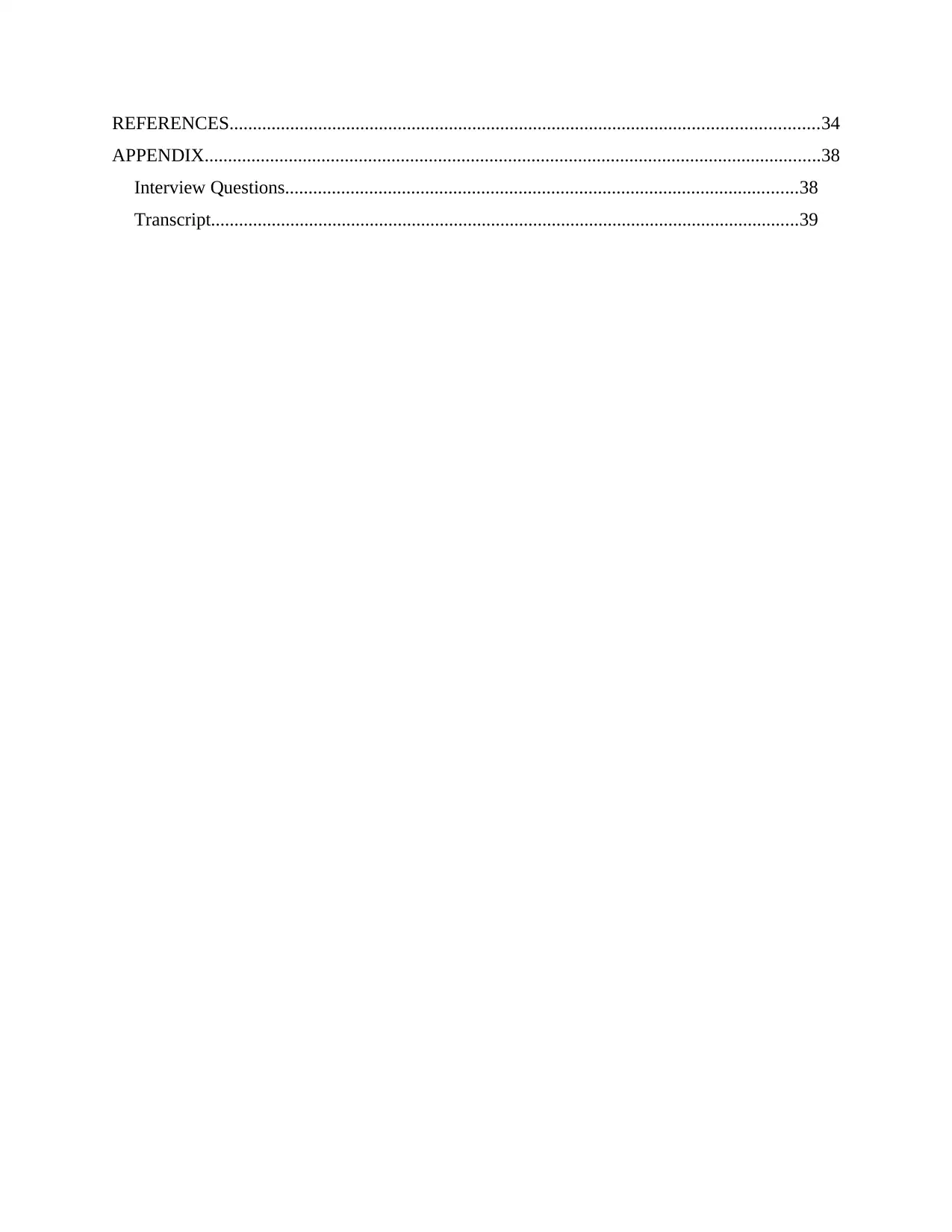
REFERENCES..............................................................................................................................34
APPENDIX....................................................................................................................................38
Interview Questions..............................................................................................................38
Transcript..............................................................................................................................39
APPENDIX....................................................................................................................................38
Interview Questions..............................................................................................................38
Transcript..............................................................................................................................39
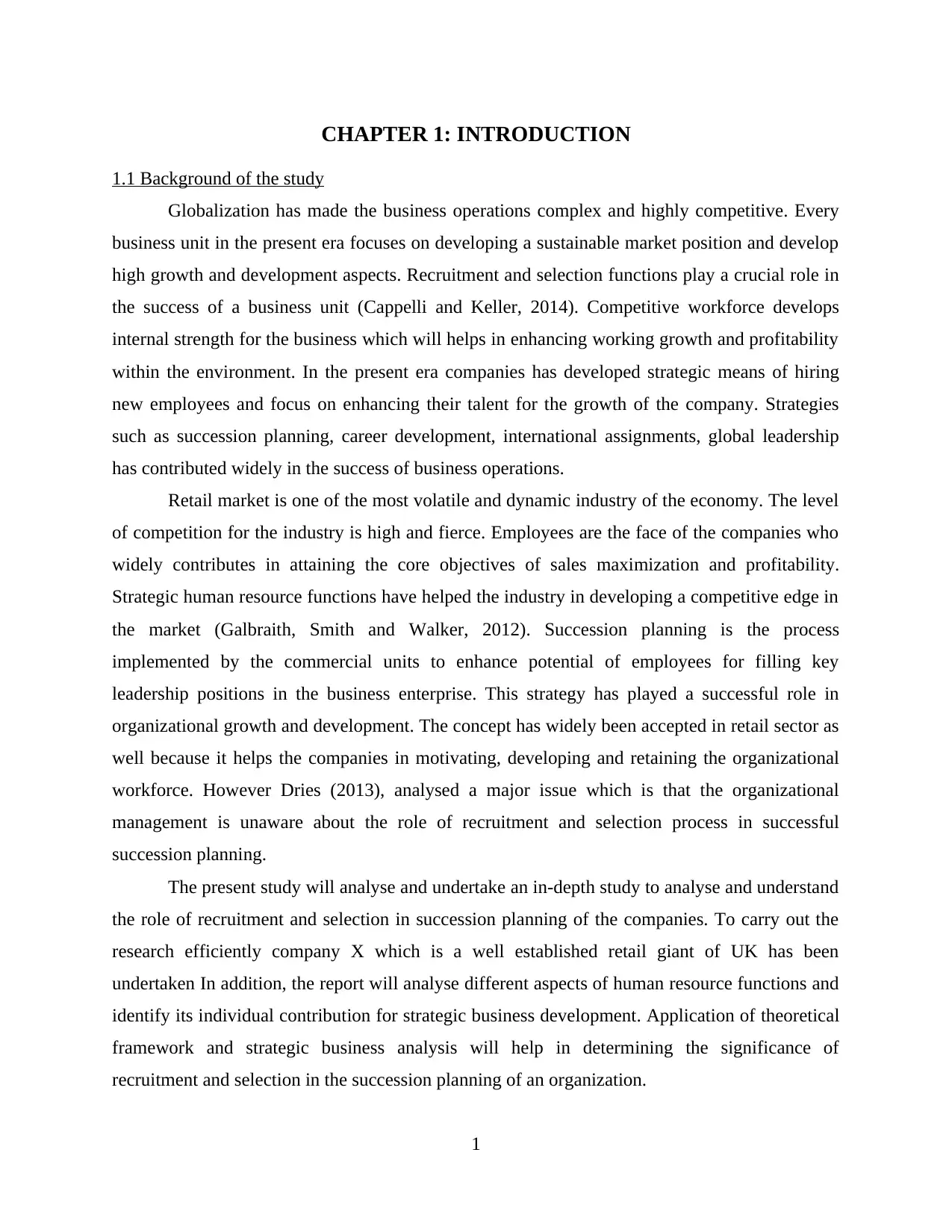
CHAPTER 1: INTRODUCTION
1.1 Background of the study
Globalization has made the business operations complex and highly competitive. Every
business unit in the present era focuses on developing a sustainable market position and develop
high growth and development aspects. Recruitment and selection functions play a crucial role in
the success of a business unit (Cappelli and Keller, 2014). Competitive workforce develops
internal strength for the business which will helps in enhancing working growth and profitability
within the environment. In the present era companies has developed strategic means of hiring
new employees and focus on enhancing their talent for the growth of the company. Strategies
such as succession planning, career development, international assignments, global leadership
has contributed widely in the success of business operations.
Retail market is one of the most volatile and dynamic industry of the economy. The level
of competition for the industry is high and fierce. Employees are the face of the companies who
widely contributes in attaining the core objectives of sales maximization and profitability.
Strategic human resource functions have helped the industry in developing a competitive edge in
the market (Galbraith, Smith and Walker, 2012). Succession planning is the process
implemented by the commercial units to enhance potential of employees for filling key
leadership positions in the business enterprise. This strategy has played a successful role in
organizational growth and development. The concept has widely been accepted in retail sector as
well because it helps the companies in motivating, developing and retaining the organizational
workforce. However Dries (2013), analysed a major issue which is that the organizational
management is unaware about the role of recruitment and selection process in successful
succession planning.
The present study will analyse and undertake an in-depth study to analyse and understand
the role of recruitment and selection in succession planning of the companies. To carry out the
research efficiently company X which is a well established retail giant of UK has been
undertaken In addition, the report will analyse different aspects of human resource functions and
identify its individual contribution for strategic business development. Application of theoretical
framework and strategic business analysis will help in determining the significance of
recruitment and selection in the succession planning of an organization.
1
1.1 Background of the study
Globalization has made the business operations complex and highly competitive. Every
business unit in the present era focuses on developing a sustainable market position and develop
high growth and development aspects. Recruitment and selection functions play a crucial role in
the success of a business unit (Cappelli and Keller, 2014). Competitive workforce develops
internal strength for the business which will helps in enhancing working growth and profitability
within the environment. In the present era companies has developed strategic means of hiring
new employees and focus on enhancing their talent for the growth of the company. Strategies
such as succession planning, career development, international assignments, global leadership
has contributed widely in the success of business operations.
Retail market is one of the most volatile and dynamic industry of the economy. The level
of competition for the industry is high and fierce. Employees are the face of the companies who
widely contributes in attaining the core objectives of sales maximization and profitability.
Strategic human resource functions have helped the industry in developing a competitive edge in
the market (Galbraith, Smith and Walker, 2012). Succession planning is the process
implemented by the commercial units to enhance potential of employees for filling key
leadership positions in the business enterprise. This strategy has played a successful role in
organizational growth and development. The concept has widely been accepted in retail sector as
well because it helps the companies in motivating, developing and retaining the organizational
workforce. However Dries (2013), analysed a major issue which is that the organizational
management is unaware about the role of recruitment and selection process in successful
succession planning.
The present study will analyse and undertake an in-depth study to analyse and understand
the role of recruitment and selection in succession planning of the companies. To carry out the
research efficiently company X which is a well established retail giant of UK has been
undertaken In addition, the report will analyse different aspects of human resource functions and
identify its individual contribution for strategic business development. Application of theoretical
framework and strategic business analysis will help in determining the significance of
recruitment and selection in the succession planning of an organization.
1
Secure Best Marks with AI Grader
Need help grading? Try our AI Grader for instant feedback on your assignments.
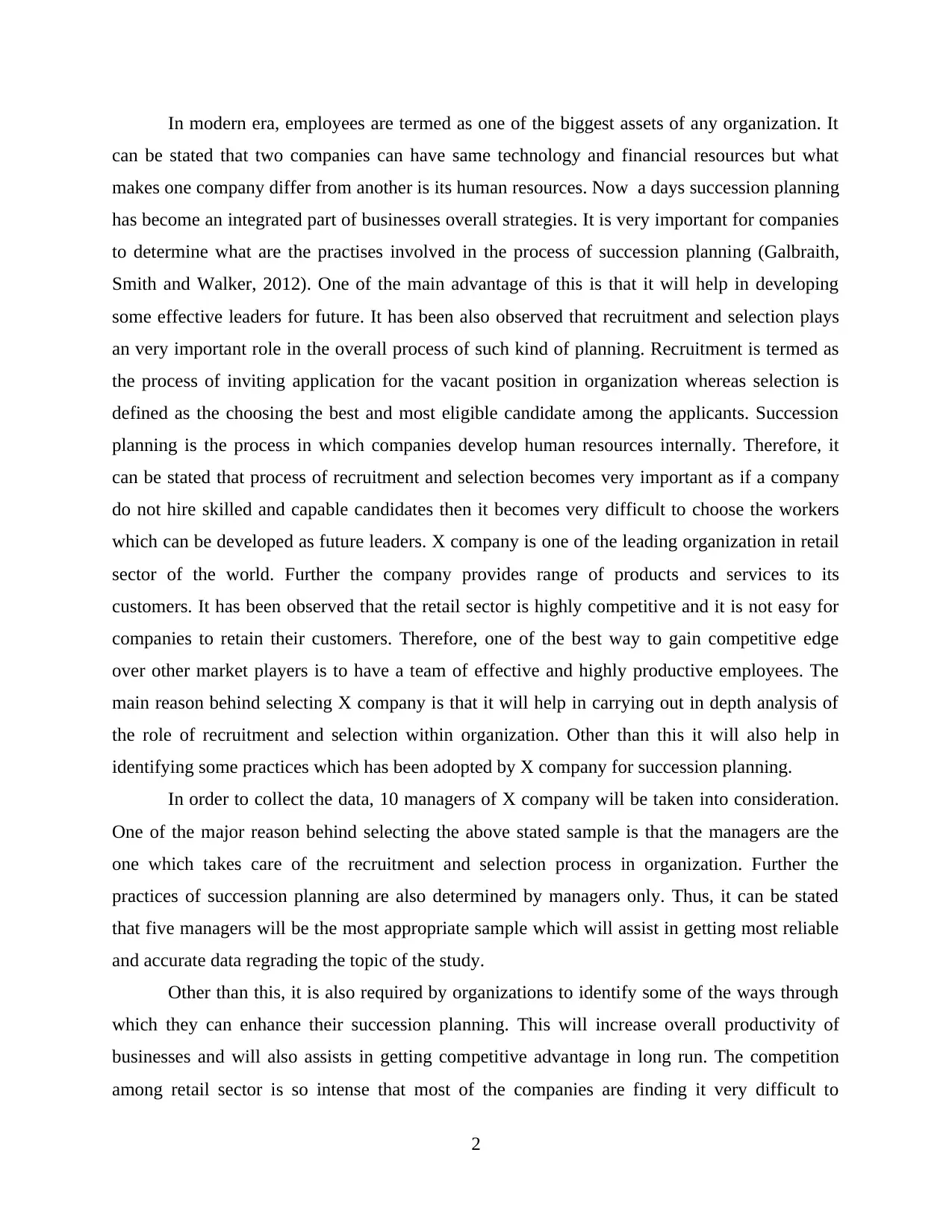
In modern era, employees are termed as one of the biggest assets of any organization. It
can be stated that two companies can have same technology and financial resources but what
makes one company differ from another is its human resources. Now a days succession planning
has become an integrated part of businesses overall strategies. It is very important for companies
to determine what are the practises involved in the process of succession planning (Galbraith,
Smith and Walker, 2012). One of the main advantage of this is that it will help in developing
some effective leaders for future. It has been also observed that recruitment and selection plays
an very important role in the overall process of such kind of planning. Recruitment is termed as
the process of inviting application for the vacant position in organization whereas selection is
defined as the choosing the best and most eligible candidate among the applicants. Succession
planning is the process in which companies develop human resources internally. Therefore, it
can be stated that process of recruitment and selection becomes very important as if a company
do not hire skilled and capable candidates then it becomes very difficult to choose the workers
which can be developed as future leaders. X company is one of the leading organization in retail
sector of the world. Further the company provides range of products and services to its
customers. It has been observed that the retail sector is highly competitive and it is not easy for
companies to retain their customers. Therefore, one of the best way to gain competitive edge
over other market players is to have a team of effective and highly productive employees. The
main reason behind selecting X company is that it will help in carrying out in depth analysis of
the role of recruitment and selection within organization. Other than this it will also help in
identifying some practices which has been adopted by X company for succession planning.
In order to collect the data, 10 managers of X company will be taken into consideration.
One of the major reason behind selecting the above stated sample is that the managers are the
one which takes care of the recruitment and selection process in organization. Further the
practices of succession planning are also determined by managers only. Thus, it can be stated
that five managers will be the most appropriate sample which will assist in getting most reliable
and accurate data regrading the topic of the study.
Other than this, it is also required by organizations to identify some of the ways through
which they can enhance their succession planning. This will increase overall productivity of
businesses and will also assists in getting competitive advantage in long run. The competition
among retail sector is so intense that most of the companies are finding it very difficult to
2
can be stated that two companies can have same technology and financial resources but what
makes one company differ from another is its human resources. Now a days succession planning
has become an integrated part of businesses overall strategies. It is very important for companies
to determine what are the practises involved in the process of succession planning (Galbraith,
Smith and Walker, 2012). One of the main advantage of this is that it will help in developing
some effective leaders for future. It has been also observed that recruitment and selection plays
an very important role in the overall process of such kind of planning. Recruitment is termed as
the process of inviting application for the vacant position in organization whereas selection is
defined as the choosing the best and most eligible candidate among the applicants. Succession
planning is the process in which companies develop human resources internally. Therefore, it
can be stated that process of recruitment and selection becomes very important as if a company
do not hire skilled and capable candidates then it becomes very difficult to choose the workers
which can be developed as future leaders. X company is one of the leading organization in retail
sector of the world. Further the company provides range of products and services to its
customers. It has been observed that the retail sector is highly competitive and it is not easy for
companies to retain their customers. Therefore, one of the best way to gain competitive edge
over other market players is to have a team of effective and highly productive employees. The
main reason behind selecting X company is that it will help in carrying out in depth analysis of
the role of recruitment and selection within organization. Other than this it will also help in
identifying some practices which has been adopted by X company for succession planning.
In order to collect the data, 10 managers of X company will be taken into consideration.
One of the major reason behind selecting the above stated sample is that the managers are the
one which takes care of the recruitment and selection process in organization. Further the
practices of succession planning are also determined by managers only. Thus, it can be stated
that five managers will be the most appropriate sample which will assist in getting most reliable
and accurate data regrading the topic of the study.
Other than this, it is also required by organizations to identify some of the ways through
which they can enhance their succession planning. This will increase overall productivity of
businesses and will also assists in getting competitive advantage in long run. The competition
among retail sector is so intense that most of the companies are finding it very difficult to
2
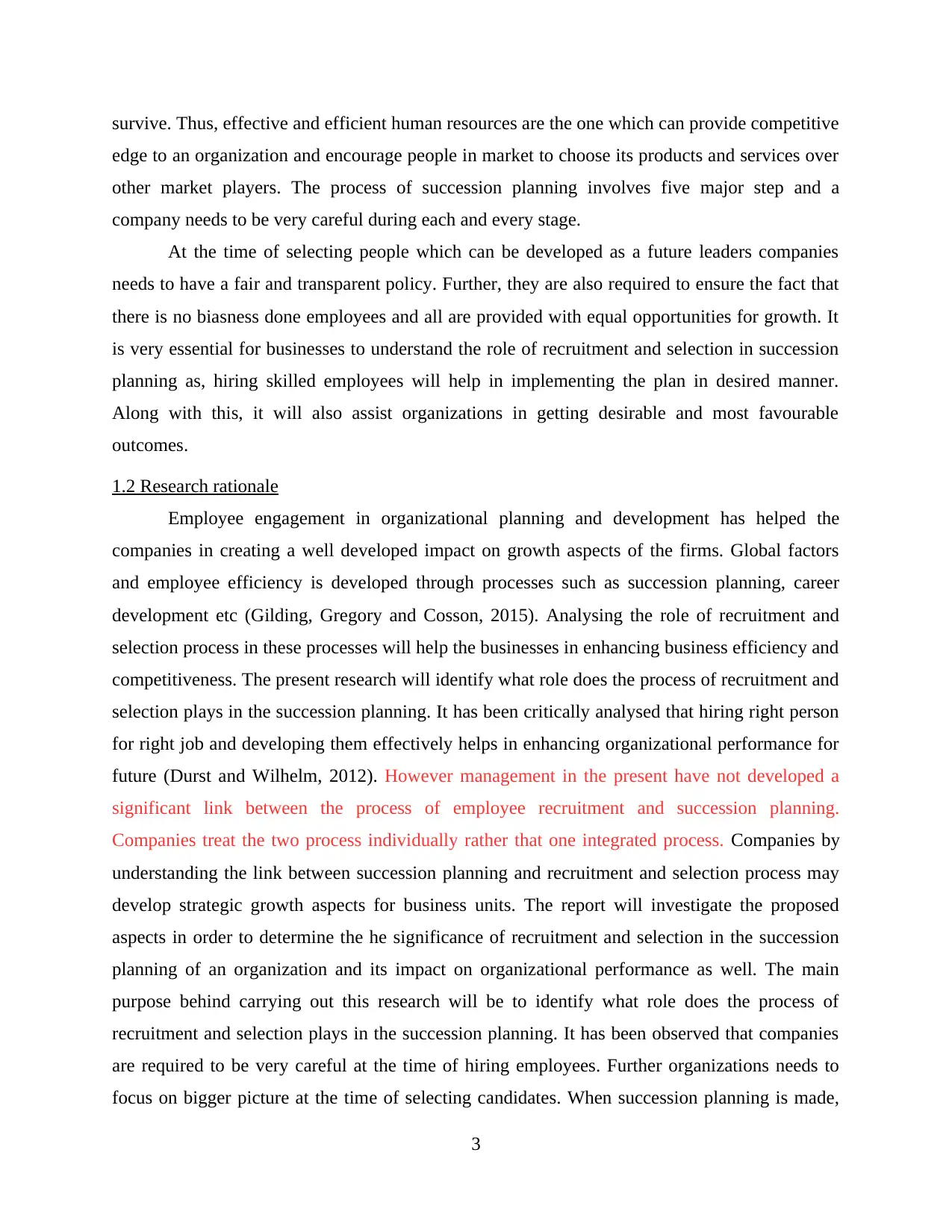
survive. Thus, effective and efficient human resources are the one which can provide competitive
edge to an organization and encourage people in market to choose its products and services over
other market players. The process of succession planning involves five major step and a
company needs to be very careful during each and every stage.
At the time of selecting people which can be developed as a future leaders companies
needs to have a fair and transparent policy. Further, they are also required to ensure the fact that
there is no biasness done employees and all are provided with equal opportunities for growth. It
is very essential for businesses to understand the role of recruitment and selection in succession
planning as, hiring skilled employees will help in implementing the plan in desired manner.
Along with this, it will also assist organizations in getting desirable and most favourable
outcomes.
1.2 Research rationale
Employee engagement in organizational planning and development has helped the
companies in creating a well developed impact on growth aspects of the firms. Global factors
and employee efficiency is developed through processes such as succession planning, career
development etc (Gilding, Gregory and Cosson, 2015). Analysing the role of recruitment and
selection process in these processes will help the businesses in enhancing business efficiency and
competitiveness. The present research will identify what role does the process of recruitment and
selection plays in the succession planning. It has been critically analysed that hiring right person
for right job and developing them effectively helps in enhancing organizational performance for
future (Durst and Wilhelm, 2012). However management in the present have not developed a
significant link between the process of employee recruitment and succession planning.
Companies treat the two process individually rather that one integrated process. Companies by
understanding the link between succession planning and recruitment and selection process may
develop strategic growth aspects for business units. The report will investigate the proposed
aspects in order to determine the he significance of recruitment and selection in the succession
planning of an organization and its impact on organizational performance as well. The main
purpose behind carrying out this research will be to identify what role does the process of
recruitment and selection plays in the succession planning. It has been observed that companies
are required to be very careful at the time of hiring employees. Further organizations needs to
focus on bigger picture at the time of selecting candidates. When succession planning is made,
3
edge to an organization and encourage people in market to choose its products and services over
other market players. The process of succession planning involves five major step and a
company needs to be very careful during each and every stage.
At the time of selecting people which can be developed as a future leaders companies
needs to have a fair and transparent policy. Further, they are also required to ensure the fact that
there is no biasness done employees and all are provided with equal opportunities for growth. It
is very essential for businesses to understand the role of recruitment and selection in succession
planning as, hiring skilled employees will help in implementing the plan in desired manner.
Along with this, it will also assist organizations in getting desirable and most favourable
outcomes.
1.2 Research rationale
Employee engagement in organizational planning and development has helped the
companies in creating a well developed impact on growth aspects of the firms. Global factors
and employee efficiency is developed through processes such as succession planning, career
development etc (Gilding, Gregory and Cosson, 2015). Analysing the role of recruitment and
selection process in these processes will help the businesses in enhancing business efficiency and
competitiveness. The present research will identify what role does the process of recruitment and
selection plays in the succession planning. It has been critically analysed that hiring right person
for right job and developing them effectively helps in enhancing organizational performance for
future (Durst and Wilhelm, 2012). However management in the present have not developed a
significant link between the process of employee recruitment and succession planning.
Companies treat the two process individually rather that one integrated process. Companies by
understanding the link between succession planning and recruitment and selection process may
develop strategic growth aspects for business units. The report will investigate the proposed
aspects in order to determine the he significance of recruitment and selection in the succession
planning of an organization and its impact on organizational performance as well. The main
purpose behind carrying out this research will be to identify what role does the process of
recruitment and selection plays in the succession planning. It has been observed that companies
are required to be very careful at the time of hiring employees. Further organizations needs to
focus on bigger picture at the time of selecting candidates. When succession planning is made,
3
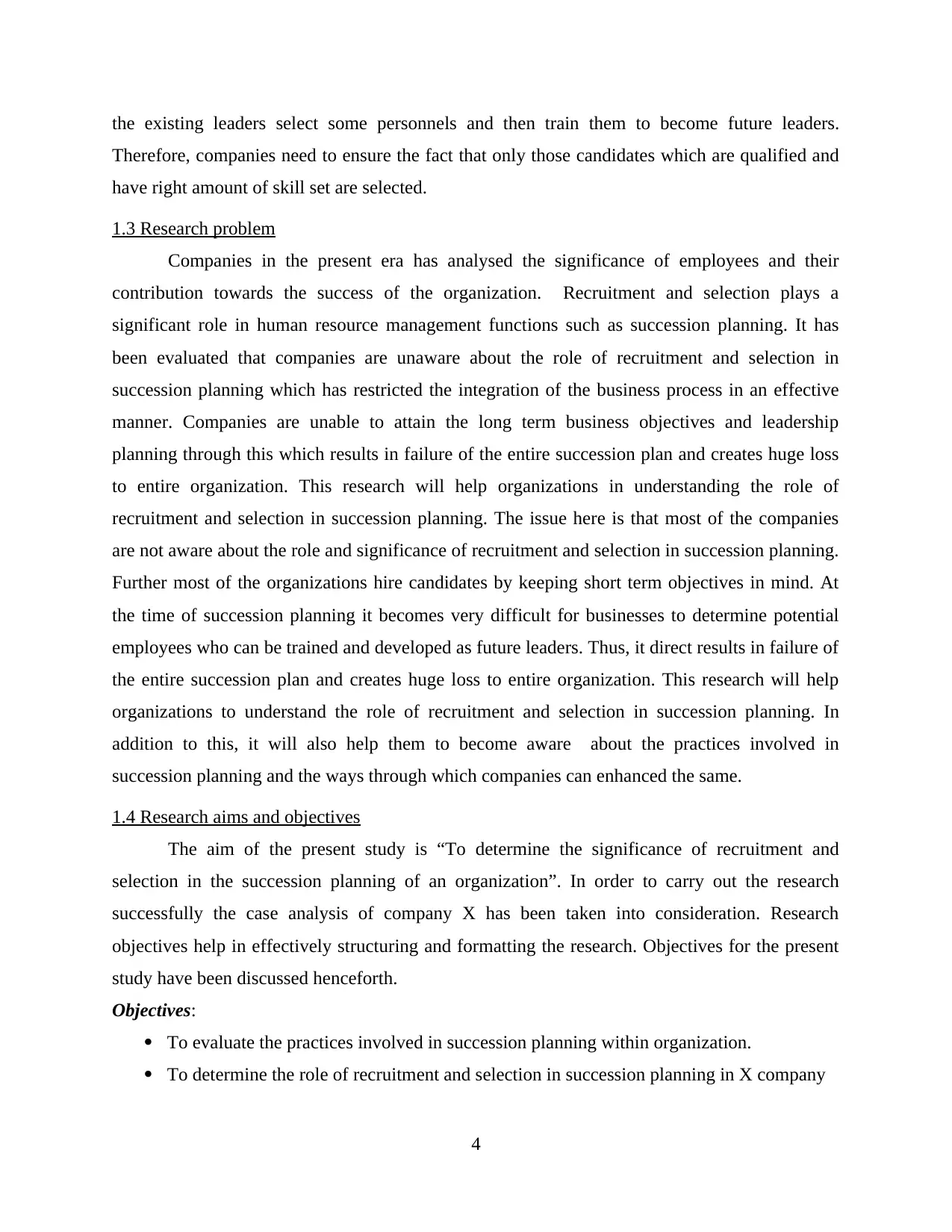
the existing leaders select some personnels and then train them to become future leaders.
Therefore, companies need to ensure the fact that only those candidates which are qualified and
have right amount of skill set are selected.
1.3 Research problem
Companies in the present era has analysed the significance of employees and their
contribution towards the success of the organization. Recruitment and selection plays a
significant role in human resource management functions such as succession planning. It has
been evaluated that companies are unaware about the role of recruitment and selection in
succession planning which has restricted the integration of the business process in an effective
manner. Companies are unable to attain the long term business objectives and leadership
planning through this which results in failure of the entire succession plan and creates huge loss
to entire organization. This research will help organizations in understanding the role of
recruitment and selection in succession planning. The issue here is that most of the companies
are not aware about the role and significance of recruitment and selection in succession planning.
Further most of the organizations hire candidates by keeping short term objectives in mind. At
the time of succession planning it becomes very difficult for businesses to determine potential
employees who can be trained and developed as future leaders. Thus, it direct results in failure of
the entire succession plan and creates huge loss to entire organization. This research will help
organizations to understand the role of recruitment and selection in succession planning. In
addition to this, it will also help them to become aware about the practices involved in
succession planning and the ways through which companies can enhanced the same.
1.4 Research aims and objectives
The aim of the present study is “To determine the significance of recruitment and
selection in the succession planning of an organization”. In order to carry out the research
successfully the case analysis of company X has been taken into consideration. Research
objectives help in effectively structuring and formatting the research. Objectives for the present
study have been discussed henceforth.
Objectives:
To evaluate the practices involved in succession planning within organization.
To determine the role of recruitment and selection in succession planning in X company
4
Therefore, companies need to ensure the fact that only those candidates which are qualified and
have right amount of skill set are selected.
1.3 Research problem
Companies in the present era has analysed the significance of employees and their
contribution towards the success of the organization. Recruitment and selection plays a
significant role in human resource management functions such as succession planning. It has
been evaluated that companies are unaware about the role of recruitment and selection in
succession planning which has restricted the integration of the business process in an effective
manner. Companies are unable to attain the long term business objectives and leadership
planning through this which results in failure of the entire succession plan and creates huge loss
to entire organization. This research will help organizations in understanding the role of
recruitment and selection in succession planning. The issue here is that most of the companies
are not aware about the role and significance of recruitment and selection in succession planning.
Further most of the organizations hire candidates by keeping short term objectives in mind. At
the time of succession planning it becomes very difficult for businesses to determine potential
employees who can be trained and developed as future leaders. Thus, it direct results in failure of
the entire succession plan and creates huge loss to entire organization. This research will help
organizations to understand the role of recruitment and selection in succession planning. In
addition to this, it will also help them to become aware about the practices involved in
succession planning and the ways through which companies can enhanced the same.
1.4 Research aims and objectives
The aim of the present study is “To determine the significance of recruitment and
selection in the succession planning of an organization”. In order to carry out the research
successfully the case analysis of company X has been taken into consideration. Research
objectives help in effectively structuring and formatting the research. Objectives for the present
study have been discussed henceforth.
Objectives:
To evaluate the practices involved in succession planning within organization.
To determine the role of recruitment and selection in succession planning in X company
4
Paraphrase This Document
Need a fresh take? Get an instant paraphrase of this document with our AI Paraphraser
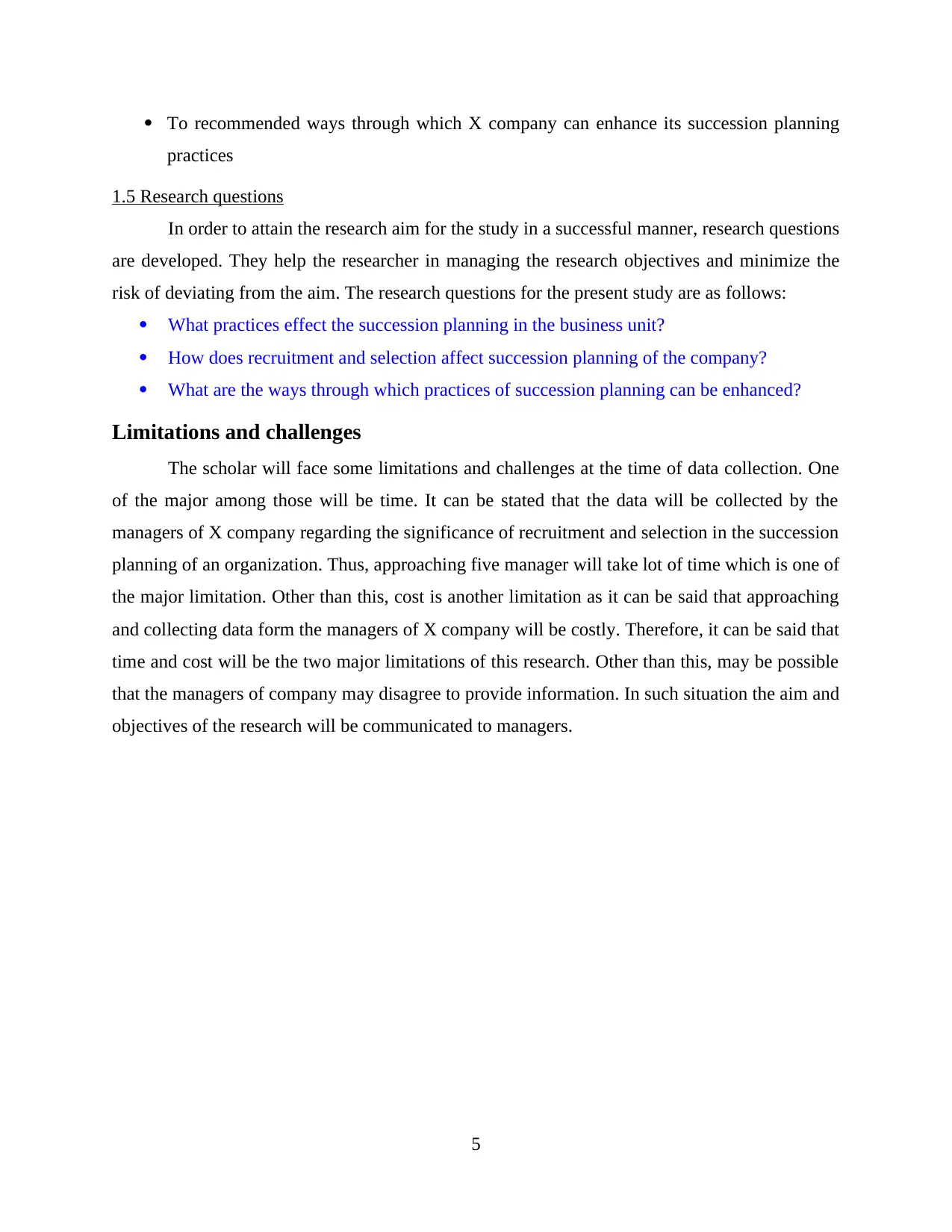
To recommended ways through which X company can enhance its succession planning
practices
1.5 Research questions
In order to attain the research aim for the study in a successful manner, research questions
are developed. They help the researcher in managing the research objectives and minimize the
risk of deviating from the aim. The research questions for the present study are as follows:
What practices effect the succession planning in the business unit?
How does recruitment and selection affect succession planning of the company?
What are the ways through which practices of succession planning can be enhanced?
Limitations and challenges
The scholar will face some limitations and challenges at the time of data collection. One
of the major among those will be time. It can be stated that the data will be collected by the
managers of X company regarding the significance of recruitment and selection in the succession
planning of an organization. Thus, approaching five manager will take lot of time which is one of
the major limitation. Other than this, cost is another limitation as it can be said that approaching
and collecting data form the managers of X company will be costly. Therefore, it can be said that
time and cost will be the two major limitations of this research. Other than this, may be possible
that the managers of company may disagree to provide information. In such situation the aim and
objectives of the research will be communicated to managers.
5
practices
1.5 Research questions
In order to attain the research aim for the study in a successful manner, research questions
are developed. They help the researcher in managing the research objectives and minimize the
risk of deviating from the aim. The research questions for the present study are as follows:
What practices effect the succession planning in the business unit?
How does recruitment and selection affect succession planning of the company?
What are the ways through which practices of succession planning can be enhanced?
Limitations and challenges
The scholar will face some limitations and challenges at the time of data collection. One
of the major among those will be time. It can be stated that the data will be collected by the
managers of X company regarding the significance of recruitment and selection in the succession
planning of an organization. Thus, approaching five manager will take lot of time which is one of
the major limitation. Other than this, cost is another limitation as it can be said that approaching
and collecting data form the managers of X company will be costly. Therefore, it can be said that
time and cost will be the two major limitations of this research. Other than this, may be possible
that the managers of company may disagree to provide information. In such situation the aim and
objectives of the research will be communicated to managers.
5
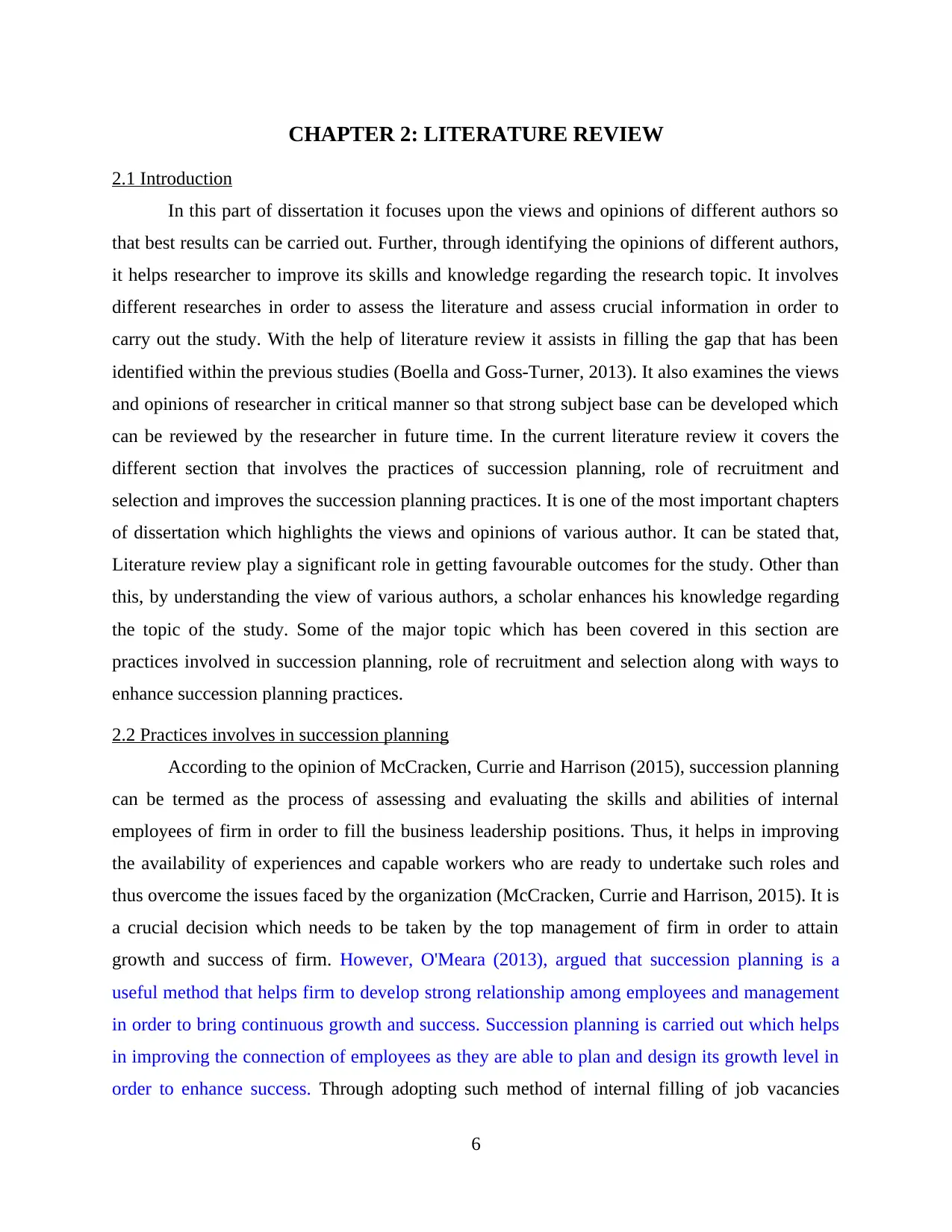
CHAPTER 2: LITERATURE REVIEW
2.1 Introduction
In this part of dissertation it focuses upon the views and opinions of different authors so
that best results can be carried out. Further, through identifying the opinions of different authors,
it helps researcher to improve its skills and knowledge regarding the research topic. It involves
different researches in order to assess the literature and assess crucial information in order to
carry out the study. With the help of literature review it assists in filling the gap that has been
identified within the previous studies (Boella and Goss-Turner, 2013). It also examines the views
and opinions of researcher in critical manner so that strong subject base can be developed which
can be reviewed by the researcher in future time. In the current literature review it covers the
different section that involves the practices of succession planning, role of recruitment and
selection and improves the succession planning practices. It is one of the most important chapters
of dissertation which highlights the views and opinions of various author. It can be stated that,
Literature review play a significant role in getting favourable outcomes for the study. Other than
this, by understanding the view of various authors, a scholar enhances his knowledge regarding
the topic of the study. Some of the major topic which has been covered in this section are
practices involved in succession planning, role of recruitment and selection along with ways to
enhance succession planning practices.
2.2 Practices involves in succession planning
According to the opinion of McCracken, Currie and Harrison (2015), succession planning
can be termed as the process of assessing and evaluating the skills and abilities of internal
employees of firm in order to fill the business leadership positions. Thus, it helps in improving
the availability of experiences and capable workers who are ready to undertake such roles and
thus overcome the issues faced by the organization (McCracken, Currie and Harrison, 2015). It is
a crucial decision which needs to be taken by the top management of firm in order to attain
growth and success of firm. However, O'Meara (2013), argued that succession planning is a
useful method that helps firm to develop strong relationship among employees and management
in order to bring continuous growth and success. Succession planning is carried out which helps
in improving the connection of employees as they are able to plan and design its growth level in
order to enhance success. Through adopting such method of internal filling of job vacancies
6
2.1 Introduction
In this part of dissertation it focuses upon the views and opinions of different authors so
that best results can be carried out. Further, through identifying the opinions of different authors,
it helps researcher to improve its skills and knowledge regarding the research topic. It involves
different researches in order to assess the literature and assess crucial information in order to
carry out the study. With the help of literature review it assists in filling the gap that has been
identified within the previous studies (Boella and Goss-Turner, 2013). It also examines the views
and opinions of researcher in critical manner so that strong subject base can be developed which
can be reviewed by the researcher in future time. In the current literature review it covers the
different section that involves the practices of succession planning, role of recruitment and
selection and improves the succession planning practices. It is one of the most important chapters
of dissertation which highlights the views and opinions of various author. It can be stated that,
Literature review play a significant role in getting favourable outcomes for the study. Other than
this, by understanding the view of various authors, a scholar enhances his knowledge regarding
the topic of the study. Some of the major topic which has been covered in this section are
practices involved in succession planning, role of recruitment and selection along with ways to
enhance succession planning practices.
2.2 Practices involves in succession planning
According to the opinion of McCracken, Currie and Harrison (2015), succession planning
can be termed as the process of assessing and evaluating the skills and abilities of internal
employees of firm in order to fill the business leadership positions. Thus, it helps in improving
the availability of experiences and capable workers who are ready to undertake such roles and
thus overcome the issues faced by the organization (McCracken, Currie and Harrison, 2015). It is
a crucial decision which needs to be taken by the top management of firm in order to attain
growth and success of firm. However, O'Meara (2013), argued that succession planning is a
useful method that helps firm to develop strong relationship among employees and management
in order to bring continuous growth and success. Succession planning is carried out which helps
in improving the connection of employees as they are able to plan and design its growth level in
order to enhance success. Through adopting such method of internal filling of job vacancies
6
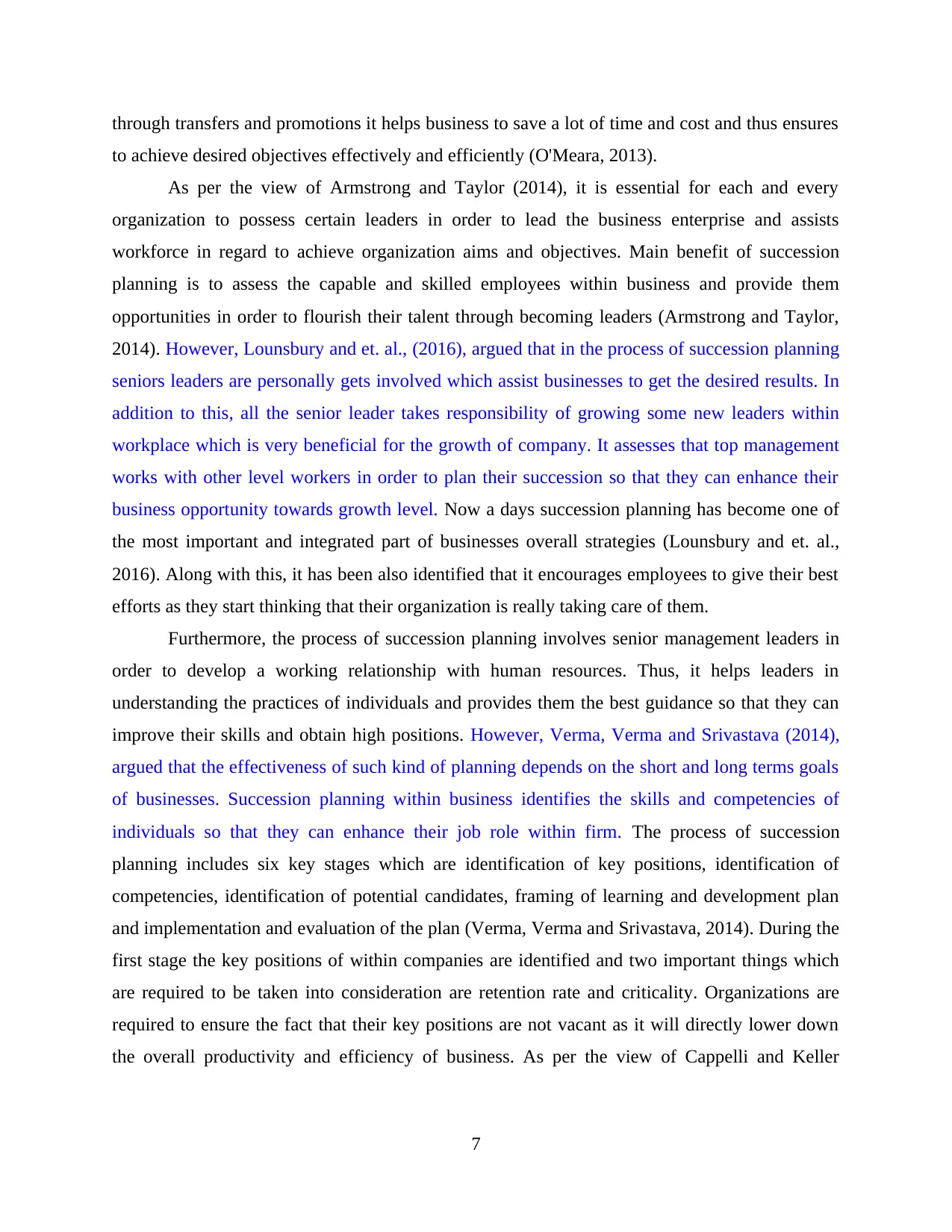
through transfers and promotions it helps business to save a lot of time and cost and thus ensures
to achieve desired objectives effectively and efficiently (O'Meara, 2013).
As per the view of Armstrong and Taylor (2014), it is essential for each and every
organization to possess certain leaders in order to lead the business enterprise and assists
workforce in regard to achieve organization aims and objectives. Main benefit of succession
planning is to assess the capable and skilled employees within business and provide them
opportunities in order to flourish their talent through becoming leaders (Armstrong and Taylor,
2014). However, Lounsbury and et. al., (2016), argued that in the process of succession planning
seniors leaders are personally gets involved which assist businesses to get the desired results. In
addition to this, all the senior leader takes responsibility of growing some new leaders within
workplace which is very beneficial for the growth of company. It assesses that top management
works with other level workers in order to plan their succession so that they can enhance their
business opportunity towards growth level. Now a days succession planning has become one of
the most important and integrated part of businesses overall strategies (Lounsbury and et. al.,
2016). Along with this, it has been also identified that it encourages employees to give their best
efforts as they start thinking that their organization is really taking care of them.
Furthermore, the process of succession planning involves senior management leaders in
order to develop a working relationship with human resources. Thus, it helps leaders in
understanding the practices of individuals and provides them the best guidance so that they can
improve their skills and obtain high positions. However, Verma, Verma and Srivastava (2014),
argued that the effectiveness of such kind of planning depends on the short and long terms goals
of businesses. Succession planning within business identifies the skills and competencies of
individuals so that they can enhance their job role within firm. The process of succession
planning includes six key stages which are identification of key positions, identification of
competencies, identification of potential candidates, framing of learning and development plan
and implementation and evaluation of the plan (Verma, Verma and Srivastava, 2014). During the
first stage the key positions of within companies are identified and two important things which
are required to be taken into consideration are retention rate and criticality. Organizations are
required to ensure the fact that their key positions are not vacant as it will directly lower down
the overall productivity and efficiency of business. As per the view of Cappelli and Keller
7
to achieve desired objectives effectively and efficiently (O'Meara, 2013).
As per the view of Armstrong and Taylor (2014), it is essential for each and every
organization to possess certain leaders in order to lead the business enterprise and assists
workforce in regard to achieve organization aims and objectives. Main benefit of succession
planning is to assess the capable and skilled employees within business and provide them
opportunities in order to flourish their talent through becoming leaders (Armstrong and Taylor,
2014). However, Lounsbury and et. al., (2016), argued that in the process of succession planning
seniors leaders are personally gets involved which assist businesses to get the desired results. In
addition to this, all the senior leader takes responsibility of growing some new leaders within
workplace which is very beneficial for the growth of company. It assesses that top management
works with other level workers in order to plan their succession so that they can enhance their
business opportunity towards growth level. Now a days succession planning has become one of
the most important and integrated part of businesses overall strategies (Lounsbury and et. al.,
2016). Along with this, it has been also identified that it encourages employees to give their best
efforts as they start thinking that their organization is really taking care of them.
Furthermore, the process of succession planning involves senior management leaders in
order to develop a working relationship with human resources. Thus, it helps leaders in
understanding the practices of individuals and provides them the best guidance so that they can
improve their skills and obtain high positions. However, Verma, Verma and Srivastava (2014),
argued that the effectiveness of such kind of planning depends on the short and long terms goals
of businesses. Succession planning within business identifies the skills and competencies of
individuals so that they can enhance their job role within firm. The process of succession
planning includes six key stages which are identification of key positions, identification of
competencies, identification of potential candidates, framing of learning and development plan
and implementation and evaluation of the plan (Verma, Verma and Srivastava, 2014). During the
first stage the key positions of within companies are identified and two important things which
are required to be taken into consideration are retention rate and criticality. Organizations are
required to ensure the fact that their key positions are not vacant as it will directly lower down
the overall productivity and efficiency of business. As per the view of Cappelli and Keller
7
Secure Best Marks with AI Grader
Need help grading? Try our AI Grader for instant feedback on your assignments.
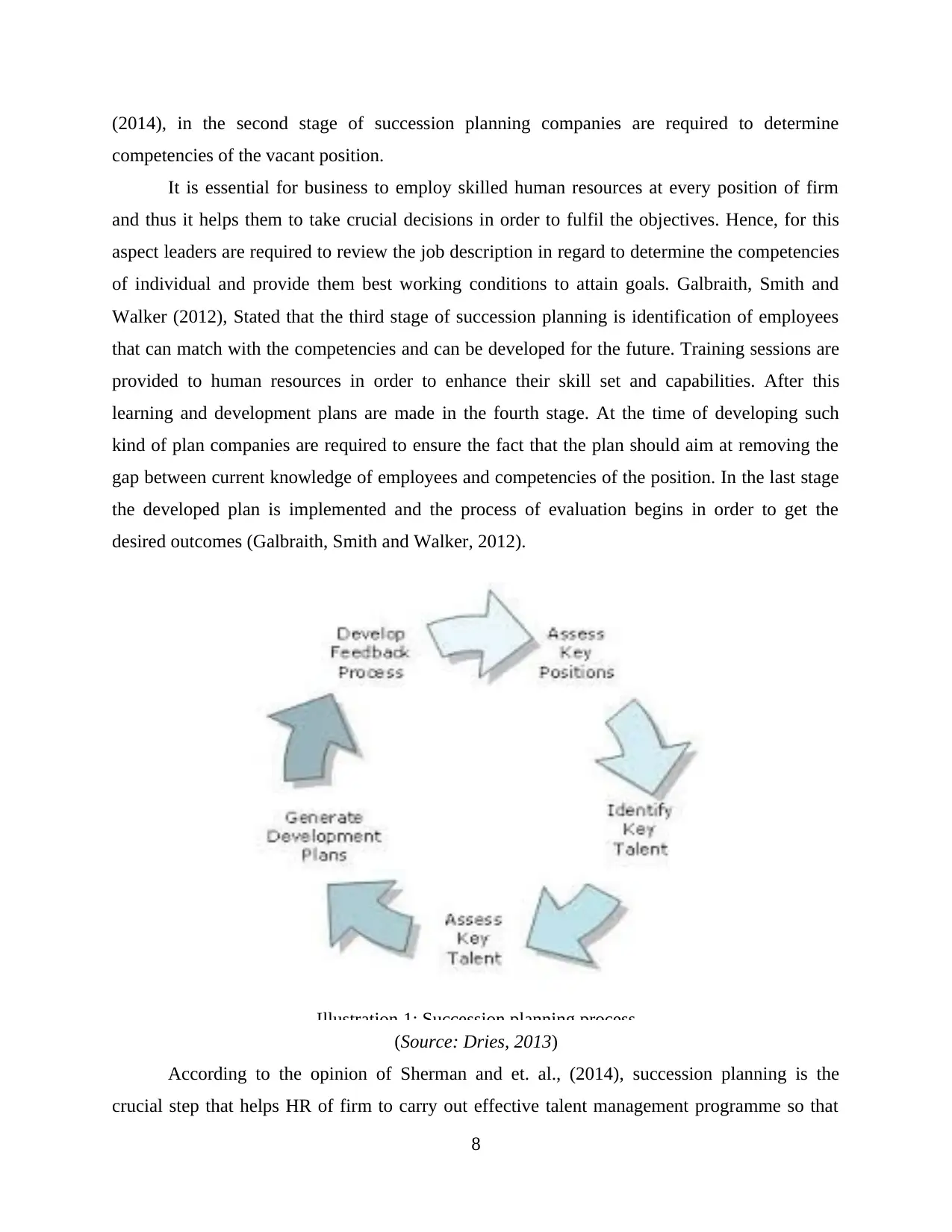
(2014), in the second stage of succession planning companies are required to determine
competencies of the vacant position.
It is essential for business to employ skilled human resources at every position of firm
and thus it helps them to take crucial decisions in order to fulfil the objectives. Hence, for this
aspect leaders are required to review the job description in regard to determine the competencies
of individual and provide them best working conditions to attain goals. Galbraith, Smith and
Walker (2012), Stated that the third stage of succession planning is identification of employees
that can match with the competencies and can be developed for the future. Training sessions are
provided to human resources in order to enhance their skill set and capabilities. After this
learning and development plans are made in the fourth stage. At the time of developing such
kind of plan companies are required to ensure the fact that the plan should aim at removing the
gap between current knowledge of employees and competencies of the position. In the last stage
the developed plan is implemented and the process of evaluation begins in order to get the
desired outcomes (Galbraith, Smith and Walker, 2012).
(Source: Dries, 2013)
According to the opinion of Sherman and et. al., (2014), succession planning is the
crucial step that helps HR of firm to carry out effective talent management programme so that
8
Illustration 1: Succession planning process
competencies of the vacant position.
It is essential for business to employ skilled human resources at every position of firm
and thus it helps them to take crucial decisions in order to fulfil the objectives. Hence, for this
aspect leaders are required to review the job description in regard to determine the competencies
of individual and provide them best working conditions to attain goals. Galbraith, Smith and
Walker (2012), Stated that the third stage of succession planning is identification of employees
that can match with the competencies and can be developed for the future. Training sessions are
provided to human resources in order to enhance their skill set and capabilities. After this
learning and development plans are made in the fourth stage. At the time of developing such
kind of plan companies are required to ensure the fact that the plan should aim at removing the
gap between current knowledge of employees and competencies of the position. In the last stage
the developed plan is implemented and the process of evaluation begins in order to get the
desired outcomes (Galbraith, Smith and Walker, 2012).
(Source: Dries, 2013)
According to the opinion of Sherman and et. al., (2014), succession planning is the
crucial step that helps HR of firm to carry out effective talent management programme so that
8
Illustration 1: Succession planning process
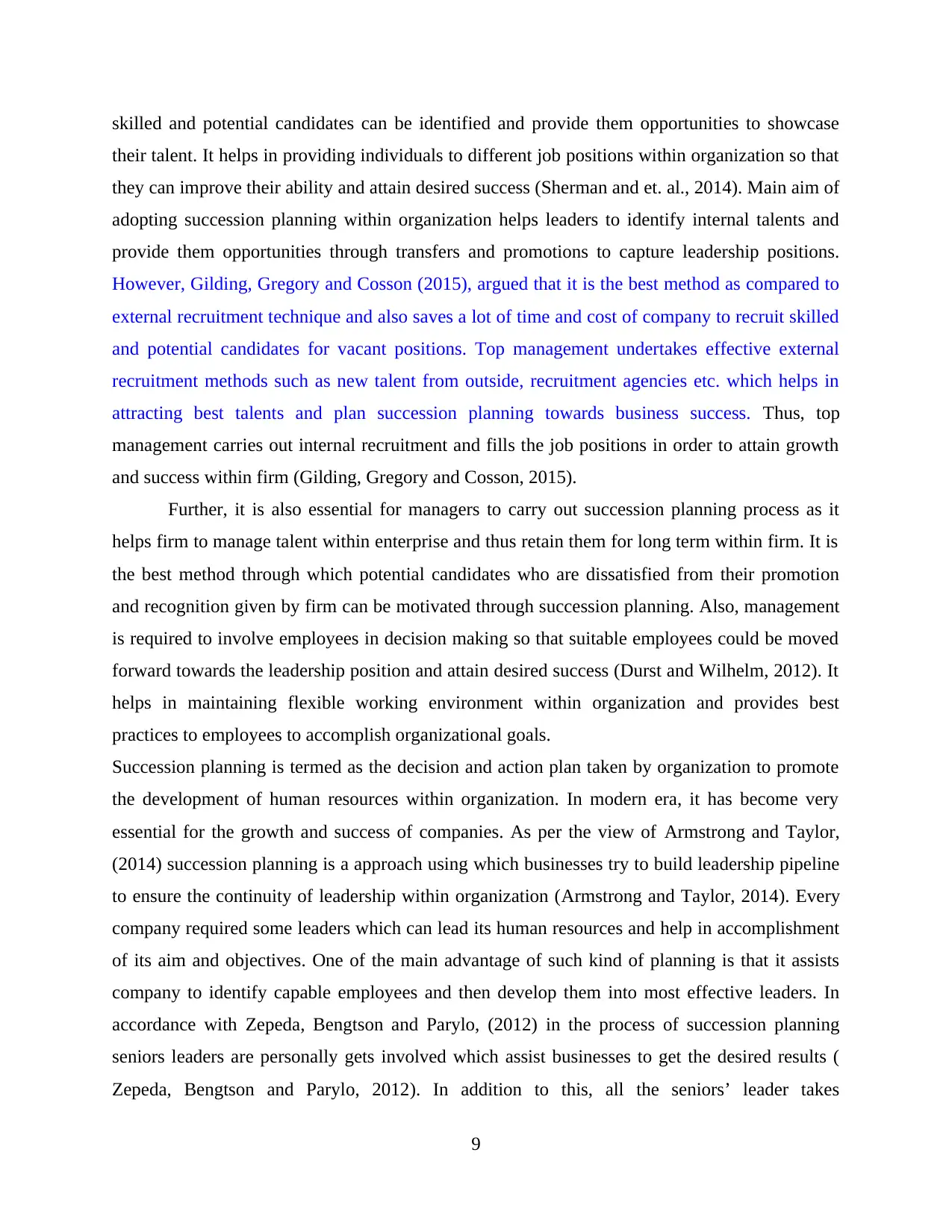
skilled and potential candidates can be identified and provide them opportunities to showcase
their talent. It helps in providing individuals to different job positions within organization so that
they can improve their ability and attain desired success (Sherman and et. al., 2014). Main aim of
adopting succession planning within organization helps leaders to identify internal talents and
provide them opportunities through transfers and promotions to capture leadership positions.
However, Gilding, Gregory and Cosson (2015), argued that it is the best method as compared to
external recruitment technique and also saves a lot of time and cost of company to recruit skilled
and potential candidates for vacant positions. Top management undertakes effective external
recruitment methods such as new talent from outside, recruitment agencies etc. which helps in
attracting best talents and plan succession planning towards business success. Thus, top
management carries out internal recruitment and fills the job positions in order to attain growth
and success within firm (Gilding, Gregory and Cosson, 2015).
Further, it is also essential for managers to carry out succession planning process as it
helps firm to manage talent within enterprise and thus retain them for long term within firm. It is
the best method through which potential candidates who are dissatisfied from their promotion
and recognition given by firm can be motivated through succession planning. Also, management
is required to involve employees in decision making so that suitable employees could be moved
forward towards the leadership position and attain desired success (Durst and Wilhelm, 2012). It
helps in maintaining flexible working environment within organization and provides best
practices to employees to accomplish organizational goals.
Succession planning is termed as the decision and action plan taken by organization to promote
the development of human resources within organization. In modern era, it has become very
essential for the growth and success of companies. As per the view of Armstrong and Taylor,
(2014) succession planning is a approach using which businesses try to build leadership pipeline
to ensure the continuity of leadership within organization (Armstrong and Taylor, 2014). Every
company required some leaders which can lead its human resources and help in accomplishment
of its aim and objectives. One of the main advantage of such kind of planning is that it assists
company to identify capable employees and then develop them into most effective leaders. In
accordance with Zepeda, Bengtson and Parylo, (2012) in the process of succession planning
seniors leaders are personally gets involved which assist businesses to get the desired results (
Zepeda, Bengtson and Parylo, 2012). In addition to this, all the seniors’ leader takes
9
their talent. It helps in providing individuals to different job positions within organization so that
they can improve their ability and attain desired success (Sherman and et. al., 2014). Main aim of
adopting succession planning within organization helps leaders to identify internal talents and
provide them opportunities through transfers and promotions to capture leadership positions.
However, Gilding, Gregory and Cosson (2015), argued that it is the best method as compared to
external recruitment technique and also saves a lot of time and cost of company to recruit skilled
and potential candidates for vacant positions. Top management undertakes effective external
recruitment methods such as new talent from outside, recruitment agencies etc. which helps in
attracting best talents and plan succession planning towards business success. Thus, top
management carries out internal recruitment and fills the job positions in order to attain growth
and success within firm (Gilding, Gregory and Cosson, 2015).
Further, it is also essential for managers to carry out succession planning process as it
helps firm to manage talent within enterprise and thus retain them for long term within firm. It is
the best method through which potential candidates who are dissatisfied from their promotion
and recognition given by firm can be motivated through succession planning. Also, management
is required to involve employees in decision making so that suitable employees could be moved
forward towards the leadership position and attain desired success (Durst and Wilhelm, 2012). It
helps in maintaining flexible working environment within organization and provides best
practices to employees to accomplish organizational goals.
Succession planning is termed as the decision and action plan taken by organization to promote
the development of human resources within organization. In modern era, it has become very
essential for the growth and success of companies. As per the view of Armstrong and Taylor,
(2014) succession planning is a approach using which businesses try to build leadership pipeline
to ensure the continuity of leadership within organization (Armstrong and Taylor, 2014). Every
company required some leaders which can lead its human resources and help in accomplishment
of its aim and objectives. One of the main advantage of such kind of planning is that it assists
company to identify capable employees and then develop them into most effective leaders. In
accordance with Zepeda, Bengtson and Parylo, (2012) in the process of succession planning
seniors leaders are personally gets involved which assist businesses to get the desired results (
Zepeda, Bengtson and Parylo, 2012). In addition to this, all the seniors’ leader takes
9
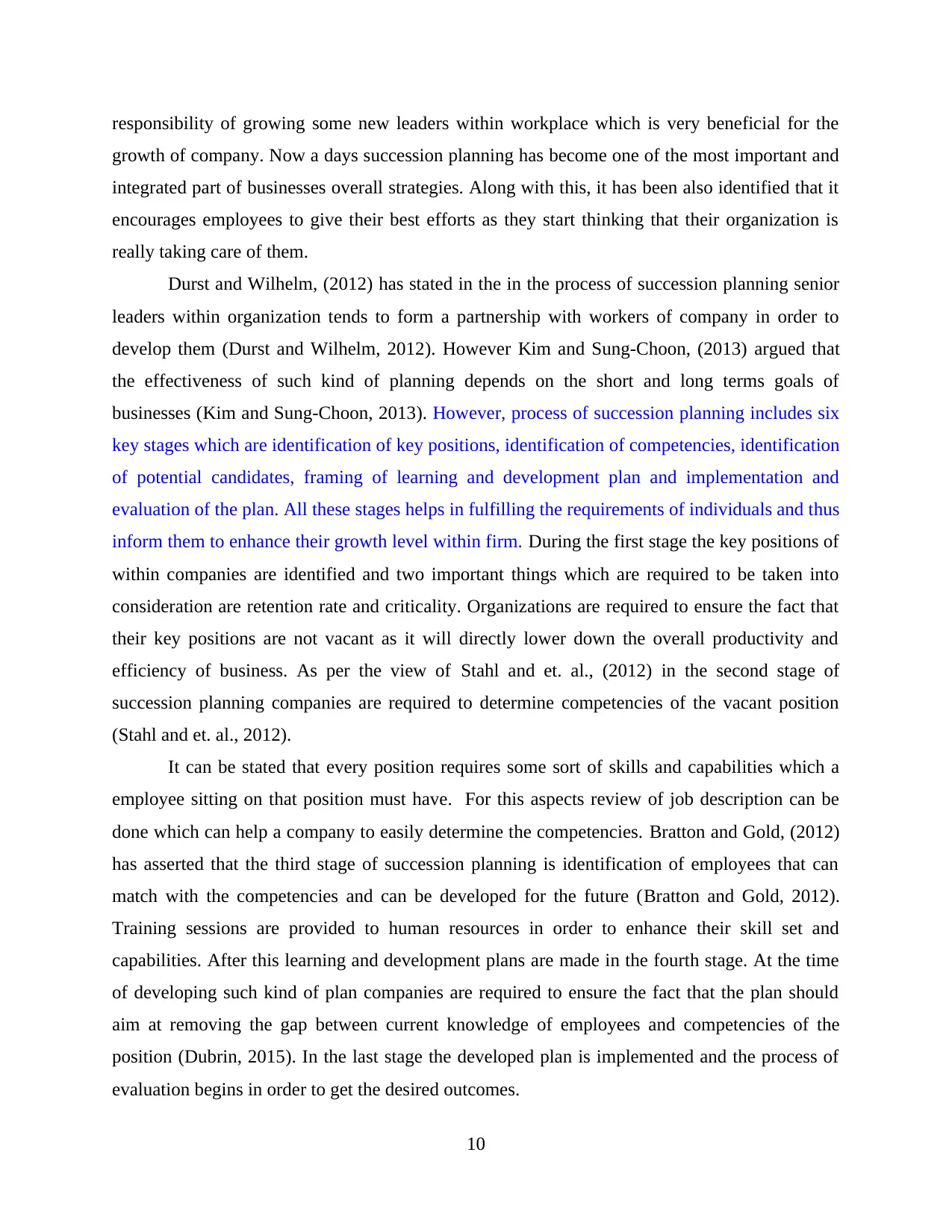
responsibility of growing some new leaders within workplace which is very beneficial for the
growth of company. Now a days succession planning has become one of the most important and
integrated part of businesses overall strategies. Along with this, it has been also identified that it
encourages employees to give their best efforts as they start thinking that their organization is
really taking care of them.
Durst and Wilhelm, (2012) has stated in the in the process of succession planning senior
leaders within organization tends to form a partnership with workers of company in order to
develop them (Durst and Wilhelm, 2012). However Kim and Sung-Choon, (2013) argued that
the effectiveness of such kind of planning depends on the short and long terms goals of
businesses (Kim and Sung-Choon, 2013). However, process of succession planning includes six
key stages which are identification of key positions, identification of competencies, identification
of potential candidates, framing of learning and development plan and implementation and
evaluation of the plan. All these stages helps in fulfilling the requirements of individuals and thus
inform them to enhance their growth level within firm. During the first stage the key positions of
within companies are identified and two important things which are required to be taken into
consideration are retention rate and criticality. Organizations are required to ensure the fact that
their key positions are not vacant as it will directly lower down the overall productivity and
efficiency of business. As per the view of Stahl and et. al., (2012) in the second stage of
succession planning companies are required to determine competencies of the vacant position
(Stahl and et. al., 2012).
It can be stated that every position requires some sort of skills and capabilities which a
employee sitting on that position must have. For this aspects review of job description can be
done which can help a company to easily determine the competencies. Bratton and Gold, (2012)
has asserted that the third stage of succession planning is identification of employees that can
match with the competencies and can be developed for the future (Bratton and Gold, 2012).
Training sessions are provided to human resources in order to enhance their skill set and
capabilities. After this learning and development plans are made in the fourth stage. At the time
of developing such kind of plan companies are required to ensure the fact that the plan should
aim at removing the gap between current knowledge of employees and competencies of the
position (Dubrin, 2015). In the last stage the developed plan is implemented and the process of
evaluation begins in order to get the desired outcomes.
10
growth of company. Now a days succession planning has become one of the most important and
integrated part of businesses overall strategies. Along with this, it has been also identified that it
encourages employees to give their best efforts as they start thinking that their organization is
really taking care of them.
Durst and Wilhelm, (2012) has stated in the in the process of succession planning senior
leaders within organization tends to form a partnership with workers of company in order to
develop them (Durst and Wilhelm, 2012). However Kim and Sung-Choon, (2013) argued that
the effectiveness of such kind of planning depends on the short and long terms goals of
businesses (Kim and Sung-Choon, 2013). However, process of succession planning includes six
key stages which are identification of key positions, identification of competencies, identification
of potential candidates, framing of learning and development plan and implementation and
evaluation of the plan. All these stages helps in fulfilling the requirements of individuals and thus
inform them to enhance their growth level within firm. During the first stage the key positions of
within companies are identified and two important things which are required to be taken into
consideration are retention rate and criticality. Organizations are required to ensure the fact that
their key positions are not vacant as it will directly lower down the overall productivity and
efficiency of business. As per the view of Stahl and et. al., (2012) in the second stage of
succession planning companies are required to determine competencies of the vacant position
(Stahl and et. al., 2012).
It can be stated that every position requires some sort of skills and capabilities which a
employee sitting on that position must have. For this aspects review of job description can be
done which can help a company to easily determine the competencies. Bratton and Gold, (2012)
has asserted that the third stage of succession planning is identification of employees that can
match with the competencies and can be developed for the future (Bratton and Gold, 2012).
Training sessions are provided to human resources in order to enhance their skill set and
capabilities. After this learning and development plans are made in the fourth stage. At the time
of developing such kind of plan companies are required to ensure the fact that the plan should
aim at removing the gap between current knowledge of employees and competencies of the
position (Dubrin, 2015). In the last stage the developed plan is implemented and the process of
evaluation begins in order to get the desired outcomes.
10
Paraphrase This Document
Need a fresh take? Get an instant paraphrase of this document with our AI Paraphraser
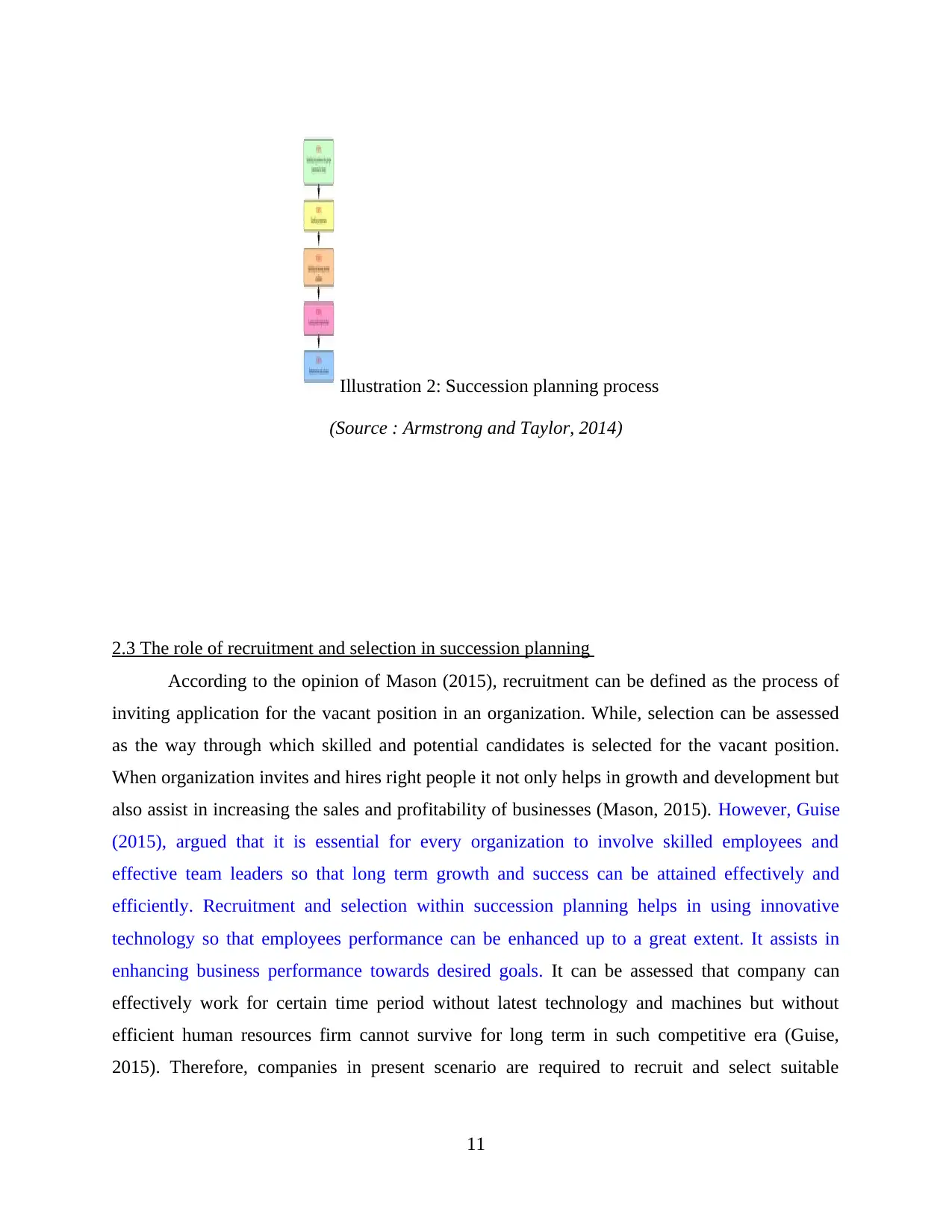
Illustration 2: Succession planning process
(Source : Armstrong and Taylor, 2014)
2.3 The role of recruitment and selection in succession planning
According to the opinion of Mason (2015), recruitment can be defined as the process of
inviting application for the vacant position in an organization. While, selection can be assessed
as the way through which skilled and potential candidates is selected for the vacant position.
When organization invites and hires right people it not only helps in growth and development but
also assist in increasing the sales and profitability of businesses (Mason, 2015). However, Guise
(2015), argued that it is essential for every organization to involve skilled employees and
effective team leaders so that long term growth and success can be attained effectively and
efficiently. Recruitment and selection within succession planning helps in using innovative
technology so that employees performance can be enhanced up to a great extent. It assists in
enhancing business performance towards desired goals. It can be assessed that company can
effectively work for certain time period without latest technology and machines but without
efficient human resources firm cannot survive for long term in such competitive era (Guise,
2015). Therefore, companies in present scenario are required to recruit and select suitable
11
(Source : Armstrong and Taylor, 2014)
2.3 The role of recruitment and selection in succession planning
According to the opinion of Mason (2015), recruitment can be defined as the process of
inviting application for the vacant position in an organization. While, selection can be assessed
as the way through which skilled and potential candidates is selected for the vacant position.
When organization invites and hires right people it not only helps in growth and development but
also assist in increasing the sales and profitability of businesses (Mason, 2015). However, Guise
(2015), argued that it is essential for every organization to involve skilled employees and
effective team leaders so that long term growth and success can be attained effectively and
efficiently. Recruitment and selection within succession planning helps in using innovative
technology so that employees performance can be enhanced up to a great extent. It assists in
enhancing business performance towards desired goals. It can be assessed that company can
effectively work for certain time period without latest technology and machines but without
efficient human resources firm cannot survive for long term in such competitive era (Guise,
2015). Therefore, companies in present scenario are required to recruit and select suitable
11
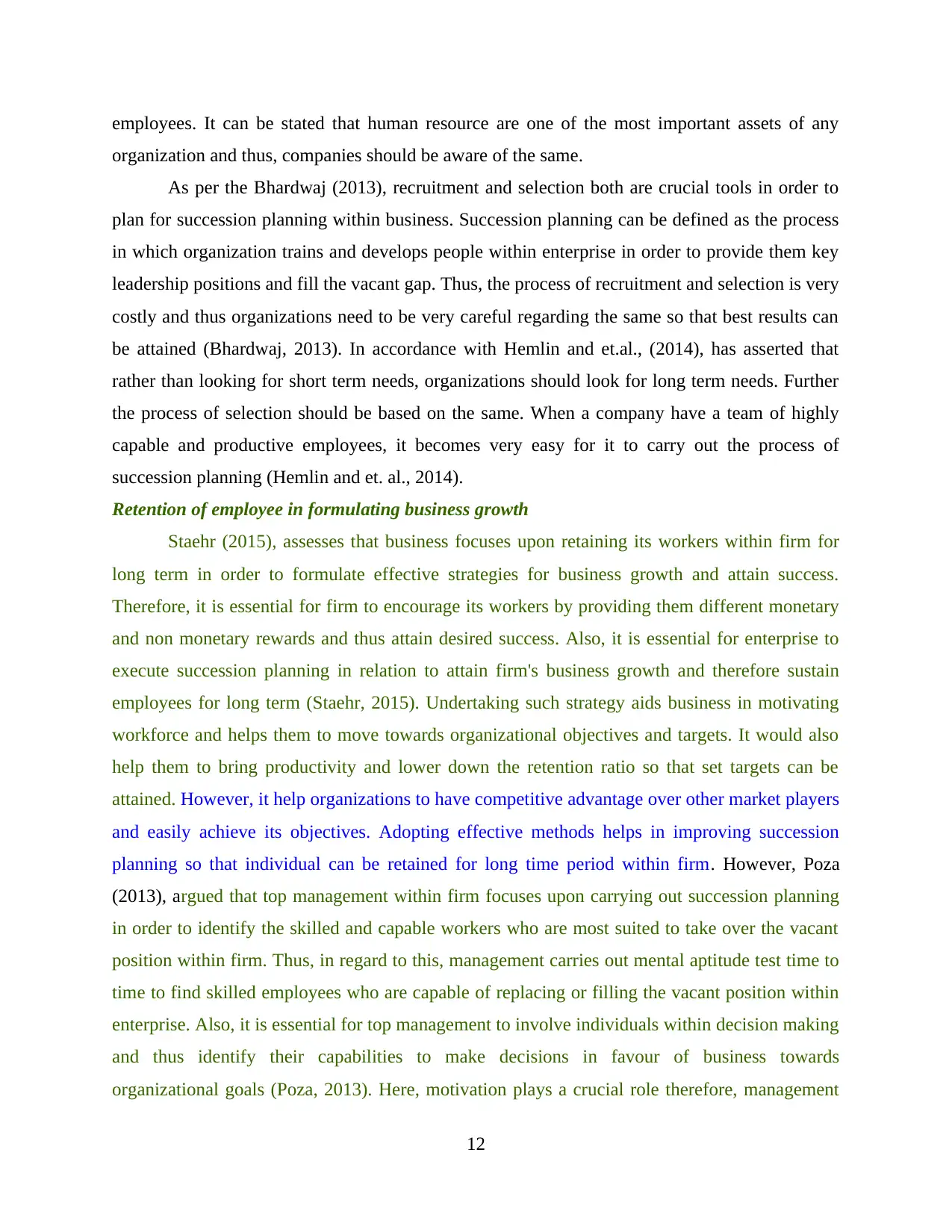
employees. It can be stated that human resource are one of the most important assets of any
organization and thus, companies should be aware of the same.
As per the Bhardwaj (2013), recruitment and selection both are crucial tools in order to
plan for succession planning within business. Succession planning can be defined as the process
in which organization trains and develops people within enterprise in order to provide them key
leadership positions and fill the vacant gap. Thus, the process of recruitment and selection is very
costly and thus organizations need to be very careful regarding the same so that best results can
be attained (Bhardwaj, 2013). In accordance with Hemlin and et.al., (2014), has asserted that
rather than looking for short term needs, organizations should look for long term needs. Further
the process of selection should be based on the same. When a company have a team of highly
capable and productive employees, it becomes very easy for it to carry out the process of
succession planning (Hemlin and et. al., 2014).
Retention of employee in formulating business growth
Staehr (2015), assesses that business focuses upon retaining its workers within firm for
long term in order to formulate effective strategies for business growth and attain success.
Therefore, it is essential for firm to encourage its workers by providing them different monetary
and non monetary rewards and thus attain desired success. Also, it is essential for enterprise to
execute succession planning in relation to attain firm's business growth and therefore sustain
employees for long term (Staehr, 2015). Undertaking such strategy aids business in motivating
workforce and helps them to move towards organizational objectives and targets. It would also
help them to bring productivity and lower down the retention ratio so that set targets can be
attained. However, it help organizations to have competitive advantage over other market players
and easily achieve its objectives. Adopting effective methods helps in improving succession
planning so that individual can be retained for long time period within firm. However, Poza
(2013), argued that top management within firm focuses upon carrying out succession planning
in order to identify the skilled and capable workers who are most suited to take over the vacant
position within firm. Thus, in regard to this, management carries out mental aptitude test time to
time to find skilled employees who are capable of replacing or filling the vacant position within
enterprise. Also, it is essential for top management to involve individuals within decision making
and thus identify their capabilities to make decisions in favour of business towards
organizational goals (Poza, 2013). Here, motivation plays a crucial role therefore, management
12
organization and thus, companies should be aware of the same.
As per the Bhardwaj (2013), recruitment and selection both are crucial tools in order to
plan for succession planning within business. Succession planning can be defined as the process
in which organization trains and develops people within enterprise in order to provide them key
leadership positions and fill the vacant gap. Thus, the process of recruitment and selection is very
costly and thus organizations need to be very careful regarding the same so that best results can
be attained (Bhardwaj, 2013). In accordance with Hemlin and et.al., (2014), has asserted that
rather than looking for short term needs, organizations should look for long term needs. Further
the process of selection should be based on the same. When a company have a team of highly
capable and productive employees, it becomes very easy for it to carry out the process of
succession planning (Hemlin and et. al., 2014).
Retention of employee in formulating business growth
Staehr (2015), assesses that business focuses upon retaining its workers within firm for
long term in order to formulate effective strategies for business growth and attain success.
Therefore, it is essential for firm to encourage its workers by providing them different monetary
and non monetary rewards and thus attain desired success. Also, it is essential for enterprise to
execute succession planning in relation to attain firm's business growth and therefore sustain
employees for long term (Staehr, 2015). Undertaking such strategy aids business in motivating
workforce and helps them to move towards organizational objectives and targets. It would also
help them to bring productivity and lower down the retention ratio so that set targets can be
attained. However, it help organizations to have competitive advantage over other market players
and easily achieve its objectives. Adopting effective methods helps in improving succession
planning so that individual can be retained for long time period within firm. However, Poza
(2013), argued that top management within firm focuses upon carrying out succession planning
in order to identify the skilled and capable workers who are most suited to take over the vacant
position within firm. Thus, in regard to this, management carries out mental aptitude test time to
time to find skilled employees who are capable of replacing or filling the vacant position within
enterprise. Also, it is essential for top management to involve individuals within decision making
and thus identify their capabilities to make decisions in favour of business towards
organizational goals (Poza, 2013). Here, motivation plays a crucial role therefore, management
12
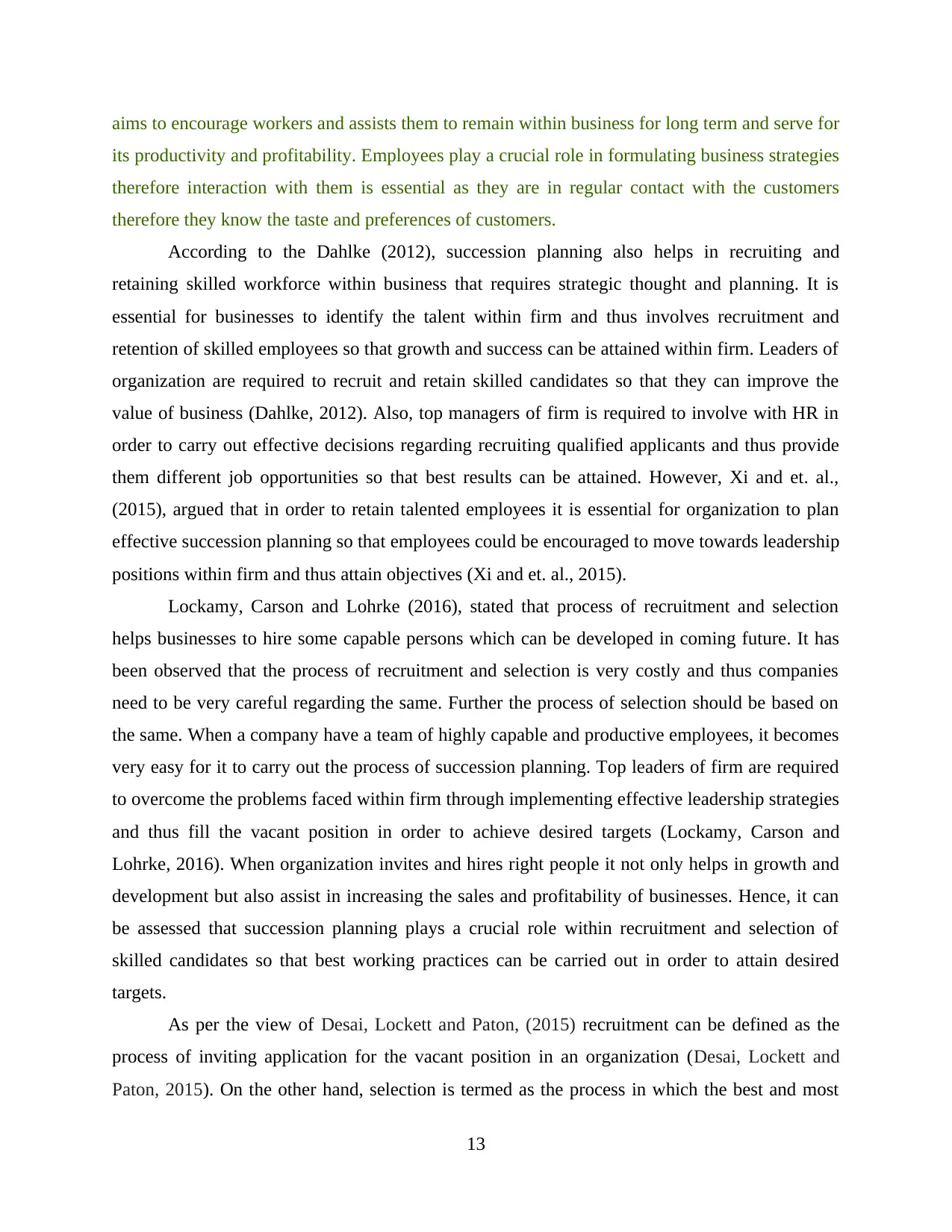
aims to encourage workers and assists them to remain within business for long term and serve for
its productivity and profitability. Employees play a crucial role in formulating business strategies
therefore interaction with them is essential as they are in regular contact with the customers
therefore they know the taste and preferences of customers.
According to the Dahlke (2012), succession planning also helps in recruiting and
retaining skilled workforce within business that requires strategic thought and planning. It is
essential for businesses to identify the talent within firm and thus involves recruitment and
retention of skilled employees so that growth and success can be attained within firm. Leaders of
organization are required to recruit and retain skilled candidates so that they can improve the
value of business (Dahlke, 2012). Also, top managers of firm is required to involve with HR in
order to carry out effective decisions regarding recruiting qualified applicants and thus provide
them different job opportunities so that best results can be attained. However, Xi and et. al.,
(2015), argued that in order to retain talented employees it is essential for organization to plan
effective succession planning so that employees could be encouraged to move towards leadership
positions within firm and thus attain objectives (Xi and et. al., 2015).
Lockamy, Carson and Lohrke (2016), stated that process of recruitment and selection
helps businesses to hire some capable persons which can be developed in coming future. It has
been observed that the process of recruitment and selection is very costly and thus companies
need to be very careful regarding the same. Further the process of selection should be based on
the same. When a company have a team of highly capable and productive employees, it becomes
very easy for it to carry out the process of succession planning. Top leaders of firm are required
to overcome the problems faced within firm through implementing effective leadership strategies
and thus fill the vacant position in order to achieve desired targets (Lockamy, Carson and
Lohrke, 2016). When organization invites and hires right people it not only helps in growth and
development but also assist in increasing the sales and profitability of businesses. Hence, it can
be assessed that succession planning plays a crucial role within recruitment and selection of
skilled candidates so that best working practices can be carried out in order to attain desired
targets.
As per the view of Desai, Lockett and Paton, (2015) recruitment can be defined as the
process of inviting application for the vacant position in an organization (Desai, Lockett and
Paton, 2015). On the other hand, selection is termed as the process in which the best and most
13
its productivity and profitability. Employees play a crucial role in formulating business strategies
therefore interaction with them is essential as they are in regular contact with the customers
therefore they know the taste and preferences of customers.
According to the Dahlke (2012), succession planning also helps in recruiting and
retaining skilled workforce within business that requires strategic thought and planning. It is
essential for businesses to identify the talent within firm and thus involves recruitment and
retention of skilled employees so that growth and success can be attained within firm. Leaders of
organization are required to recruit and retain skilled candidates so that they can improve the
value of business (Dahlke, 2012). Also, top managers of firm is required to involve with HR in
order to carry out effective decisions regarding recruiting qualified applicants and thus provide
them different job opportunities so that best results can be attained. However, Xi and et. al.,
(2015), argued that in order to retain talented employees it is essential for organization to plan
effective succession planning so that employees could be encouraged to move towards leadership
positions within firm and thus attain objectives (Xi and et. al., 2015).
Lockamy, Carson and Lohrke (2016), stated that process of recruitment and selection
helps businesses to hire some capable persons which can be developed in coming future. It has
been observed that the process of recruitment and selection is very costly and thus companies
need to be very careful regarding the same. Further the process of selection should be based on
the same. When a company have a team of highly capable and productive employees, it becomes
very easy for it to carry out the process of succession planning. Top leaders of firm are required
to overcome the problems faced within firm through implementing effective leadership strategies
and thus fill the vacant position in order to achieve desired targets (Lockamy, Carson and
Lohrke, 2016). When organization invites and hires right people it not only helps in growth and
development but also assist in increasing the sales and profitability of businesses. Hence, it can
be assessed that succession planning plays a crucial role within recruitment and selection of
skilled candidates so that best working practices can be carried out in order to attain desired
targets.
As per the view of Desai, Lockett and Paton, (2015) recruitment can be defined as the
process of inviting application for the vacant position in an organization (Desai, Lockett and
Paton, 2015). On the other hand, selection is termed as the process in which the best and most
13
Secure Best Marks with AI Grader
Need help grading? Try our AI Grader for instant feedback on your assignments.
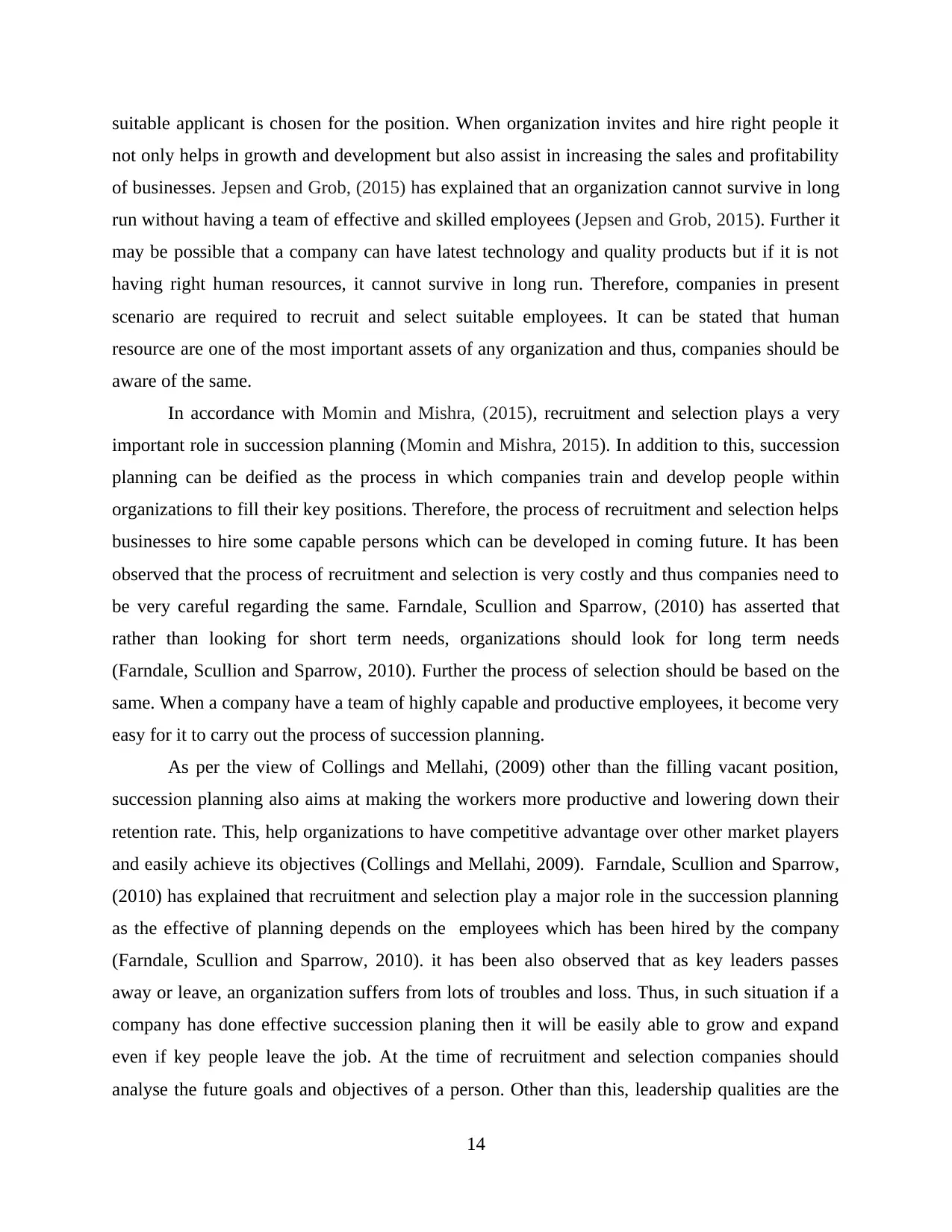
suitable applicant is chosen for the position. When organization invites and hire right people it
not only helps in growth and development but also assist in increasing the sales and profitability
of businesses. Jepsen and Grob, (2015) has explained that an organization cannot survive in long
run without having a team of effective and skilled employees (Jepsen and Grob, 2015). Further it
may be possible that a company can have latest technology and quality products but if it is not
having right human resources, it cannot survive in long run. Therefore, companies in present
scenario are required to recruit and select suitable employees. It can be stated that human
resource are one of the most important assets of any organization and thus, companies should be
aware of the same.
In accordance with Momin and Mishra, (2015), recruitment and selection plays a very
important role in succession planning (Momin and Mishra, 2015). In addition to this, succession
planning can be deified as the process in which companies train and develop people within
organizations to fill their key positions. Therefore, the process of recruitment and selection helps
businesses to hire some capable persons which can be developed in coming future. It has been
observed that the process of recruitment and selection is very costly and thus companies need to
be very careful regarding the same. Farndale, Scullion and Sparrow, (2010) has asserted that
rather than looking for short term needs, organizations should look for long term needs
(Farndale, Scullion and Sparrow, 2010). Further the process of selection should be based on the
same. When a company have a team of highly capable and productive employees, it become very
easy for it to carry out the process of succession planning.
As per the view of Collings and Mellahi, (2009) other than the filling vacant position,
succession planning also aims at making the workers more productive and lowering down their
retention rate. This, help organizations to have competitive advantage over other market players
and easily achieve its objectives (Collings and Mellahi, 2009). Farndale, Scullion and Sparrow,
(2010) has explained that recruitment and selection play a major role in the succession planning
as the effective of planning depends on the employees which has been hired by the company
(Farndale, Scullion and Sparrow, 2010). it has been also observed that as key leaders passes
away or leave, an organization suffers from lots of troubles and loss. Thus, in such situation if a
company has done effective succession planing then it will be easily able to grow and expand
even if key people leave the job. At the time of recruitment and selection companies should
analyse the future goals and objectives of a person. Other than this, leadership qualities are the
14
not only helps in growth and development but also assist in increasing the sales and profitability
of businesses. Jepsen and Grob, (2015) has explained that an organization cannot survive in long
run without having a team of effective and skilled employees (Jepsen and Grob, 2015). Further it
may be possible that a company can have latest technology and quality products but if it is not
having right human resources, it cannot survive in long run. Therefore, companies in present
scenario are required to recruit and select suitable employees. It can be stated that human
resource are one of the most important assets of any organization and thus, companies should be
aware of the same.
In accordance with Momin and Mishra, (2015), recruitment and selection plays a very
important role in succession planning (Momin and Mishra, 2015). In addition to this, succession
planning can be deified as the process in which companies train and develop people within
organizations to fill their key positions. Therefore, the process of recruitment and selection helps
businesses to hire some capable persons which can be developed in coming future. It has been
observed that the process of recruitment and selection is very costly and thus companies need to
be very careful regarding the same. Farndale, Scullion and Sparrow, (2010) has asserted that
rather than looking for short term needs, organizations should look for long term needs
(Farndale, Scullion and Sparrow, 2010). Further the process of selection should be based on the
same. When a company have a team of highly capable and productive employees, it become very
easy for it to carry out the process of succession planning.
As per the view of Collings and Mellahi, (2009) other than the filling vacant position,
succession planning also aims at making the workers more productive and lowering down their
retention rate. This, help organizations to have competitive advantage over other market players
and easily achieve its objectives (Collings and Mellahi, 2009). Farndale, Scullion and Sparrow,
(2010) has explained that recruitment and selection play a major role in the succession planning
as the effective of planning depends on the employees which has been hired by the company
(Farndale, Scullion and Sparrow, 2010). it has been also observed that as key leaders passes
away or leave, an organization suffers from lots of troubles and loss. Thus, in such situation if a
company has done effective succession planing then it will be easily able to grow and expand
even if key people leave the job. At the time of recruitment and selection companies should
analyse the future goals and objectives of a person. Other than this, leadership qualities are the
14
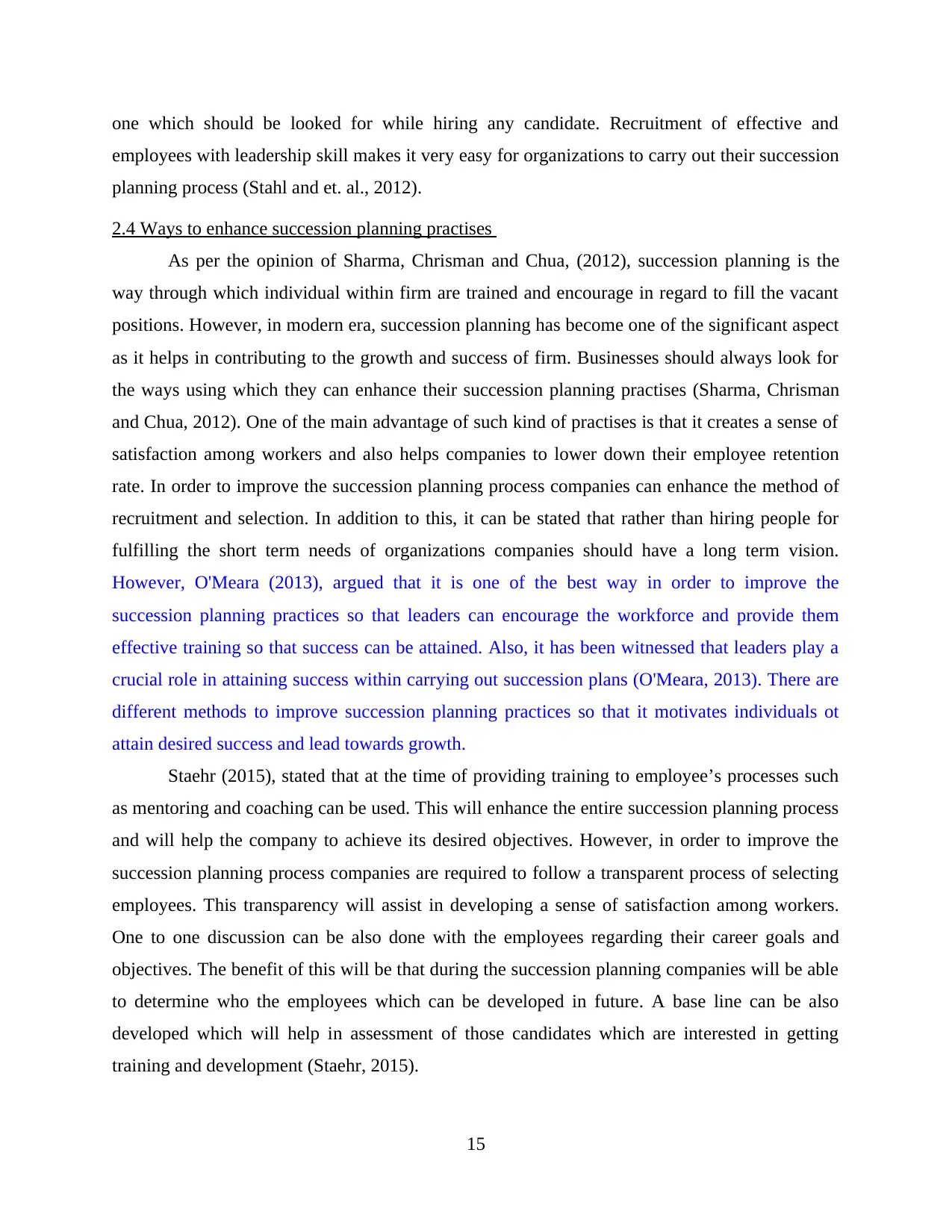
one which should be looked for while hiring any candidate. Recruitment of effective and
employees with leadership skill makes it very easy for organizations to carry out their succession
planning process (Stahl and et. al., 2012).
2.4 Ways to enhance succession planning practises
As per the opinion of Sharma, Chrisman and Chua, (2012), succession planning is the
way through which individual within firm are trained and encourage in regard to fill the vacant
positions. However, in modern era, succession planning has become one of the significant aspect
as it helps in contributing to the growth and success of firm. Businesses should always look for
the ways using which they can enhance their succession planning practises (Sharma, Chrisman
and Chua, 2012). One of the main advantage of such kind of practises is that it creates a sense of
satisfaction among workers and also helps companies to lower down their employee retention
rate. In order to improve the succession planning process companies can enhance the method of
recruitment and selection. In addition to this, it can be stated that rather than hiring people for
fulfilling the short term needs of organizations companies should have a long term vision.
However, O'Meara (2013), argued that it is one of the best way in order to improve the
succession planning practices so that leaders can encourage the workforce and provide them
effective training so that success can be attained. Also, it has been witnessed that leaders play a
crucial role in attaining success within carrying out succession plans (O'Meara, 2013). There are
different methods to improve succession planning practices so that it motivates individuals ot
attain desired success and lead towards growth.
Staehr (2015), stated that at the time of providing training to employee’s processes such
as mentoring and coaching can be used. This will enhance the entire succession planning process
and will help the company to achieve its desired objectives. However, in order to improve the
succession planning process companies are required to follow a transparent process of selecting
employees. This transparency will assist in developing a sense of satisfaction among workers.
One to one discussion can be also done with the employees regarding their career goals and
objectives. The benefit of this will be that during the succession planning companies will be able
to determine who the employees which can be developed in future. A base line can be also
developed which will help in assessment of those candidates which are interested in getting
training and development (Staehr, 2015).
15
employees with leadership skill makes it very easy for organizations to carry out their succession
planning process (Stahl and et. al., 2012).
2.4 Ways to enhance succession planning practises
As per the opinion of Sharma, Chrisman and Chua, (2012), succession planning is the
way through which individual within firm are trained and encourage in regard to fill the vacant
positions. However, in modern era, succession planning has become one of the significant aspect
as it helps in contributing to the growth and success of firm. Businesses should always look for
the ways using which they can enhance their succession planning practises (Sharma, Chrisman
and Chua, 2012). One of the main advantage of such kind of practises is that it creates a sense of
satisfaction among workers and also helps companies to lower down their employee retention
rate. In order to improve the succession planning process companies can enhance the method of
recruitment and selection. In addition to this, it can be stated that rather than hiring people for
fulfilling the short term needs of organizations companies should have a long term vision.
However, O'Meara (2013), argued that it is one of the best way in order to improve the
succession planning practices so that leaders can encourage the workforce and provide them
effective training so that success can be attained. Also, it has been witnessed that leaders play a
crucial role in attaining success within carrying out succession plans (O'Meara, 2013). There are
different methods to improve succession planning practices so that it motivates individuals ot
attain desired success and lead towards growth.
Staehr (2015), stated that at the time of providing training to employee’s processes such
as mentoring and coaching can be used. This will enhance the entire succession planning process
and will help the company to achieve its desired objectives. However, in order to improve the
succession planning process companies are required to follow a transparent process of selecting
employees. This transparency will assist in developing a sense of satisfaction among workers.
One to one discussion can be also done with the employees regarding their career goals and
objectives. The benefit of this will be that during the succession planning companies will be able
to determine who the employees which can be developed in future. A base line can be also
developed which will help in assessment of those candidates which are interested in getting
training and development (Staehr, 2015).
15
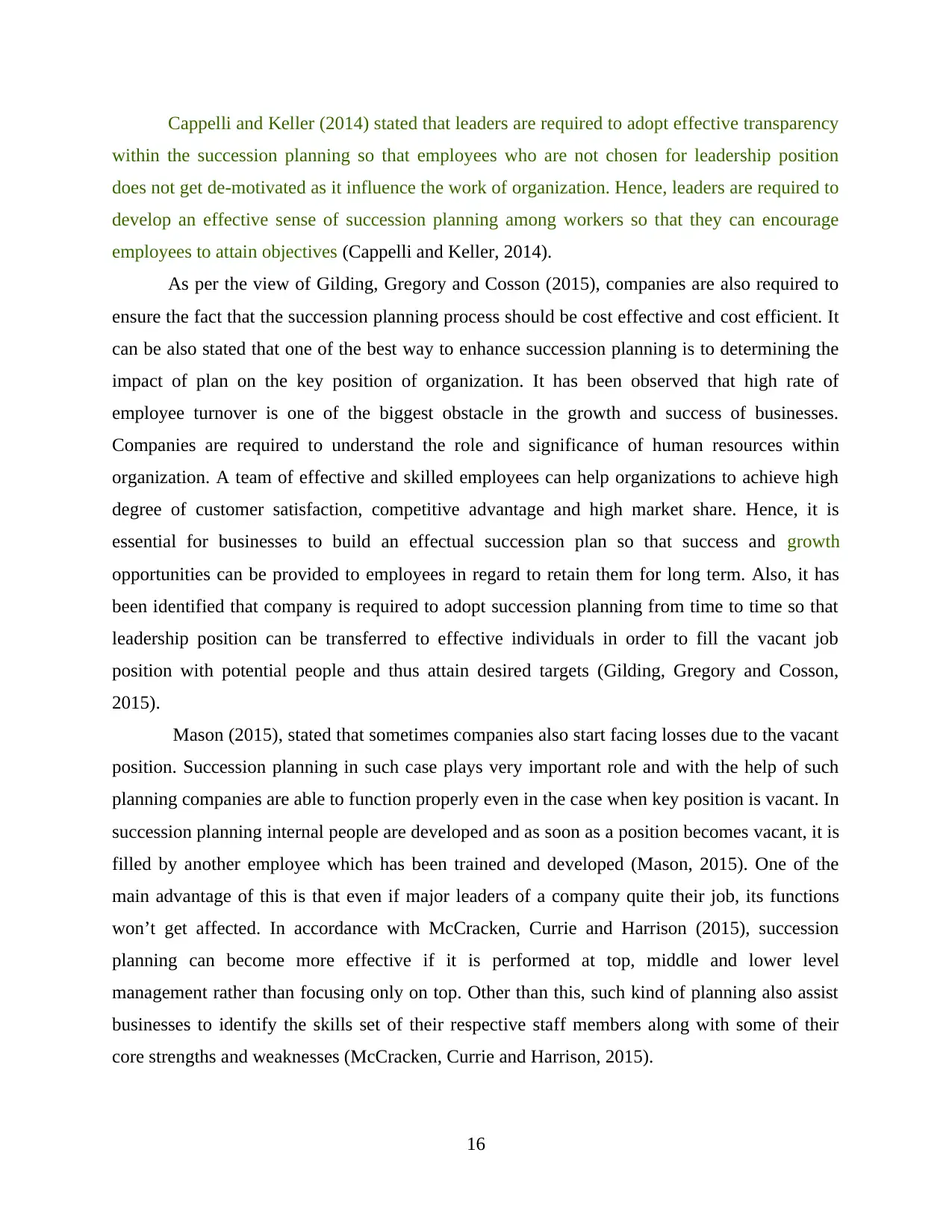
Cappelli and Keller (2014) stated that leaders are required to adopt effective transparency
within the succession planning so that employees who are not chosen for leadership position
does not get de-motivated as it influence the work of organization. Hence, leaders are required to
develop an effective sense of succession planning among workers so that they can encourage
employees to attain objectives (Cappelli and Keller, 2014).
As per the view of Gilding, Gregory and Cosson (2015), companies are also required to
ensure the fact that the succession planning process should be cost effective and cost efficient. It
can be also stated that one of the best way to enhance succession planning is to determining the
impact of plan on the key position of organization. It has been observed that high rate of
employee turnover is one of the biggest obstacle in the growth and success of businesses.
Companies are required to understand the role and significance of human resources within
organization. A team of effective and skilled employees can help organizations to achieve high
degree of customer satisfaction, competitive advantage and high market share. Hence, it is
essential for businesses to build an effectual succession plan so that success and growth
opportunities can be provided to employees in regard to retain them for long term. Also, it has
been identified that company is required to adopt succession planning from time to time so that
leadership position can be transferred to effective individuals in order to fill the vacant job
position with potential people and thus attain desired targets (Gilding, Gregory and Cosson,
2015).
Mason (2015), stated that sometimes companies also start facing losses due to the vacant
position. Succession planning in such case plays very important role and with the help of such
planning companies are able to function properly even in the case when key position is vacant. In
succession planning internal people are developed and as soon as a position becomes vacant, it is
filled by another employee which has been trained and developed (Mason, 2015). One of the
main advantage of this is that even if major leaders of a company quite their job, its functions
won’t get affected. In accordance with McCracken, Currie and Harrison (2015), succession
planning can become more effective if it is performed at top, middle and lower level
management rather than focusing only on top. Other than this, such kind of planning also assist
businesses to identify the skills set of their respective staff members along with some of their
core strengths and weaknesses (McCracken, Currie and Harrison, 2015).
16
within the succession planning so that employees who are not chosen for leadership position
does not get de-motivated as it influence the work of organization. Hence, leaders are required to
develop an effective sense of succession planning among workers so that they can encourage
employees to attain objectives (Cappelli and Keller, 2014).
As per the view of Gilding, Gregory and Cosson (2015), companies are also required to
ensure the fact that the succession planning process should be cost effective and cost efficient. It
can be also stated that one of the best way to enhance succession planning is to determining the
impact of plan on the key position of organization. It has been observed that high rate of
employee turnover is one of the biggest obstacle in the growth and success of businesses.
Companies are required to understand the role and significance of human resources within
organization. A team of effective and skilled employees can help organizations to achieve high
degree of customer satisfaction, competitive advantage and high market share. Hence, it is
essential for businesses to build an effectual succession plan so that success and growth
opportunities can be provided to employees in regard to retain them for long term. Also, it has
been identified that company is required to adopt succession planning from time to time so that
leadership position can be transferred to effective individuals in order to fill the vacant job
position with potential people and thus attain desired targets (Gilding, Gregory and Cosson,
2015).
Mason (2015), stated that sometimes companies also start facing losses due to the vacant
position. Succession planning in such case plays very important role and with the help of such
planning companies are able to function properly even in the case when key position is vacant. In
succession planning internal people are developed and as soon as a position becomes vacant, it is
filled by another employee which has been trained and developed (Mason, 2015). One of the
main advantage of this is that even if major leaders of a company quite their job, its functions
won’t get affected. In accordance with McCracken, Currie and Harrison (2015), succession
planning can become more effective if it is performed at top, middle and lower level
management rather than focusing only on top. Other than this, such kind of planning also assist
businesses to identify the skills set of their respective staff members along with some of their
core strengths and weaknesses (McCracken, Currie and Harrison, 2015).
16
Paraphrase This Document
Need a fresh take? Get an instant paraphrase of this document with our AI Paraphraser
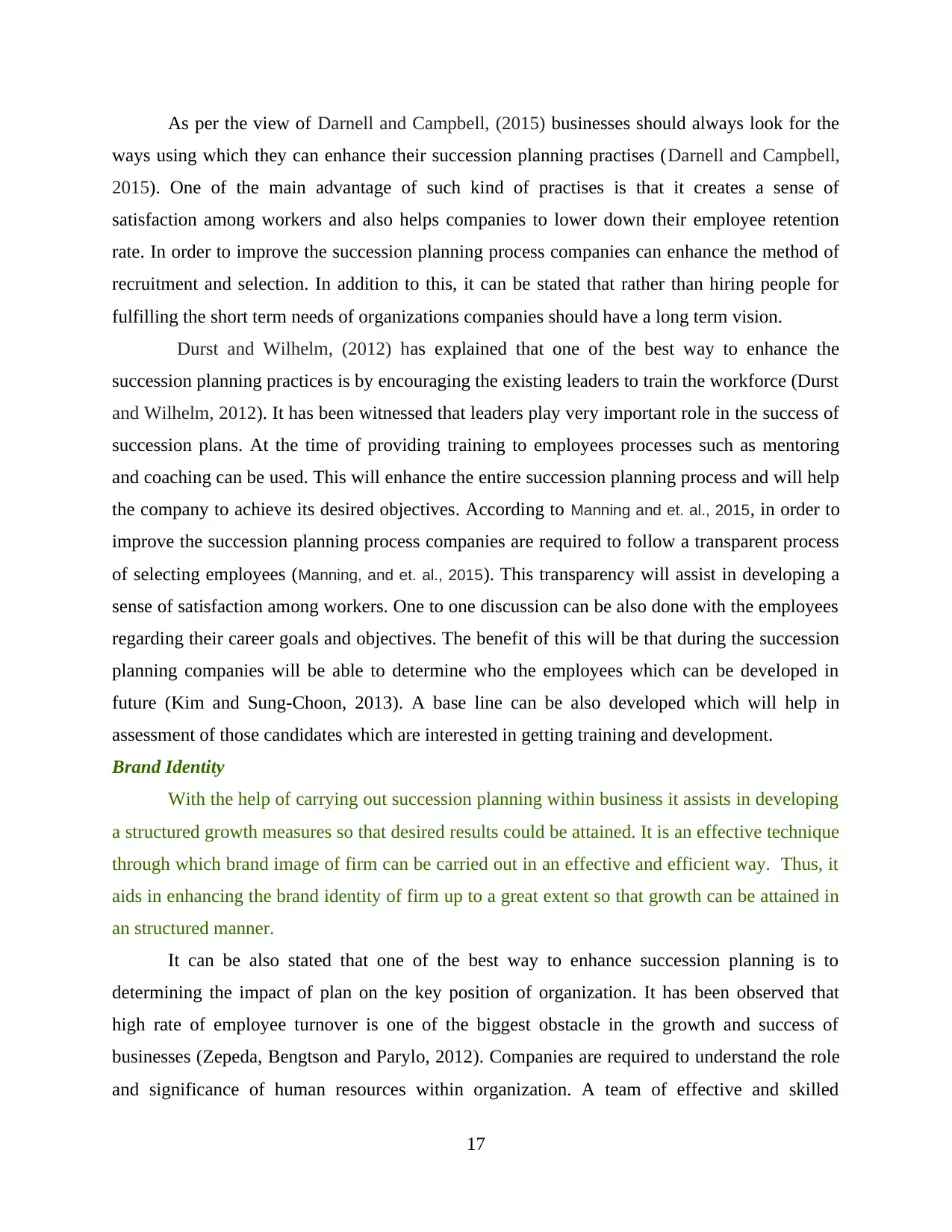
As per the view of Darnell and Campbell, (2015) businesses should always look for the
ways using which they can enhance their succession planning practises (Darnell and Campbell,
2015). One of the main advantage of such kind of practises is that it creates a sense of
satisfaction among workers and also helps companies to lower down their employee retention
rate. In order to improve the succession planning process companies can enhance the method of
recruitment and selection. In addition to this, it can be stated that rather than hiring people for
fulfilling the short term needs of organizations companies should have a long term vision.
Durst and Wilhelm, (2012) has explained that one of the best way to enhance the
succession planning practices is by encouraging the existing leaders to train the workforce (Durst
and Wilhelm, 2012). It has been witnessed that leaders play very important role in the success of
succession plans. At the time of providing training to employees processes such as mentoring
and coaching can be used. This will enhance the entire succession planning process and will help
the company to achieve its desired objectives. According to Manning and et. al., 2015, in order to
improve the succession planning process companies are required to follow a transparent process
of selecting employees (Manning, and et. al., 2015). This transparency will assist in developing a
sense of satisfaction among workers. One to one discussion can be also done with the employees
regarding their career goals and objectives. The benefit of this will be that during the succession
planning companies will be able to determine who the employees which can be developed in
future (Kim and Sung-Choon, 2013). A base line can be also developed which will help in
assessment of those candidates which are interested in getting training and development.
Brand Identity
With the help of carrying out succession planning within business it assists in developing
a structured growth measures so that desired results could be attained. It is an effective technique
through which brand image of firm can be carried out in an effective and efficient way. Thus, it
aids in enhancing the brand identity of firm up to a great extent so that growth can be attained in
an structured manner.
It can be also stated that one of the best way to enhance succession planning is to
determining the impact of plan on the key position of organization. It has been observed that
high rate of employee turnover is one of the biggest obstacle in the growth and success of
businesses (Zepeda, Bengtson and Parylo, 2012). Companies are required to understand the role
and significance of human resources within organization. A team of effective and skilled
17
ways using which they can enhance their succession planning practises (Darnell and Campbell,
2015). One of the main advantage of such kind of practises is that it creates a sense of
satisfaction among workers and also helps companies to lower down their employee retention
rate. In order to improve the succession planning process companies can enhance the method of
recruitment and selection. In addition to this, it can be stated that rather than hiring people for
fulfilling the short term needs of organizations companies should have a long term vision.
Durst and Wilhelm, (2012) has explained that one of the best way to enhance the
succession planning practices is by encouraging the existing leaders to train the workforce (Durst
and Wilhelm, 2012). It has been witnessed that leaders play very important role in the success of
succession plans. At the time of providing training to employees processes such as mentoring
and coaching can be used. This will enhance the entire succession planning process and will help
the company to achieve its desired objectives. According to Manning and et. al., 2015, in order to
improve the succession planning process companies are required to follow a transparent process
of selecting employees (Manning, and et. al., 2015). This transparency will assist in developing a
sense of satisfaction among workers. One to one discussion can be also done with the employees
regarding their career goals and objectives. The benefit of this will be that during the succession
planning companies will be able to determine who the employees which can be developed in
future (Kim and Sung-Choon, 2013). A base line can be also developed which will help in
assessment of those candidates which are interested in getting training and development.
Brand Identity
With the help of carrying out succession planning within business it assists in developing
a structured growth measures so that desired results could be attained. It is an effective technique
through which brand image of firm can be carried out in an effective and efficient way. Thus, it
aids in enhancing the brand identity of firm up to a great extent so that growth can be attained in
an structured manner.
It can be also stated that one of the best way to enhance succession planning is to
determining the impact of plan on the key position of organization. It has been observed that
high rate of employee turnover is one of the biggest obstacle in the growth and success of
businesses (Zepeda, Bengtson and Parylo, 2012). Companies are required to understand the role
and significance of human resources within organization. A team of effective and skilled
17
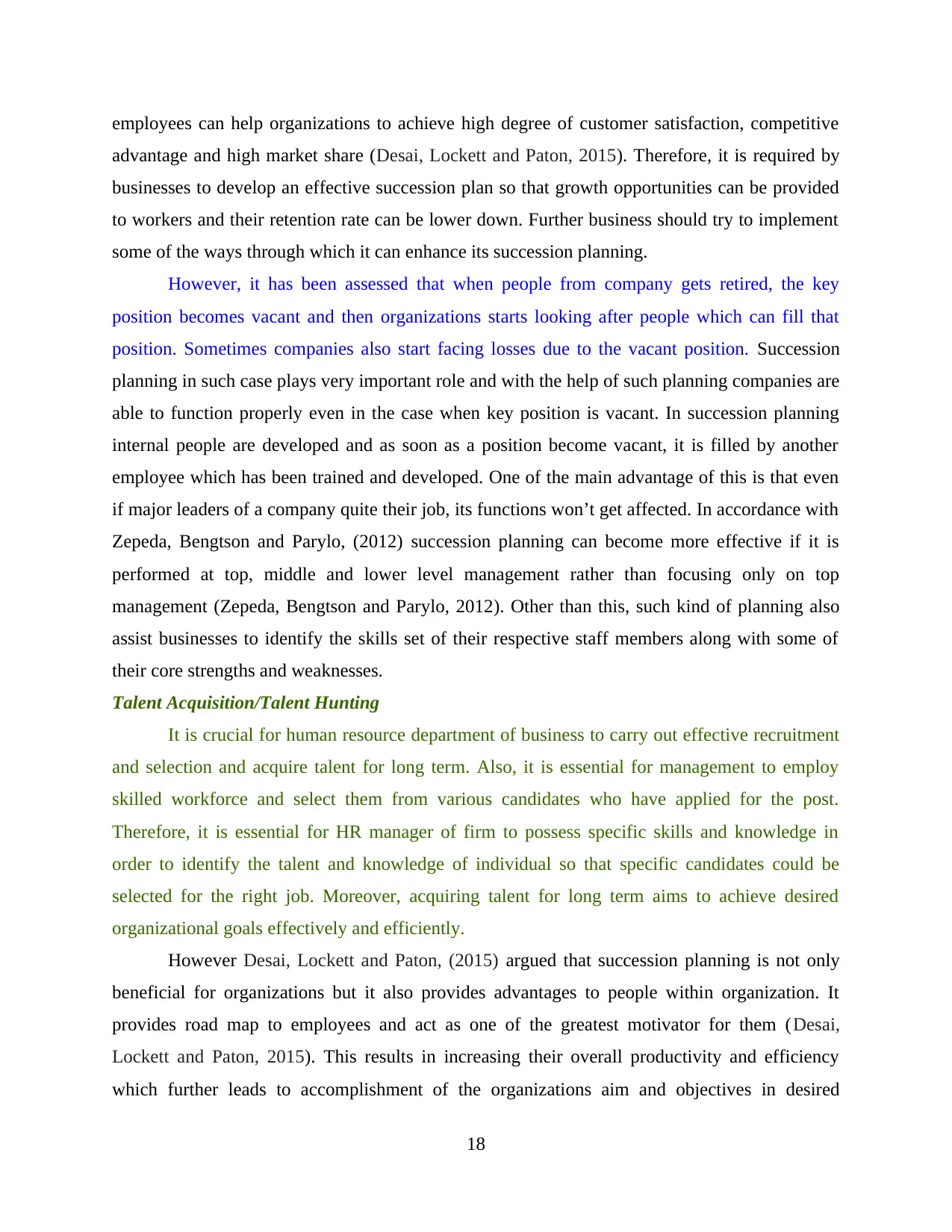
employees can help organizations to achieve high degree of customer satisfaction, competitive
advantage and high market share (Desai, Lockett and Paton, 2015). Therefore, it is required by
businesses to develop an effective succession plan so that growth opportunities can be provided
to workers and their retention rate can be lower down. Further business should try to implement
some of the ways through which it can enhance its succession planning.
However, it has been assessed that when people from company gets retired, the key
position becomes vacant and then organizations starts looking after people which can fill that
position. Sometimes companies also start facing losses due to the vacant position. Succession
planning in such case plays very important role and with the help of such planning companies are
able to function properly even in the case when key position is vacant. In succession planning
internal people are developed and as soon as a position become vacant, it is filled by another
employee which has been trained and developed. One of the main advantage of this is that even
if major leaders of a company quite their job, its functions won’t get affected. In accordance with
Zepeda, Bengtson and Parylo, (2012) succession planning can become more effective if it is
performed at top, middle and lower level management rather than focusing only on top
management (Zepeda, Bengtson and Parylo, 2012). Other than this, such kind of planning also
assist businesses to identify the skills set of their respective staff members along with some of
their core strengths and weaknesses.
Talent Acquisition/Talent Hunting
It is crucial for human resource department of business to carry out effective recruitment
and selection and acquire talent for long term. Also, it is essential for management to employ
skilled workforce and select them from various candidates who have applied for the post.
Therefore, it is essential for HR manager of firm to possess specific skills and knowledge in
order to identify the talent and knowledge of individual so that specific candidates could be
selected for the right job. Moreover, acquiring talent for long term aims to achieve desired
organizational goals effectively and efficiently.
However Desai, Lockett and Paton, (2015) argued that succession planning is not only
beneficial for organizations but it also provides advantages to people within organization. It
provides road map to employees and act as one of the greatest motivator for them (Desai,
Lockett and Paton, 2015). This results in increasing their overall productivity and efficiency
which further leads to accomplishment of the organizations aim and objectives in desired
18
advantage and high market share (Desai, Lockett and Paton, 2015). Therefore, it is required by
businesses to develop an effective succession plan so that growth opportunities can be provided
to workers and their retention rate can be lower down. Further business should try to implement
some of the ways through which it can enhance its succession planning.
However, it has been assessed that when people from company gets retired, the key
position becomes vacant and then organizations starts looking after people which can fill that
position. Sometimes companies also start facing losses due to the vacant position. Succession
planning in such case plays very important role and with the help of such planning companies are
able to function properly even in the case when key position is vacant. In succession planning
internal people are developed and as soon as a position become vacant, it is filled by another
employee which has been trained and developed. One of the main advantage of this is that even
if major leaders of a company quite their job, its functions won’t get affected. In accordance with
Zepeda, Bengtson and Parylo, (2012) succession planning can become more effective if it is
performed at top, middle and lower level management rather than focusing only on top
management (Zepeda, Bengtson and Parylo, 2012). Other than this, such kind of planning also
assist businesses to identify the skills set of their respective staff members along with some of
their core strengths and weaknesses.
Talent Acquisition/Talent Hunting
It is crucial for human resource department of business to carry out effective recruitment
and selection and acquire talent for long term. Also, it is essential for management to employ
skilled workforce and select them from various candidates who have applied for the post.
Therefore, it is essential for HR manager of firm to possess specific skills and knowledge in
order to identify the talent and knowledge of individual so that specific candidates could be
selected for the right job. Moreover, acquiring talent for long term aims to achieve desired
organizational goals effectively and efficiently.
However Desai, Lockett and Paton, (2015) argued that succession planning is not only
beneficial for organizations but it also provides advantages to people within organization. It
provides road map to employees and act as one of the greatest motivator for them (Desai,
Lockett and Paton, 2015). This results in increasing their overall productivity and efficiency
which further leads to accomplishment of the organizations aim and objectives in desired
18
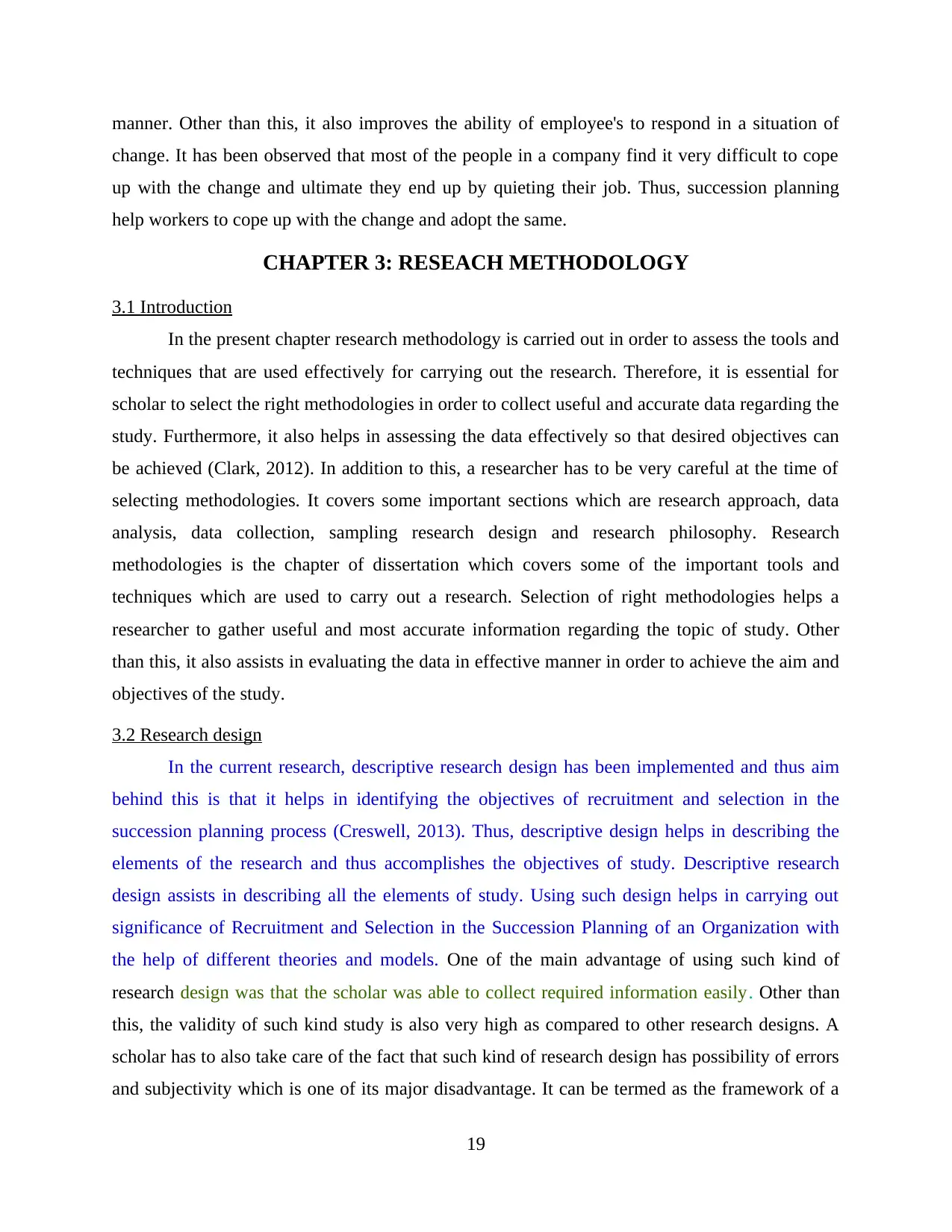
manner. Other than this, it also improves the ability of employee's to respond in a situation of
change. It has been observed that most of the people in a company find it very difficult to cope
up with the change and ultimate they end up by quieting their job. Thus, succession planning
help workers to cope up with the change and adopt the same.
CHAPTER 3: RESEACH METHODOLOGY
3.1 Introduction
In the present chapter research methodology is carried out in order to assess the tools and
techniques that are used effectively for carrying out the research. Therefore, it is essential for
scholar to select the right methodologies in order to collect useful and accurate data regarding the
study. Furthermore, it also helps in assessing the data effectively so that desired objectives can
be achieved (Clark, 2012). In addition to this, a researcher has to be very careful at the time of
selecting methodologies. It covers some important sections which are research approach, data
analysis, data collection, sampling research design and research philosophy. Research
methodologies is the chapter of dissertation which covers some of the important tools and
techniques which are used to carry out a research. Selection of right methodologies helps a
researcher to gather useful and most accurate information regarding the topic of study. Other
than this, it also assists in evaluating the data in effective manner in order to achieve the aim and
objectives of the study.
3.2 Research design
In the current research, descriptive research design has been implemented and thus aim
behind this is that it helps in identifying the objectives of recruitment and selection in the
succession planning process (Creswell, 2013). Thus, descriptive design helps in describing the
elements of the research and thus accomplishes the objectives of study. Descriptive research
design assists in describing all the elements of study. Using such design helps in carrying out
significance of Recruitment and Selection in the Succession Planning of an Organization with
the help of different theories and models. One of the main advantage of using such kind of
research design was that the scholar was able to collect required information easily. Other than
this, the validity of such kind study is also very high as compared to other research designs. A
scholar has to also take care of the fact that such kind of research design has possibility of errors
and subjectivity which is one of its major disadvantage. It can be termed as the framework of a
19
change. It has been observed that most of the people in a company find it very difficult to cope
up with the change and ultimate they end up by quieting their job. Thus, succession planning
help workers to cope up with the change and adopt the same.
CHAPTER 3: RESEACH METHODOLOGY
3.1 Introduction
In the present chapter research methodology is carried out in order to assess the tools and
techniques that are used effectively for carrying out the research. Therefore, it is essential for
scholar to select the right methodologies in order to collect useful and accurate data regarding the
study. Furthermore, it also helps in assessing the data effectively so that desired objectives can
be achieved (Clark, 2012). In addition to this, a researcher has to be very careful at the time of
selecting methodologies. It covers some important sections which are research approach, data
analysis, data collection, sampling research design and research philosophy. Research
methodologies is the chapter of dissertation which covers some of the important tools and
techniques which are used to carry out a research. Selection of right methodologies helps a
researcher to gather useful and most accurate information regarding the topic of study. Other
than this, it also assists in evaluating the data in effective manner in order to achieve the aim and
objectives of the study.
3.2 Research design
In the current research, descriptive research design has been implemented and thus aim
behind this is that it helps in identifying the objectives of recruitment and selection in the
succession planning process (Creswell, 2013). Thus, descriptive design helps in describing the
elements of the research and thus accomplishes the objectives of study. Descriptive research
design assists in describing all the elements of study. Using such design helps in carrying out
significance of Recruitment and Selection in the Succession Planning of an Organization with
the help of different theories and models. One of the main advantage of using such kind of
research design was that the scholar was able to collect required information easily. Other than
this, the validity of such kind study is also very high as compared to other research designs. A
scholar has to also take care of the fact that such kind of research design has possibility of errors
and subjectivity which is one of its major disadvantage. It can be termed as the framework of a
19
Secure Best Marks with AI Grader
Need help grading? Try our AI Grader for instant feedback on your assignments.
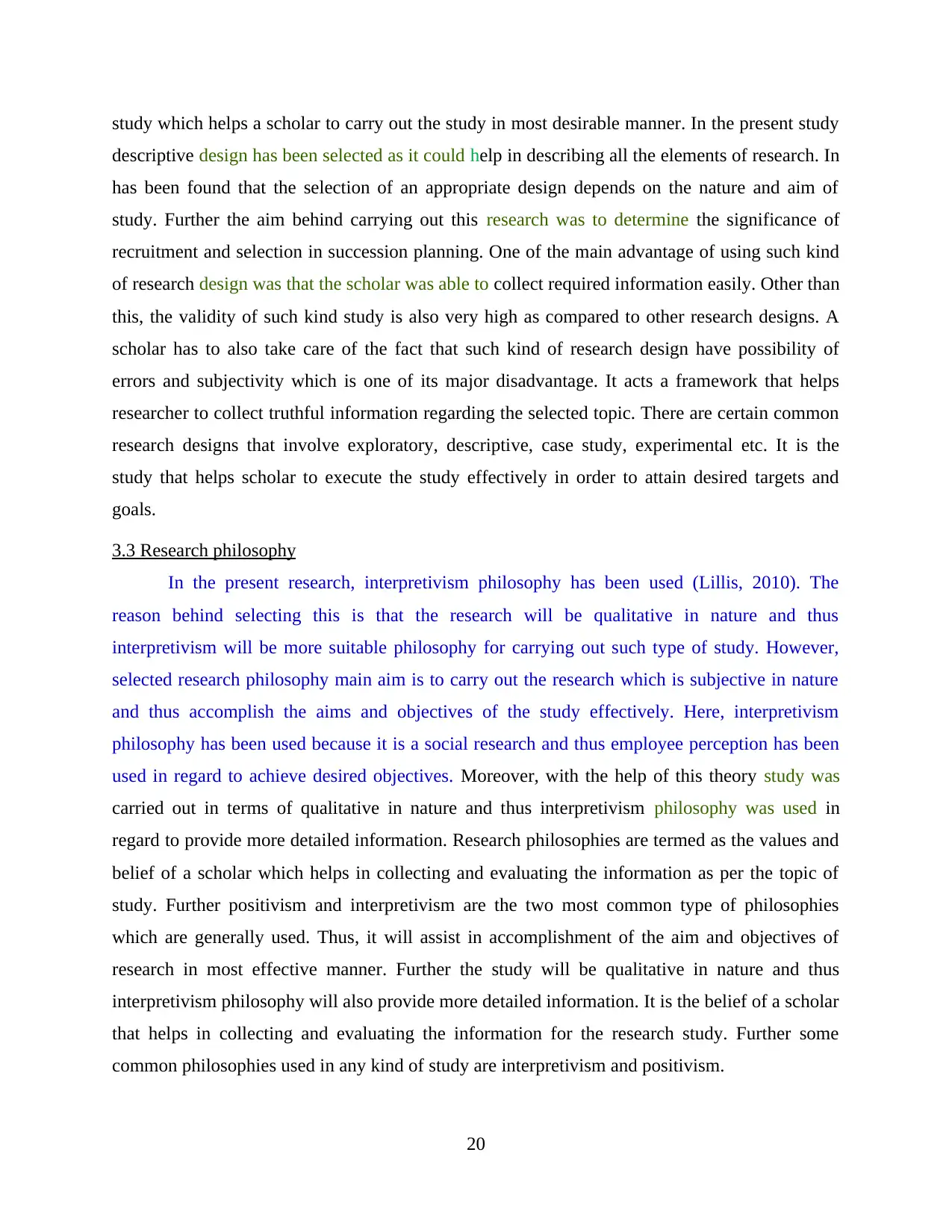
study which helps a scholar to carry out the study in most desirable manner. In the present study
descriptive design has been selected as it could help in describing all the elements of research. In
has been found that the selection of an appropriate design depends on the nature and aim of
study. Further the aim behind carrying out this research was to determine the significance of
recruitment and selection in succession planning. One of the main advantage of using such kind
of research design was that the scholar was able to collect required information easily. Other than
this, the validity of such kind study is also very high as compared to other research designs. A
scholar has to also take care of the fact that such kind of research design have possibility of
errors and subjectivity which is one of its major disadvantage. It acts a framework that helps
researcher to collect truthful information regarding the selected topic. There are certain common
research designs that involve exploratory, descriptive, case study, experimental etc. It is the
study that helps scholar to execute the study effectively in order to attain desired targets and
goals.
3.3 Research philosophy
In the present research, interpretivism philosophy has been used (Lillis, 2010). The
reason behind selecting this is that the research will be qualitative in nature and thus
interpretivism will be more suitable philosophy for carrying out such type of study. However,
selected research philosophy main aim is to carry out the research which is subjective in nature
and thus accomplish the aims and objectives of the study effectively. Here, interpretivism
philosophy has been used because it is a social research and thus employee perception has been
used in regard to achieve desired objectives. Moreover, with the help of this theory study was
carried out in terms of qualitative in nature and thus interpretivism philosophy was used in
regard to provide more detailed information. Research philosophies are termed as the values and
belief of a scholar which helps in collecting and evaluating the information as per the topic of
study. Further positivism and interpretivism are the two most common type of philosophies
which are generally used. Thus, it will assist in accomplishment of the aim and objectives of
research in most effective manner. Further the study will be qualitative in nature and thus
interpretivism philosophy will also provide more detailed information. It is the belief of a scholar
that helps in collecting and evaluating the information for the research study. Further some
common philosophies used in any kind of study are interpretivism and positivism.
20
descriptive design has been selected as it could help in describing all the elements of research. In
has been found that the selection of an appropriate design depends on the nature and aim of
study. Further the aim behind carrying out this research was to determine the significance of
recruitment and selection in succession planning. One of the main advantage of using such kind
of research design was that the scholar was able to collect required information easily. Other than
this, the validity of such kind study is also very high as compared to other research designs. A
scholar has to also take care of the fact that such kind of research design have possibility of
errors and subjectivity which is one of its major disadvantage. It acts a framework that helps
researcher to collect truthful information regarding the selected topic. There are certain common
research designs that involve exploratory, descriptive, case study, experimental etc. It is the
study that helps scholar to execute the study effectively in order to attain desired targets and
goals.
3.3 Research philosophy
In the present research, interpretivism philosophy has been used (Lillis, 2010). The
reason behind selecting this is that the research will be qualitative in nature and thus
interpretivism will be more suitable philosophy for carrying out such type of study. However,
selected research philosophy main aim is to carry out the research which is subjective in nature
and thus accomplish the aims and objectives of the study effectively. Here, interpretivism
philosophy has been used because it is a social research and thus employee perception has been
used in regard to achieve desired objectives. Moreover, with the help of this theory study was
carried out in terms of qualitative in nature and thus interpretivism philosophy was used in
regard to provide more detailed information. Research philosophies are termed as the values and
belief of a scholar which helps in collecting and evaluating the information as per the topic of
study. Further positivism and interpretivism are the two most common type of philosophies
which are generally used. Thus, it will assist in accomplishment of the aim and objectives of
research in most effective manner. Further the study will be qualitative in nature and thus
interpretivism philosophy will also provide more detailed information. It is the belief of a scholar
that helps in collecting and evaluating the information for the research study. Further some
common philosophies used in any kind of study are interpretivism and positivism.
20
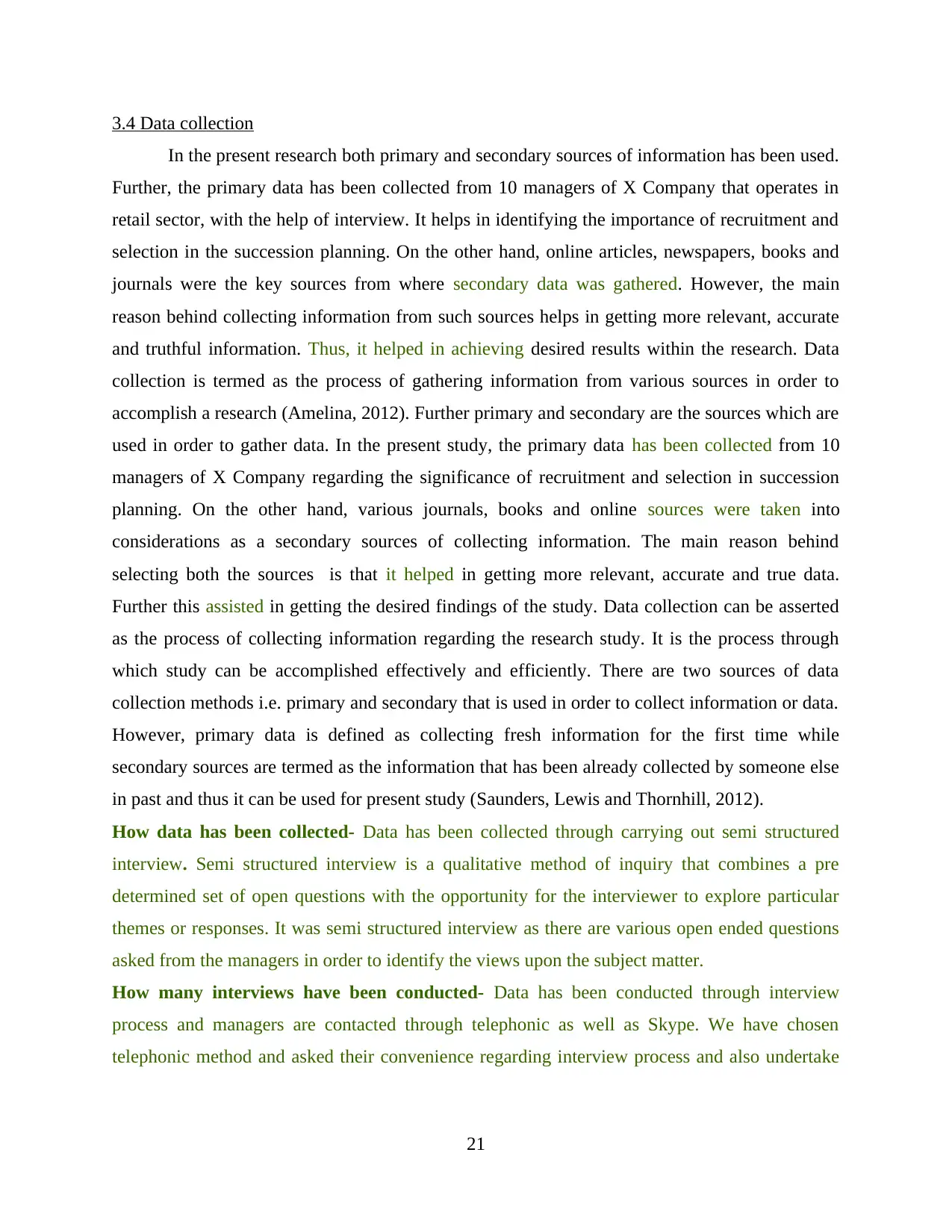
3.4 Data collection
In the present research both primary and secondary sources of information has been used.
Further, the primary data has been collected from 10 managers of X Company that operates in
retail sector, with the help of interview. It helps in identifying the importance of recruitment and
selection in the succession planning. On the other hand, online articles, newspapers, books and
journals were the key sources from where secondary data was gathered. However, the main
reason behind collecting information from such sources helps in getting more relevant, accurate
and truthful information. Thus, it helped in achieving desired results within the research. Data
collection is termed as the process of gathering information from various sources in order to
accomplish a research (Amelina, 2012). Further primary and secondary are the sources which are
used in order to gather data. In the present study, the primary data has been collected from 10
managers of X Company regarding the significance of recruitment and selection in succession
planning. On the other hand, various journals, books and online sources were taken into
considerations as a secondary sources of collecting information. The main reason behind
selecting both the sources is that it helped in getting more relevant, accurate and true data.
Further this assisted in getting the desired findings of the study. Data collection can be asserted
as the process of collecting information regarding the research study. It is the process through
which study can be accomplished effectively and efficiently. There are two sources of data
collection methods i.e. primary and secondary that is used in order to collect information or data.
However, primary data is defined as collecting fresh information for the first time while
secondary sources are termed as the information that has been already collected by someone else
in past and thus it can be used for present study (Saunders, Lewis and Thornhill, 2012).
How data has been collected- Data has been collected through carrying out semi structured
interview. Semi structured interview is a qualitative method of inquiry that combines a pre
determined set of open questions with the opportunity for the interviewer to explore particular
themes or responses. It was semi structured interview as there are various open ended questions
asked from the managers in order to identify the views upon the subject matter.
How many interviews have been conducted- Data has been conducted through interview
process and managers are contacted through telephonic as well as Skype. We have chosen
telephonic method and asked their convenience regarding interview process and also undertake
21
In the present research both primary and secondary sources of information has been used.
Further, the primary data has been collected from 10 managers of X Company that operates in
retail sector, with the help of interview. It helps in identifying the importance of recruitment and
selection in the succession planning. On the other hand, online articles, newspapers, books and
journals were the key sources from where secondary data was gathered. However, the main
reason behind collecting information from such sources helps in getting more relevant, accurate
and truthful information. Thus, it helped in achieving desired results within the research. Data
collection is termed as the process of gathering information from various sources in order to
accomplish a research (Amelina, 2012). Further primary and secondary are the sources which are
used in order to gather data. In the present study, the primary data has been collected from 10
managers of X Company regarding the significance of recruitment and selection in succession
planning. On the other hand, various journals, books and online sources were taken into
considerations as a secondary sources of collecting information. The main reason behind
selecting both the sources is that it helped in getting more relevant, accurate and true data.
Further this assisted in getting the desired findings of the study. Data collection can be asserted
as the process of collecting information regarding the research study. It is the process through
which study can be accomplished effectively and efficiently. There are two sources of data
collection methods i.e. primary and secondary that is used in order to collect information or data.
However, primary data is defined as collecting fresh information for the first time while
secondary sources are termed as the information that has been already collected by someone else
in past and thus it can be used for present study (Saunders, Lewis and Thornhill, 2012).
How data has been collected- Data has been collected through carrying out semi structured
interview. Semi structured interview is a qualitative method of inquiry that combines a pre
determined set of open questions with the opportunity for the interviewer to explore particular
themes or responses. It was semi structured interview as there are various open ended questions
asked from the managers in order to identify the views upon the subject matter.
How many interviews have been conducted- Data has been conducted through interview
process and managers are contacted through telephonic as well as Skype. We have chosen
telephonic method and asked their convenience regarding interview process and also undertake
21
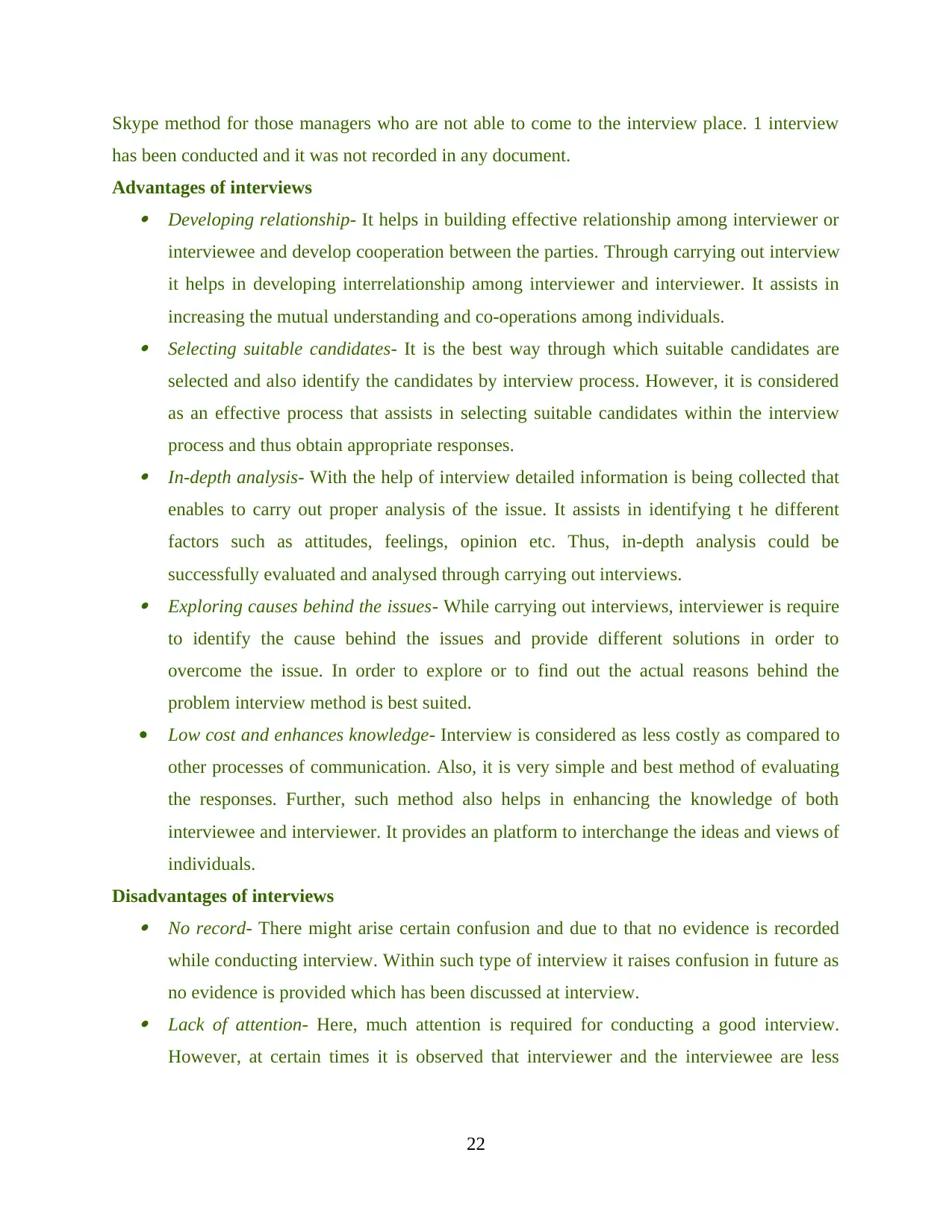
Skype method for those managers who are not able to come to the interview place. 1 interview
has been conducted and it was not recorded in any document.
Advantages of interviews Developing relationship- It helps in building effective relationship among interviewer or
interviewee and develop cooperation between the parties. Through carrying out interview
it helps in developing interrelationship among interviewer and interviewer. It assists in
increasing the mutual understanding and co-operations among individuals. Selecting suitable candidates- It is the best way through which suitable candidates are
selected and also identify the candidates by interview process. However, it is considered
as an effective process that assists in selecting suitable candidates within the interview
process and thus obtain appropriate responses. In-depth analysis- With the help of interview detailed information is being collected that
enables to carry out proper analysis of the issue. It assists in identifying t he different
factors such as attitudes, feelings, opinion etc. Thus, in-depth analysis could be
successfully evaluated and analysed through carrying out interviews. Exploring causes behind the issues- While carrying out interviews, interviewer is require
to identify the cause behind the issues and provide different solutions in order to
overcome the issue. In order to explore or to find out the actual reasons behind the
problem interview method is best suited.
Low cost and enhances knowledge- Interview is considered as less costly as compared to
other processes of communication. Also, it is very simple and best method of evaluating
the responses. Further, such method also helps in enhancing the knowledge of both
interviewee and interviewer. It provides an platform to interchange the ideas and views of
individuals.
Disadvantages of interviews No record- There might arise certain confusion and due to that no evidence is recorded
while conducting interview. Within such type of interview it raises confusion in future as
no evidence is provided which has been discussed at interview. Lack of attention- Here, much attention is required for conducting a good interview.
However, at certain times it is observed that interviewer and the interviewee are less
22
has been conducted and it was not recorded in any document.
Advantages of interviews Developing relationship- It helps in building effective relationship among interviewer or
interviewee and develop cooperation between the parties. Through carrying out interview
it helps in developing interrelationship among interviewer and interviewer. It assists in
increasing the mutual understanding and co-operations among individuals. Selecting suitable candidates- It is the best way through which suitable candidates are
selected and also identify the candidates by interview process. However, it is considered
as an effective process that assists in selecting suitable candidates within the interview
process and thus obtain appropriate responses. In-depth analysis- With the help of interview detailed information is being collected that
enables to carry out proper analysis of the issue. It assists in identifying t he different
factors such as attitudes, feelings, opinion etc. Thus, in-depth analysis could be
successfully evaluated and analysed through carrying out interviews. Exploring causes behind the issues- While carrying out interviews, interviewer is require
to identify the cause behind the issues and provide different solutions in order to
overcome the issue. In order to explore or to find out the actual reasons behind the
problem interview method is best suited.
Low cost and enhances knowledge- Interview is considered as less costly as compared to
other processes of communication. Also, it is very simple and best method of evaluating
the responses. Further, such method also helps in enhancing the knowledge of both
interviewee and interviewer. It provides an platform to interchange the ideas and views of
individuals.
Disadvantages of interviews No record- There might arise certain confusion and due to that no evidence is recorded
while conducting interview. Within such type of interview it raises confusion in future as
no evidence is provided which has been discussed at interview. Lack of attention- Here, much attention is required for conducting a good interview.
However, at certain times it is observed that interviewer and the interviewee are less
22
Paraphrase This Document
Need a fresh take? Get an instant paraphrase of this document with our AI Paraphraser
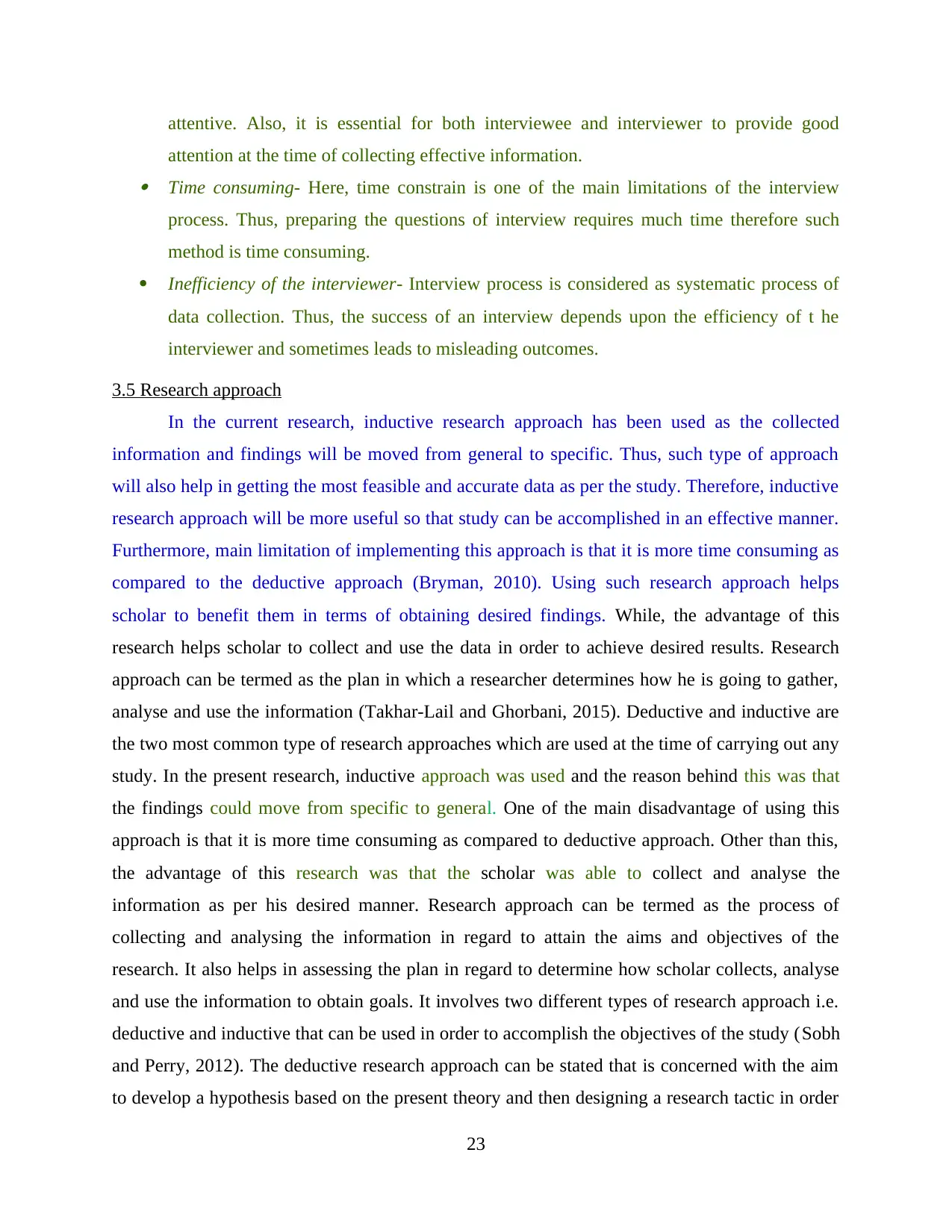
attentive. Also, it is essential for both interviewee and interviewer to provide good
attention at the time of collecting effective information. Time consuming- Here, time constrain is one of the main limitations of the interview
process. Thus, preparing the questions of interview requires much time therefore such
method is time consuming.
Inefficiency of the interviewer- Interview process is considered as systematic process of
data collection. Thus, the success of an interview depends upon the efficiency of t he
interviewer and sometimes leads to misleading outcomes.
3.5 Research approach
In the current research, inductive research approach has been used as the collected
information and findings will be moved from general to specific. Thus, such type of approach
will also help in getting the most feasible and accurate data as per the study. Therefore, inductive
research approach will be more useful so that study can be accomplished in an effective manner.
Furthermore, main limitation of implementing this approach is that it is more time consuming as
compared to the deductive approach (Bryman, 2010). Using such research approach helps
scholar to benefit them in terms of obtaining desired findings. While, the advantage of this
research helps scholar to collect and use the data in order to achieve desired results. Research
approach can be termed as the plan in which a researcher determines how he is going to gather,
analyse and use the information (Takhar-Lail and Ghorbani, 2015). Deductive and inductive are
the two most common type of research approaches which are used at the time of carrying out any
study. In the present research, inductive approach was used and the reason behind this was that
the findings could move from specific to general. One of the main disadvantage of using this
approach is that it is more time consuming as compared to deductive approach. Other than this,
the advantage of this research was that the scholar was able to collect and analyse the
information as per his desired manner. Research approach can be termed as the process of
collecting and analysing the information in regard to attain the aims and objectives of the
research. It also helps in assessing the plan in regard to determine how scholar collects, analyse
and use the information to obtain goals. It involves two different types of research approach i.e.
deductive and inductive that can be used in order to accomplish the objectives of the study (Sobh
and Perry, 2012). The deductive research approach can be stated that is concerned with the aim
to develop a hypothesis based on the present theory and then designing a research tactic in order
23
attention at the time of collecting effective information. Time consuming- Here, time constrain is one of the main limitations of the interview
process. Thus, preparing the questions of interview requires much time therefore such
method is time consuming.
Inefficiency of the interviewer- Interview process is considered as systematic process of
data collection. Thus, the success of an interview depends upon the efficiency of t he
interviewer and sometimes leads to misleading outcomes.
3.5 Research approach
In the current research, inductive research approach has been used as the collected
information and findings will be moved from general to specific. Thus, such type of approach
will also help in getting the most feasible and accurate data as per the study. Therefore, inductive
research approach will be more useful so that study can be accomplished in an effective manner.
Furthermore, main limitation of implementing this approach is that it is more time consuming as
compared to the deductive approach (Bryman, 2010). Using such research approach helps
scholar to benefit them in terms of obtaining desired findings. While, the advantage of this
research helps scholar to collect and use the data in order to achieve desired results. Research
approach can be termed as the plan in which a researcher determines how he is going to gather,
analyse and use the information (Takhar-Lail and Ghorbani, 2015). Deductive and inductive are
the two most common type of research approaches which are used at the time of carrying out any
study. In the present research, inductive approach was used and the reason behind this was that
the findings could move from specific to general. One of the main disadvantage of using this
approach is that it is more time consuming as compared to deductive approach. Other than this,
the advantage of this research was that the scholar was able to collect and analyse the
information as per his desired manner. Research approach can be termed as the process of
collecting and analysing the information in regard to attain the aims and objectives of the
research. It also helps in assessing the plan in regard to determine how scholar collects, analyse
and use the information to obtain goals. It involves two different types of research approach i.e.
deductive and inductive that can be used in order to accomplish the objectives of the study (Sobh
and Perry, 2012). The deductive research approach can be stated that is concerned with the aim
to develop a hypothesis based on the present theory and then designing a research tactic in order
23
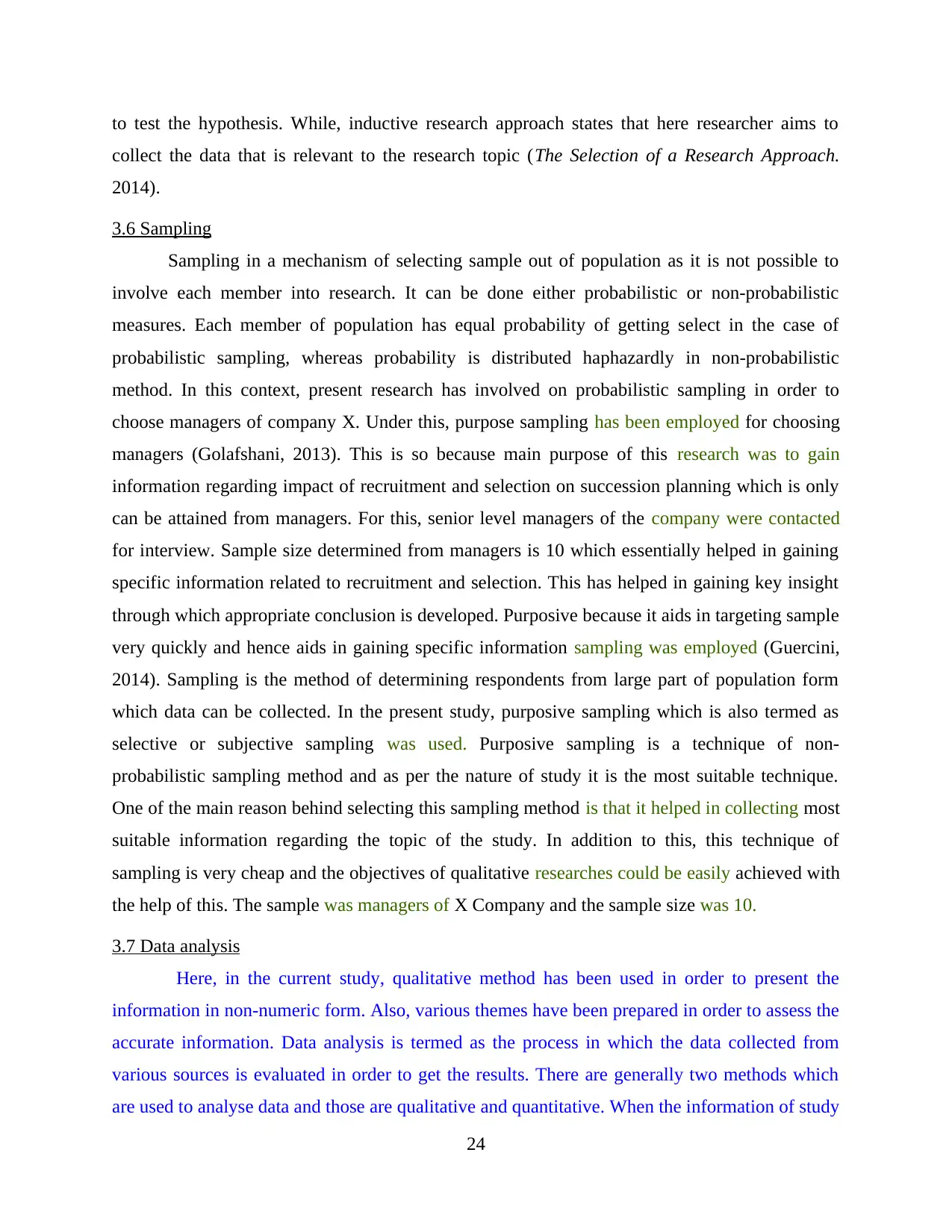
to test the hypothesis. While, inductive research approach states that here researcher aims to
collect the data that is relevant to the research topic (The Selection of a Research Approach.
2014).
3.6 Sampling
Sampling in a mechanism of selecting sample out of population as it is not possible to
involve each member into research. It can be done either probabilistic or non-probabilistic
measures. Each member of population has equal probability of getting select in the case of
probabilistic sampling, whereas probability is distributed haphazardly in non-probabilistic
method. In this context, present research has involved on probabilistic sampling in order to
choose managers of company X. Under this, purpose sampling has been employed for choosing
managers (Golafshani, 2013). This is so because main purpose of this research was to gain
information regarding impact of recruitment and selection on succession planning which is only
can be attained from managers. For this, senior level managers of the company were contacted
for interview. Sample size determined from managers is 10 which essentially helped in gaining
specific information related to recruitment and selection. This has helped in gaining key insight
through which appropriate conclusion is developed. Purposive because it aids in targeting sample
very quickly and hence aids in gaining specific information sampling was employed (Guercini,
2014). Sampling is the method of determining respondents from large part of population form
which data can be collected. In the present study, purposive sampling which is also termed as
selective or subjective sampling was used. Purposive sampling is a technique of non-
probabilistic sampling method and as per the nature of study it is the most suitable technique.
One of the main reason behind selecting this sampling method is that it helped in collecting most
suitable information regarding the topic of the study. In addition to this, this technique of
sampling is very cheap and the objectives of qualitative researches could be easily achieved with
the help of this. The sample was managers of X Company and the sample size was 10.
3.7 Data analysis
Here, in the current study, qualitative method has been used in order to present the
information in non-numeric form. Also, various themes have been prepared in order to assess the
accurate information. Data analysis is termed as the process in which the data collected from
various sources is evaluated in order to get the results. There are generally two methods which
are used to analyse data and those are qualitative and quantitative. When the information of study
24
collect the data that is relevant to the research topic (The Selection of a Research Approach.
2014).
3.6 Sampling
Sampling in a mechanism of selecting sample out of population as it is not possible to
involve each member into research. It can be done either probabilistic or non-probabilistic
measures. Each member of population has equal probability of getting select in the case of
probabilistic sampling, whereas probability is distributed haphazardly in non-probabilistic
method. In this context, present research has involved on probabilistic sampling in order to
choose managers of company X. Under this, purpose sampling has been employed for choosing
managers (Golafshani, 2013). This is so because main purpose of this research was to gain
information regarding impact of recruitment and selection on succession planning which is only
can be attained from managers. For this, senior level managers of the company were contacted
for interview. Sample size determined from managers is 10 which essentially helped in gaining
specific information related to recruitment and selection. This has helped in gaining key insight
through which appropriate conclusion is developed. Purposive because it aids in targeting sample
very quickly and hence aids in gaining specific information sampling was employed (Guercini,
2014). Sampling is the method of determining respondents from large part of population form
which data can be collected. In the present study, purposive sampling which is also termed as
selective or subjective sampling was used. Purposive sampling is a technique of non-
probabilistic sampling method and as per the nature of study it is the most suitable technique.
One of the main reason behind selecting this sampling method is that it helped in collecting most
suitable information regarding the topic of the study. In addition to this, this technique of
sampling is very cheap and the objectives of qualitative researches could be easily achieved with
the help of this. The sample was managers of X Company and the sample size was 10.
3.7 Data analysis
Here, in the current study, qualitative method has been used in order to present the
information in non-numeric form. Also, various themes have been prepared in order to assess the
accurate information. Data analysis is termed as the process in which the data collected from
various sources is evaluated in order to get the results. There are generally two methods which
are used to analyse data and those are qualitative and quantitative. When the information of study
24
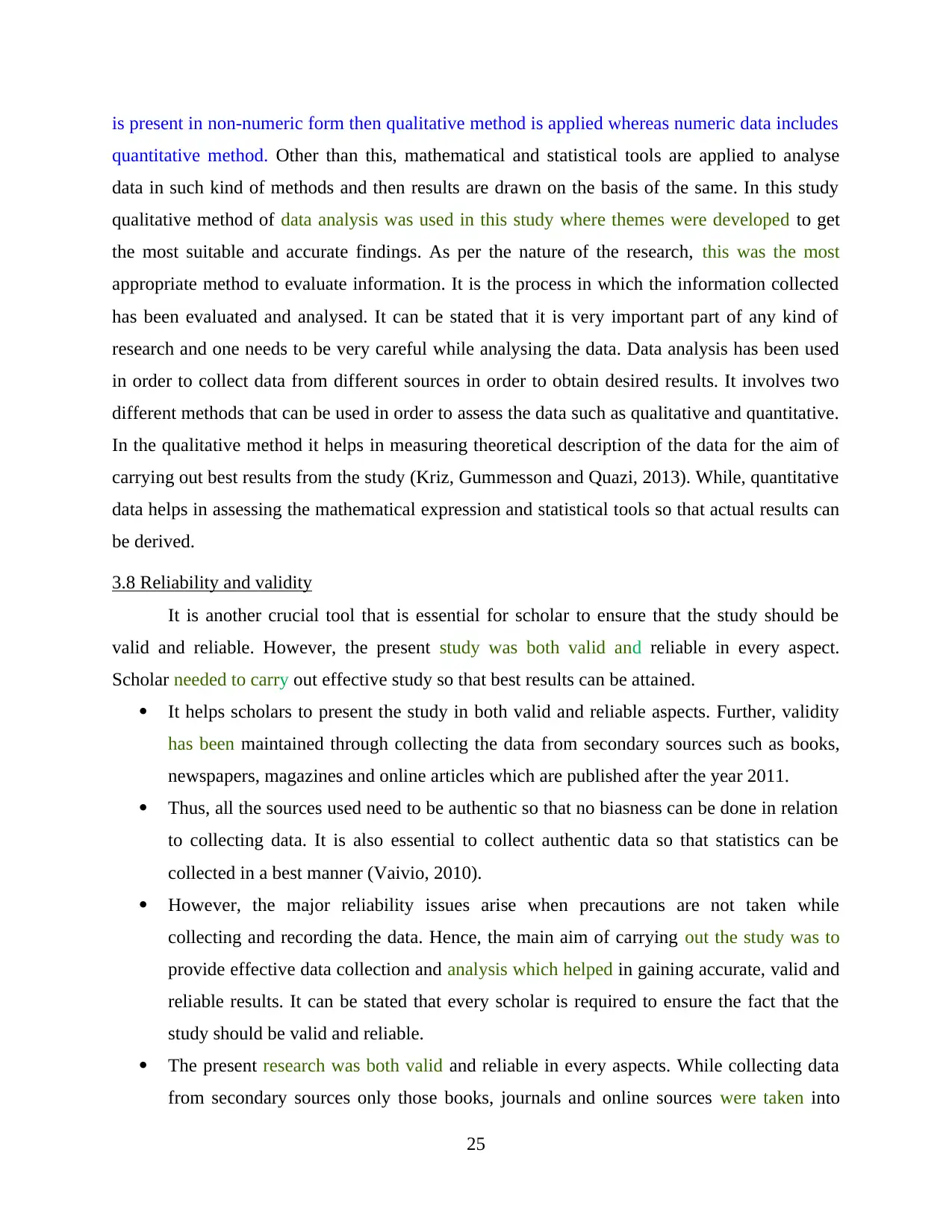
is present in non-numeric form then qualitative method is applied whereas numeric data includes
quantitative method. Other than this, mathematical and statistical tools are applied to analyse
data in such kind of methods and then results are drawn on the basis of the same. In this study
qualitative method of data analysis was used in this study where themes were developed to get
the most suitable and accurate findings. As per the nature of the research, this was the most
appropriate method to evaluate information. It is the process in which the information collected
has been evaluated and analysed. It can be stated that it is very important part of any kind of
research and one needs to be very careful while analysing the data. Data analysis has been used
in order to collect data from different sources in order to obtain desired results. It involves two
different methods that can be used in order to assess the data such as qualitative and quantitative.
In the qualitative method it helps in measuring theoretical description of the data for the aim of
carrying out best results from the study (Kriz, Gummesson and Quazi, 2013). While, quantitative
data helps in assessing the mathematical expression and statistical tools so that actual results can
be derived.
3.8 Reliability and validity
It is another crucial tool that is essential for scholar to ensure that the study should be
valid and reliable. However, the present study was both valid and reliable in every aspect.
Scholar needed to carry out effective study so that best results can be attained.
It helps scholars to present the study in both valid and reliable aspects. Further, validity
has been maintained through collecting the data from secondary sources such as books,
newspapers, magazines and online articles which are published after the year 2011.
Thus, all the sources used need to be authentic so that no biasness can be done in relation
to collecting data. It is also essential to collect authentic data so that statistics can be
collected in a best manner (Vaivio, 2010).
However, the major reliability issues arise when precautions are not taken while
collecting and recording the data. Hence, the main aim of carrying out the study was to
provide effective data collection and analysis which helped in gaining accurate, valid and
reliable results. It can be stated that every scholar is required to ensure the fact that the
study should be valid and reliable.
The present research was both valid and reliable in every aspects. While collecting data
from secondary sources only those books, journals and online sources were taken into
25
quantitative method. Other than this, mathematical and statistical tools are applied to analyse
data in such kind of methods and then results are drawn on the basis of the same. In this study
qualitative method of data analysis was used in this study where themes were developed to get
the most suitable and accurate findings. As per the nature of the research, this was the most
appropriate method to evaluate information. It is the process in which the information collected
has been evaluated and analysed. It can be stated that it is very important part of any kind of
research and one needs to be very careful while analysing the data. Data analysis has been used
in order to collect data from different sources in order to obtain desired results. It involves two
different methods that can be used in order to assess the data such as qualitative and quantitative.
In the qualitative method it helps in measuring theoretical description of the data for the aim of
carrying out best results from the study (Kriz, Gummesson and Quazi, 2013). While, quantitative
data helps in assessing the mathematical expression and statistical tools so that actual results can
be derived.
3.8 Reliability and validity
It is another crucial tool that is essential for scholar to ensure that the study should be
valid and reliable. However, the present study was both valid and reliable in every aspect.
Scholar needed to carry out effective study so that best results can be attained.
It helps scholars to present the study in both valid and reliable aspects. Further, validity
has been maintained through collecting the data from secondary sources such as books,
newspapers, magazines and online articles which are published after the year 2011.
Thus, all the sources used need to be authentic so that no biasness can be done in relation
to collecting data. It is also essential to collect authentic data so that statistics can be
collected in a best manner (Vaivio, 2010).
However, the major reliability issues arise when precautions are not taken while
collecting and recording the data. Hence, the main aim of carrying out the study was to
provide effective data collection and analysis which helped in gaining accurate, valid and
reliable results. It can be stated that every scholar is required to ensure the fact that the
study should be valid and reliable.
The present research was both valid and reliable in every aspects. While collecting data
from secondary sources only those books, journals and online sources were taken into
25
Secure Best Marks with AI Grader
Need help grading? Try our AI Grader for instant feedback on your assignments.
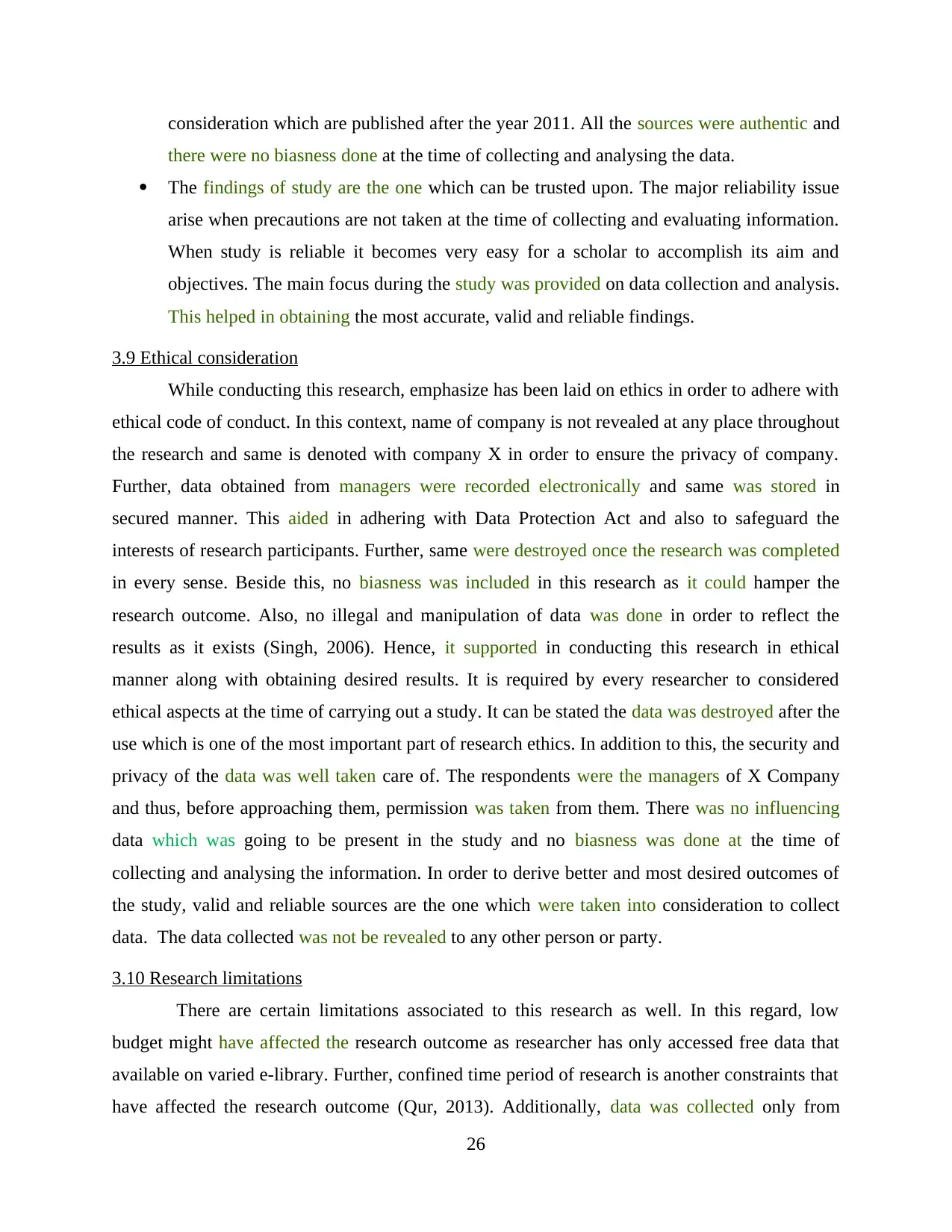
consideration which are published after the year 2011. All the sources were authentic and
there were no biasness done at the time of collecting and analysing the data.
The findings of study are the one which can be trusted upon. The major reliability issue
arise when precautions are not taken at the time of collecting and evaluating information.
When study is reliable it becomes very easy for a scholar to accomplish its aim and
objectives. The main focus during the study was provided on data collection and analysis.
This helped in obtaining the most accurate, valid and reliable findings.
3.9 Ethical consideration
While conducting this research, emphasize has been laid on ethics in order to adhere with
ethical code of conduct. In this context, name of company is not revealed at any place throughout
the research and same is denoted with company X in order to ensure the privacy of company.
Further, data obtained from managers were recorded electronically and same was stored in
secured manner. This aided in adhering with Data Protection Act and also to safeguard the
interests of research participants. Further, same were destroyed once the research was completed
in every sense. Beside this, no biasness was included in this research as it could hamper the
research outcome. Also, no illegal and manipulation of data was done in order to reflect the
results as it exists (Singh, 2006). Hence, it supported in conducting this research in ethical
manner along with obtaining desired results. It is required by every researcher to considered
ethical aspects at the time of carrying out a study. It can be stated the data was destroyed after the
use which is one of the most important part of research ethics. In addition to this, the security and
privacy of the data was well taken care of. The respondents were the managers of X Company
and thus, before approaching them, permission was taken from them. There was no influencing
data which was going to be present in the study and no biasness was done at the time of
collecting and analysing the information. In order to derive better and most desired outcomes of
the study, valid and reliable sources are the one which were taken into consideration to collect
data. The data collected was not be revealed to any other person or party.
3.10 Research limitations
There are certain limitations associated to this research as well. In this regard, low
budget might have affected the research outcome as researcher has only accessed free data that
available on varied e-library. Further, confined time period of research is another constraints that
have affected the research outcome (Qur, 2013). Additionally, data was collected only from
26
there were no biasness done at the time of collecting and analysing the data.
The findings of study are the one which can be trusted upon. The major reliability issue
arise when precautions are not taken at the time of collecting and evaluating information.
When study is reliable it becomes very easy for a scholar to accomplish its aim and
objectives. The main focus during the study was provided on data collection and analysis.
This helped in obtaining the most accurate, valid and reliable findings.
3.9 Ethical consideration
While conducting this research, emphasize has been laid on ethics in order to adhere with
ethical code of conduct. In this context, name of company is not revealed at any place throughout
the research and same is denoted with company X in order to ensure the privacy of company.
Further, data obtained from managers were recorded electronically and same was stored in
secured manner. This aided in adhering with Data Protection Act and also to safeguard the
interests of research participants. Further, same were destroyed once the research was completed
in every sense. Beside this, no biasness was included in this research as it could hamper the
research outcome. Also, no illegal and manipulation of data was done in order to reflect the
results as it exists (Singh, 2006). Hence, it supported in conducting this research in ethical
manner along with obtaining desired results. It is required by every researcher to considered
ethical aspects at the time of carrying out a study. It can be stated the data was destroyed after the
use which is one of the most important part of research ethics. In addition to this, the security and
privacy of the data was well taken care of. The respondents were the managers of X Company
and thus, before approaching them, permission was taken from them. There was no influencing
data which was going to be present in the study and no biasness was done at the time of
collecting and analysing the information. In order to derive better and most desired outcomes of
the study, valid and reliable sources are the one which were taken into consideration to collect
data. The data collected was not be revealed to any other person or party.
3.10 Research limitations
There are certain limitations associated to this research as well. In this regard, low
budget might have affected the research outcome as researcher has only accessed free data that
available on varied e-library. Further, confined time period of research is another constraints that
have affected the research outcome (Qur, 2013). Additionally, data was collected only from
26
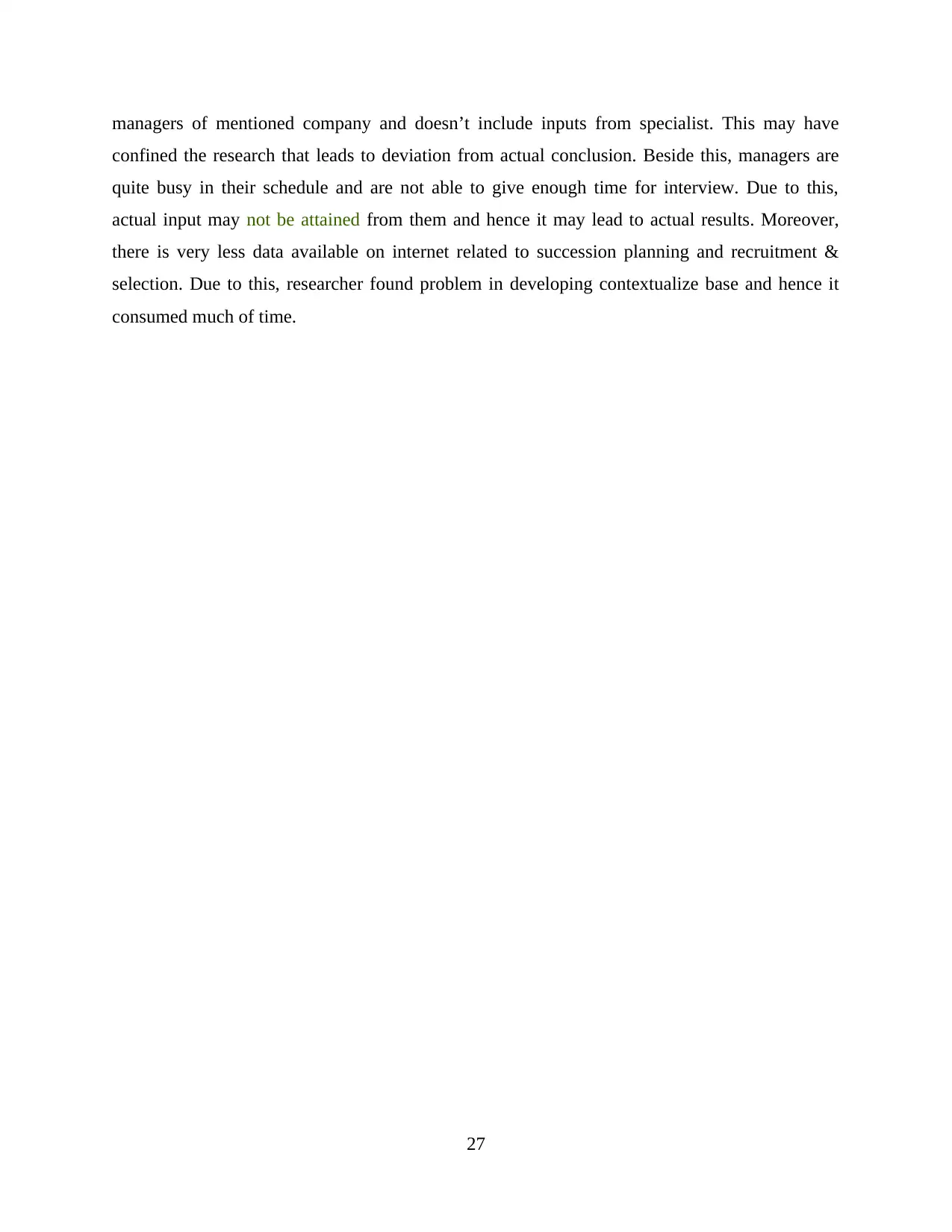
managers of mentioned company and doesn’t include inputs from specialist. This may have
confined the research that leads to deviation from actual conclusion. Beside this, managers are
quite busy in their schedule and are not able to give enough time for interview. Due to this,
actual input may not be attained from them and hence it may lead to actual results. Moreover,
there is very less data available on internet related to succession planning and recruitment &
selection. Due to this, researcher found problem in developing contextualize base and hence it
consumed much of time.
27
confined the research that leads to deviation from actual conclusion. Beside this, managers are
quite busy in their schedule and are not able to give enough time for interview. Due to this,
actual input may not be attained from them and hence it may lead to actual results. Moreover,
there is very less data available on internet related to succession planning and recruitment &
selection. Due to this, researcher found problem in developing contextualize base and hence it
consumed much of time.
27
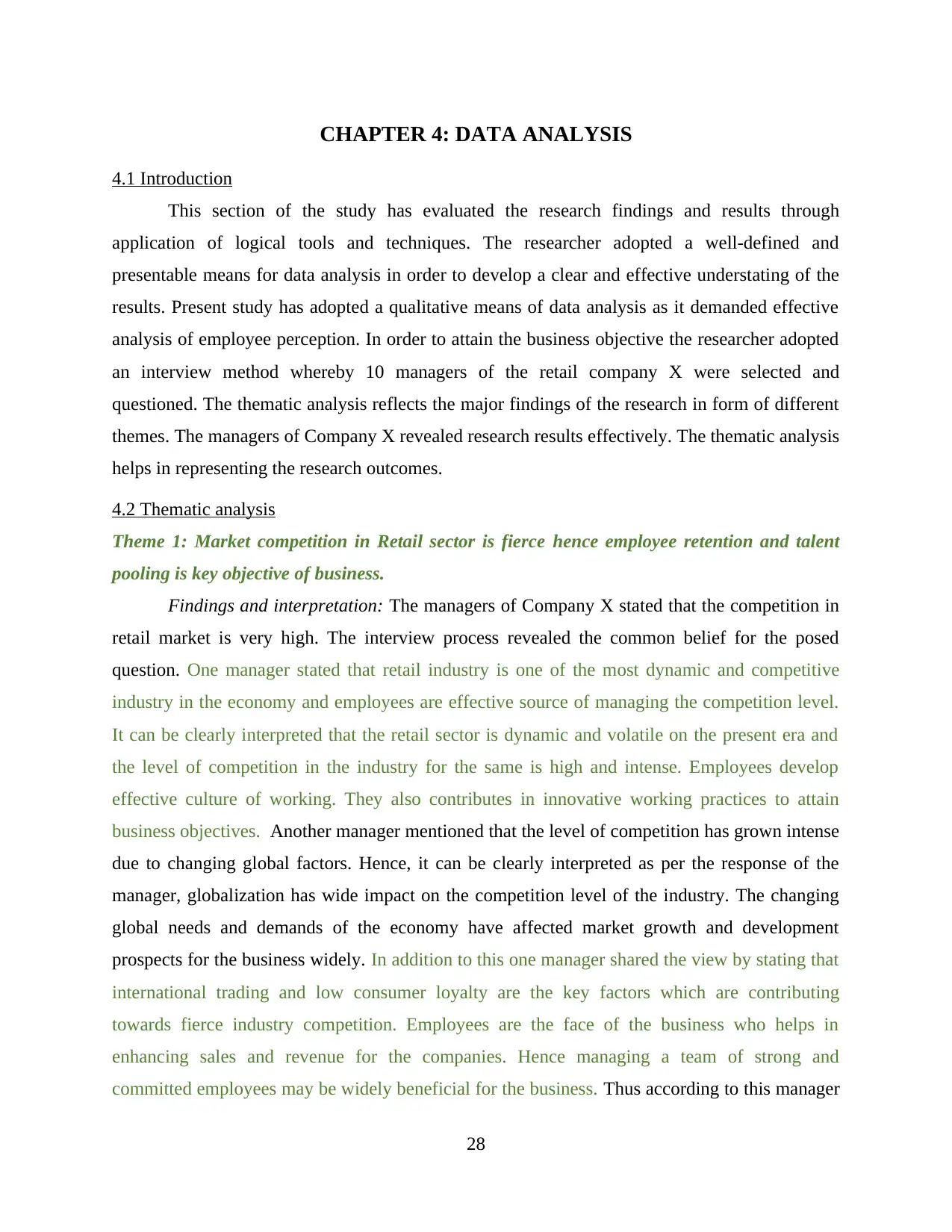
CHAPTER 4: DATA ANALYSIS
4.1 Introduction
This section of the study has evaluated the research findings and results through
application of logical tools and techniques. The researcher adopted a well-defined and
presentable means for data analysis in order to develop a clear and effective understating of the
results. Present study has adopted a qualitative means of data analysis as it demanded effective
analysis of employee perception. In order to attain the business objective the researcher adopted
an interview method whereby 10 managers of the retail company X were selected and
questioned. The thematic analysis reflects the major findings of the research in form of different
themes. The managers of Company X revealed research results effectively. The thematic analysis
helps in representing the research outcomes.
4.2 Thematic analysis
Theme 1: Market competition in Retail sector is fierce hence employee retention and talent
pooling is key objective of business.
Findings and interpretation: The managers of Company X stated that the competition in
retail market is very high. The interview process revealed the common belief for the posed
question. One manager stated that retail industry is one of the most dynamic and competitive
industry in the economy and employees are effective source of managing the competition level.
It can be clearly interpreted that the retail sector is dynamic and volatile on the present era and
the level of competition in the industry for the same is high and intense. Employees develop
effective culture of working. They also contributes in innovative working practices to attain
business objectives. Another manager mentioned that the level of competition has grown intense
due to changing global factors. Hence, it can be clearly interpreted as per the response of the
manager, globalization has wide impact on the competition level of the industry. The changing
global needs and demands of the economy have affected market growth and development
prospects for the business widely. In addition to this one manager shared the view by stating that
international trading and low consumer loyalty are the key factors which are contributing
towards fierce industry competition. Employees are the face of the business who helps in
enhancing sales and revenue for the companies. Hence managing a team of strong and
committed employees may be widely beneficial for the business. Thus according to this manager
28
4.1 Introduction
This section of the study has evaluated the research findings and results through
application of logical tools and techniques. The researcher adopted a well-defined and
presentable means for data analysis in order to develop a clear and effective understating of the
results. Present study has adopted a qualitative means of data analysis as it demanded effective
analysis of employee perception. In order to attain the business objective the researcher adopted
an interview method whereby 10 managers of the retail company X were selected and
questioned. The thematic analysis reflects the major findings of the research in form of different
themes. The managers of Company X revealed research results effectively. The thematic analysis
helps in representing the research outcomes.
4.2 Thematic analysis
Theme 1: Market competition in Retail sector is fierce hence employee retention and talent
pooling is key objective of business.
Findings and interpretation: The managers of Company X stated that the competition in
retail market is very high. The interview process revealed the common belief for the posed
question. One manager stated that retail industry is one of the most dynamic and competitive
industry in the economy and employees are effective source of managing the competition level.
It can be clearly interpreted that the retail sector is dynamic and volatile on the present era and
the level of competition in the industry for the same is high and intense. Employees develop
effective culture of working. They also contributes in innovative working practices to attain
business objectives. Another manager mentioned that the level of competition has grown intense
due to changing global factors. Hence, it can be clearly interpreted as per the response of the
manager, globalization has wide impact on the competition level of the industry. The changing
global needs and demands of the economy have affected market growth and development
prospects for the business widely. In addition to this one manager shared the view by stating that
international trading and low consumer loyalty are the key factors which are contributing
towards fierce industry competition. Employees are the face of the business who helps in
enhancing sales and revenue for the companies. Hence managing a team of strong and
committed employees may be widely beneficial for the business. Thus according to this manager
28
Paraphrase This Document
Need a fresh take? Get an instant paraphrase of this document with our AI Paraphraser
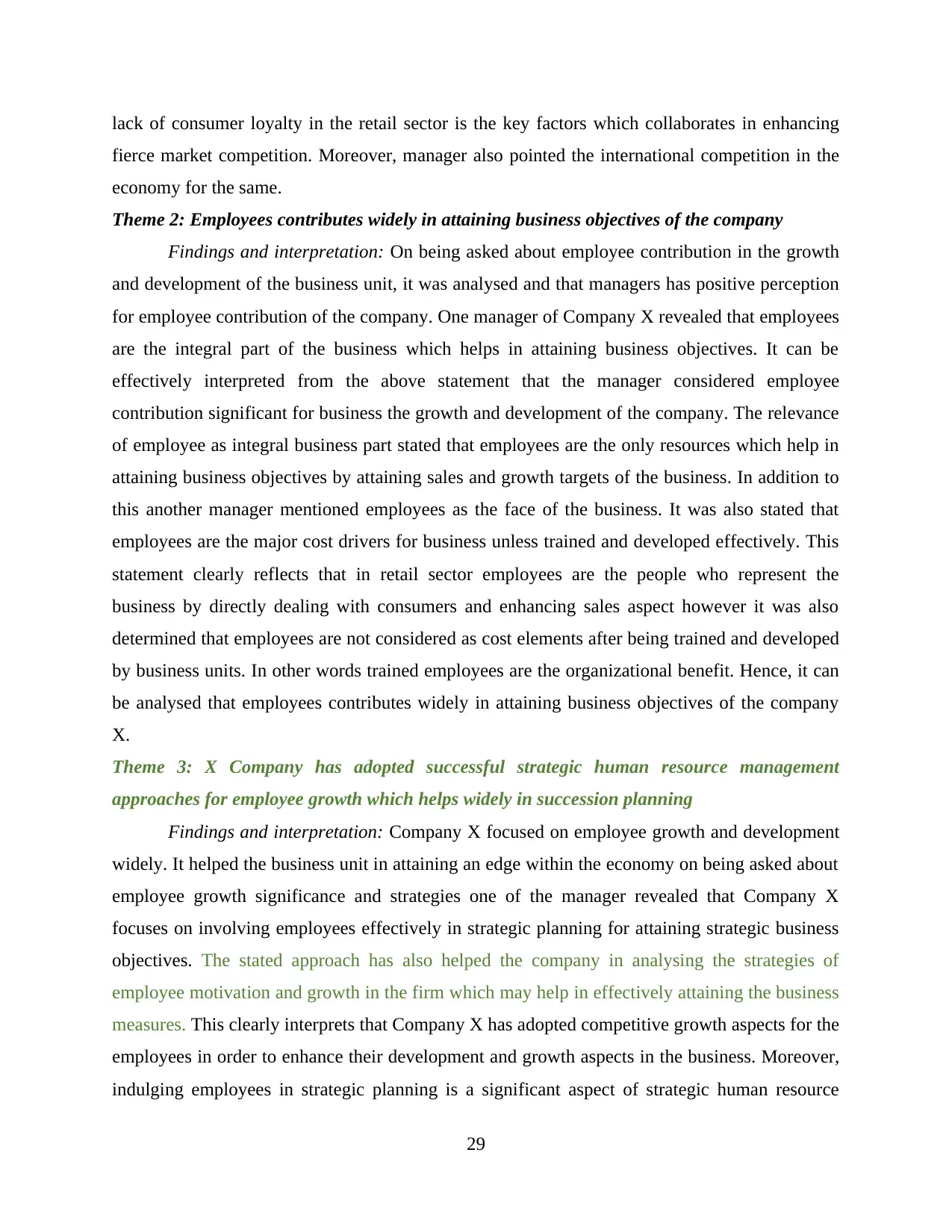
lack of consumer loyalty in the retail sector is the key factors which collaborates in enhancing
fierce market competition. Moreover, manager also pointed the international competition in the
economy for the same.
Theme 2: Employees contributes widely in attaining business objectives of the company
Findings and interpretation: On being asked about employee contribution in the growth
and development of the business unit, it was analysed and that managers has positive perception
for employee contribution of the company. One manager of Company X revealed that employees
are the integral part of the business which helps in attaining business objectives. It can be
effectively interpreted from the above statement that the manager considered employee
contribution significant for business the growth and development of the company. The relevance
of employee as integral business part stated that employees are the only resources which help in
attaining business objectives by attaining sales and growth targets of the business. In addition to
this another manager mentioned employees as the face of the business. It was also stated that
employees are the major cost drivers for business unless trained and developed effectively. This
statement clearly reflects that in retail sector employees are the people who represent the
business by directly dealing with consumers and enhancing sales aspect however it was also
determined that employees are not considered as cost elements after being trained and developed
by business units. In other words trained employees are the organizational benefit. Hence, it can
be analysed that employees contributes widely in attaining business objectives of the company
X.
Theme 3: X Company has adopted successful strategic human resource management
approaches for employee growth which helps widely in succession planning
Findings and interpretation: Company X focused on employee growth and development
widely. It helped the business unit in attaining an edge within the economy on being asked about
employee growth significance and strategies one of the manager revealed that Company X
focuses on involving employees effectively in strategic planning for attaining strategic business
objectives. The stated approach has also helped the company in analysing the strategies of
employee motivation and growth in the firm which may help in effectively attaining the business
measures. This clearly interprets that Company X has adopted competitive growth aspects for the
employees in order to enhance their development and growth aspects in the business. Moreover,
indulging employees in strategic planning is a significant aspect of strategic human resource
29
fierce market competition. Moreover, manager also pointed the international competition in the
economy for the same.
Theme 2: Employees contributes widely in attaining business objectives of the company
Findings and interpretation: On being asked about employee contribution in the growth
and development of the business unit, it was analysed and that managers has positive perception
for employee contribution of the company. One manager of Company X revealed that employees
are the integral part of the business which helps in attaining business objectives. It can be
effectively interpreted from the above statement that the manager considered employee
contribution significant for business the growth and development of the company. The relevance
of employee as integral business part stated that employees are the only resources which help in
attaining business objectives by attaining sales and growth targets of the business. In addition to
this another manager mentioned employees as the face of the business. It was also stated that
employees are the major cost drivers for business unless trained and developed effectively. This
statement clearly reflects that in retail sector employees are the people who represent the
business by directly dealing with consumers and enhancing sales aspect however it was also
determined that employees are not considered as cost elements after being trained and developed
by business units. In other words trained employees are the organizational benefit. Hence, it can
be analysed that employees contributes widely in attaining business objectives of the company
X.
Theme 3: X Company has adopted successful strategic human resource management
approaches for employee growth which helps widely in succession planning
Findings and interpretation: Company X focused on employee growth and development
widely. It helped the business unit in attaining an edge within the economy on being asked about
employee growth significance and strategies one of the manager revealed that Company X
focuses on involving employees effectively in strategic planning for attaining strategic business
objectives. The stated approach has also helped the company in analysing the strategies of
employee motivation and growth in the firm which may help in effectively attaining the business
measures. This clearly interprets that Company X has adopted competitive growth aspects for the
employees in order to enhance their development and growth aspects in the business. Moreover,
indulging employees in strategic planning is a significant aspect of strategic human resource
29
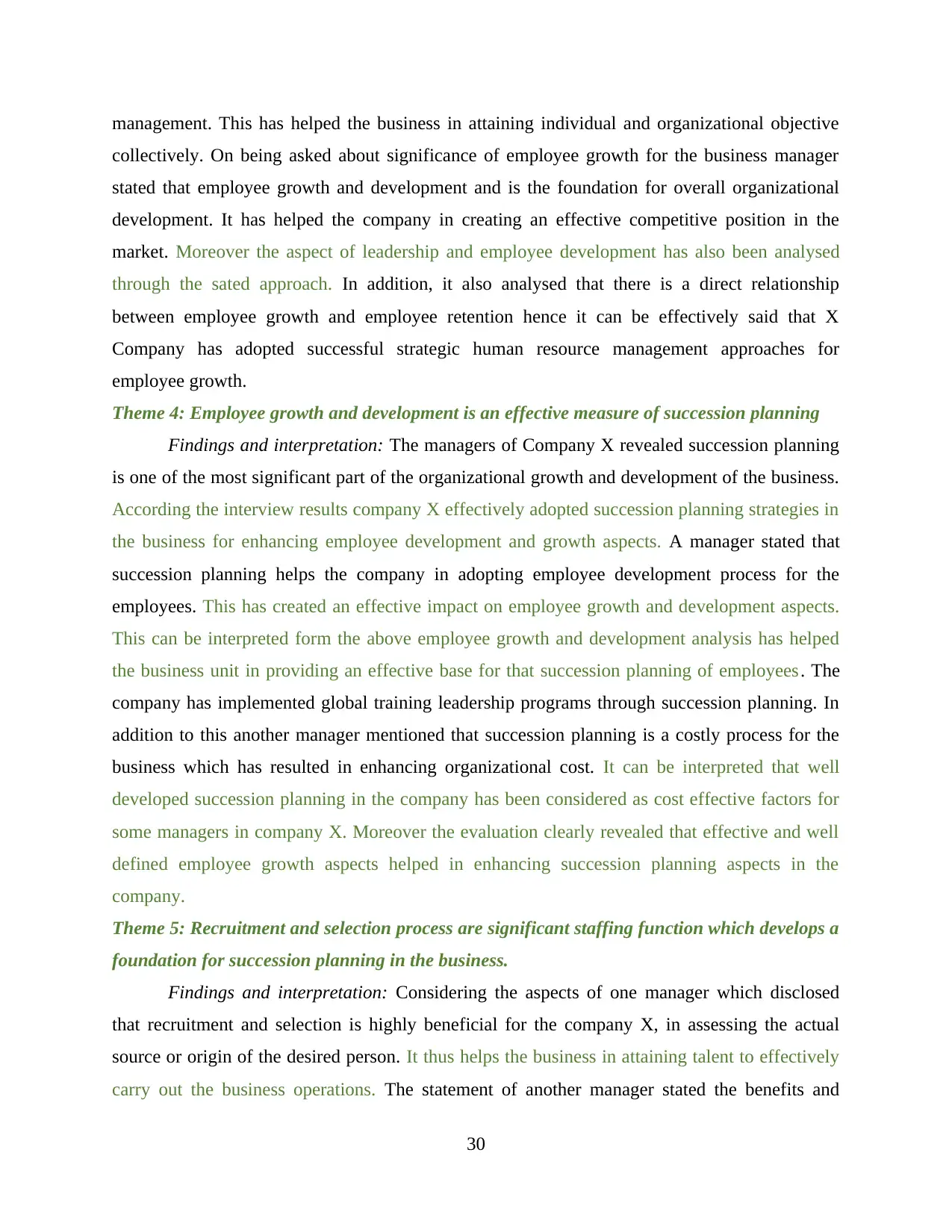
management. This has helped the business in attaining individual and organizational objective
collectively. On being asked about significance of employee growth for the business manager
stated that employee growth and development and is the foundation for overall organizational
development. It has helped the company in creating an effective competitive position in the
market. Moreover the aspect of leadership and employee development has also been analysed
through the sated approach. In addition, it also analysed that there is a direct relationship
between employee growth and employee retention hence it can be effectively said that X
Company has adopted successful strategic human resource management approaches for
employee growth.
Theme 4: Employee growth and development is an effective measure of succession planning
Findings and interpretation: The managers of Company X revealed succession planning
is one of the most significant part of the organizational growth and development of the business.
According the interview results company X effectively adopted succession planning strategies in
the business for enhancing employee development and growth aspects. A manager stated that
succession planning helps the company in adopting employee development process for the
employees. This has created an effective impact on employee growth and development aspects.
This can be interpreted form the above employee growth and development analysis has helped
the business unit in providing an effective base for that succession planning of employees. The
company has implemented global training leadership programs through succession planning. In
addition to this another manager mentioned that succession planning is a costly process for the
business which has resulted in enhancing organizational cost. It can be interpreted that well
developed succession planning in the company has been considered as cost effective factors for
some managers in company X. Moreover the evaluation clearly revealed that effective and well
defined employee growth aspects helped in enhancing succession planning aspects in the
company.
Theme 5: Recruitment and selection process are significant staffing function which develops a
foundation for succession planning in the business.
Findings and interpretation: Considering the aspects of one manager which disclosed
that recruitment and selection is highly beneficial for the company X, in assessing the actual
source or origin of the desired person. It thus helps the business in attaining talent to effectively
carry out the business operations. The statement of another manager stated the benefits and
30
collectively. On being asked about significance of employee growth for the business manager
stated that employee growth and development and is the foundation for overall organizational
development. It has helped the company in creating an effective competitive position in the
market. Moreover the aspect of leadership and employee development has also been analysed
through the sated approach. In addition, it also analysed that there is a direct relationship
between employee growth and employee retention hence it can be effectively said that X
Company has adopted successful strategic human resource management approaches for
employee growth.
Theme 4: Employee growth and development is an effective measure of succession planning
Findings and interpretation: The managers of Company X revealed succession planning
is one of the most significant part of the organizational growth and development of the business.
According the interview results company X effectively adopted succession planning strategies in
the business for enhancing employee development and growth aspects. A manager stated that
succession planning helps the company in adopting employee development process for the
employees. This has created an effective impact on employee growth and development aspects.
This can be interpreted form the above employee growth and development analysis has helped
the business unit in providing an effective base for that succession planning of employees. The
company has implemented global training leadership programs through succession planning. In
addition to this another manager mentioned that succession planning is a costly process for the
business which has resulted in enhancing organizational cost. It can be interpreted that well
developed succession planning in the company has been considered as cost effective factors for
some managers in company X. Moreover the evaluation clearly revealed that effective and well
defined employee growth aspects helped in enhancing succession planning aspects in the
company.
Theme 5: Recruitment and selection process are significant staffing function which develops a
foundation for succession planning in the business.
Findings and interpretation: Considering the aspects of one manager which disclosed
that recruitment and selection is highly beneficial for the company X, in assessing the actual
source or origin of the desired person. It thus helps the business in attaining talent to effectively
carry out the business operations. The statement of another manager stated the benefits and
30
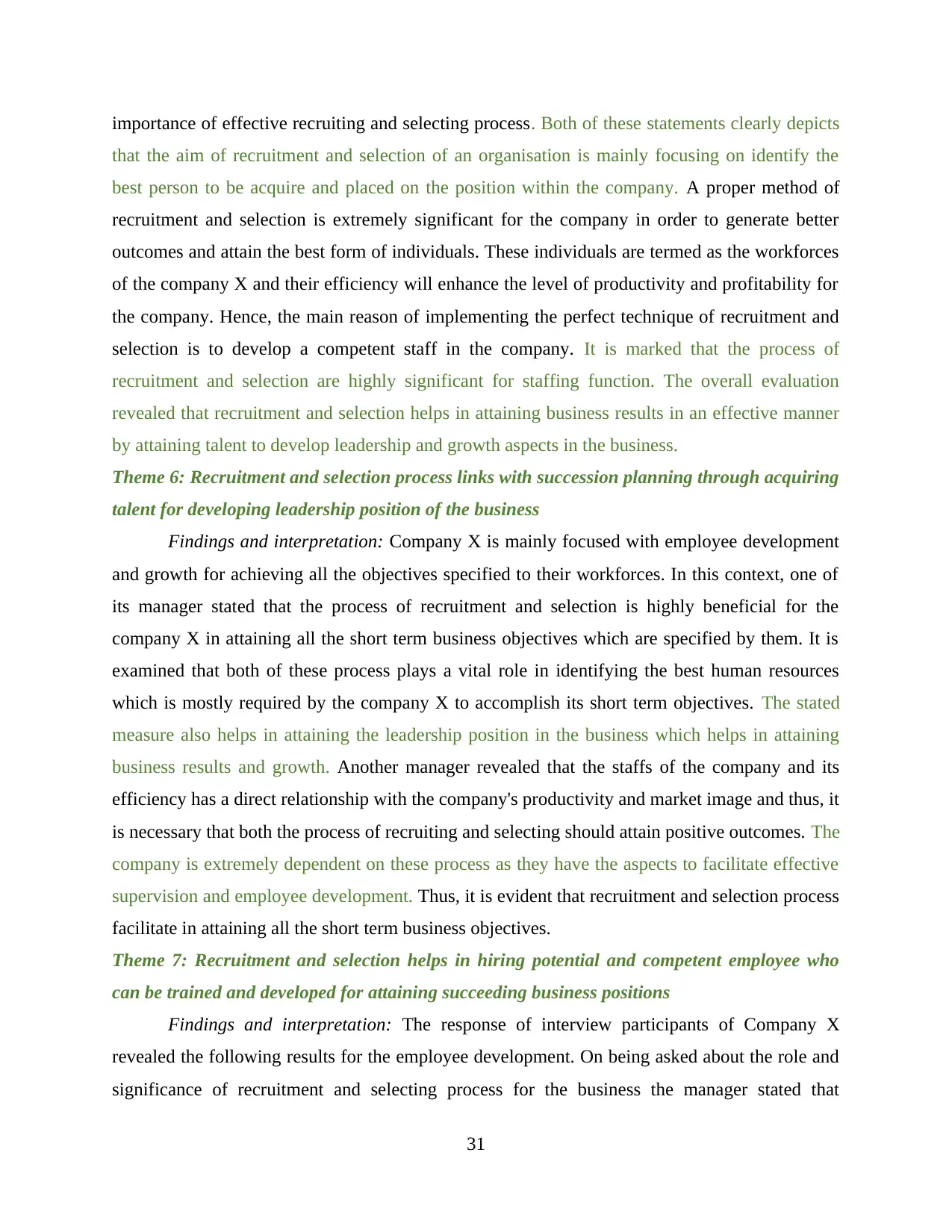
importance of effective recruiting and selecting process. Both of these statements clearly depicts
that the aim of recruitment and selection of an organisation is mainly focusing on identify the
best person to be acquire and placed on the position within the company. A proper method of
recruitment and selection is extremely significant for the company in order to generate better
outcomes and attain the best form of individuals. These individuals are termed as the workforces
of the company X and their efficiency will enhance the level of productivity and profitability for
the company. Hence, the main reason of implementing the perfect technique of recruitment and
selection is to develop a competent staff in the company. It is marked that the process of
recruitment and selection are highly significant for staffing function. The overall evaluation
revealed that recruitment and selection helps in attaining business results in an effective manner
by attaining talent to develop leadership and growth aspects in the business.
Theme 6: Recruitment and selection process links with succession planning through acquiring
talent for developing leadership position of the business
Findings and interpretation: Company X is mainly focused with employee development
and growth for achieving all the objectives specified to their workforces. In this context, one of
its manager stated that the process of recruitment and selection is highly beneficial for the
company X in attaining all the short term business objectives which are specified by them. It is
examined that both of these process plays a vital role in identifying the best human resources
which is mostly required by the company X to accomplish its short term objectives. The stated
measure also helps in attaining the leadership position in the business which helps in attaining
business results and growth. Another manager revealed that the staffs of the company and its
efficiency has a direct relationship with the company's productivity and market image and thus, it
is necessary that both the process of recruiting and selecting should attain positive outcomes. The
company is extremely dependent on these process as they have the aspects to facilitate effective
supervision and employee development. Thus, it is evident that recruitment and selection process
facilitate in attaining all the short term business objectives.
Theme 7: Recruitment and selection helps in hiring potential and competent employee who
can be trained and developed for attaining succeeding business positions
Findings and interpretation: The response of interview participants of Company X
revealed the following results for the employee development. On being asked about the role and
significance of recruitment and selecting process for the business the manager stated that
31
that the aim of recruitment and selection of an organisation is mainly focusing on identify the
best person to be acquire and placed on the position within the company. A proper method of
recruitment and selection is extremely significant for the company in order to generate better
outcomes and attain the best form of individuals. These individuals are termed as the workforces
of the company X and their efficiency will enhance the level of productivity and profitability for
the company. Hence, the main reason of implementing the perfect technique of recruitment and
selection is to develop a competent staff in the company. It is marked that the process of
recruitment and selection are highly significant for staffing function. The overall evaluation
revealed that recruitment and selection helps in attaining business results in an effective manner
by attaining talent to develop leadership and growth aspects in the business.
Theme 6: Recruitment and selection process links with succession planning through acquiring
talent for developing leadership position of the business
Findings and interpretation: Company X is mainly focused with employee development
and growth for achieving all the objectives specified to their workforces. In this context, one of
its manager stated that the process of recruitment and selection is highly beneficial for the
company X in attaining all the short term business objectives which are specified by them. It is
examined that both of these process plays a vital role in identifying the best human resources
which is mostly required by the company X to accomplish its short term objectives. The stated
measure also helps in attaining the leadership position in the business which helps in attaining
business results and growth. Another manager revealed that the staffs of the company and its
efficiency has a direct relationship with the company's productivity and market image and thus, it
is necessary that both the process of recruiting and selecting should attain positive outcomes. The
company is extremely dependent on these process as they have the aspects to facilitate effective
supervision and employee development. Thus, it is evident that recruitment and selection process
facilitate in attaining all the short term business objectives.
Theme 7: Recruitment and selection helps in hiring potential and competent employee who
can be trained and developed for attaining succeeding business positions
Findings and interpretation: The response of interview participants of Company X
revealed the following results for the employee development. On being asked about the role and
significance of recruitment and selecting process for the business the manager stated that
31
Secure Best Marks with AI Grader
Need help grading? Try our AI Grader for instant feedback on your assignments.
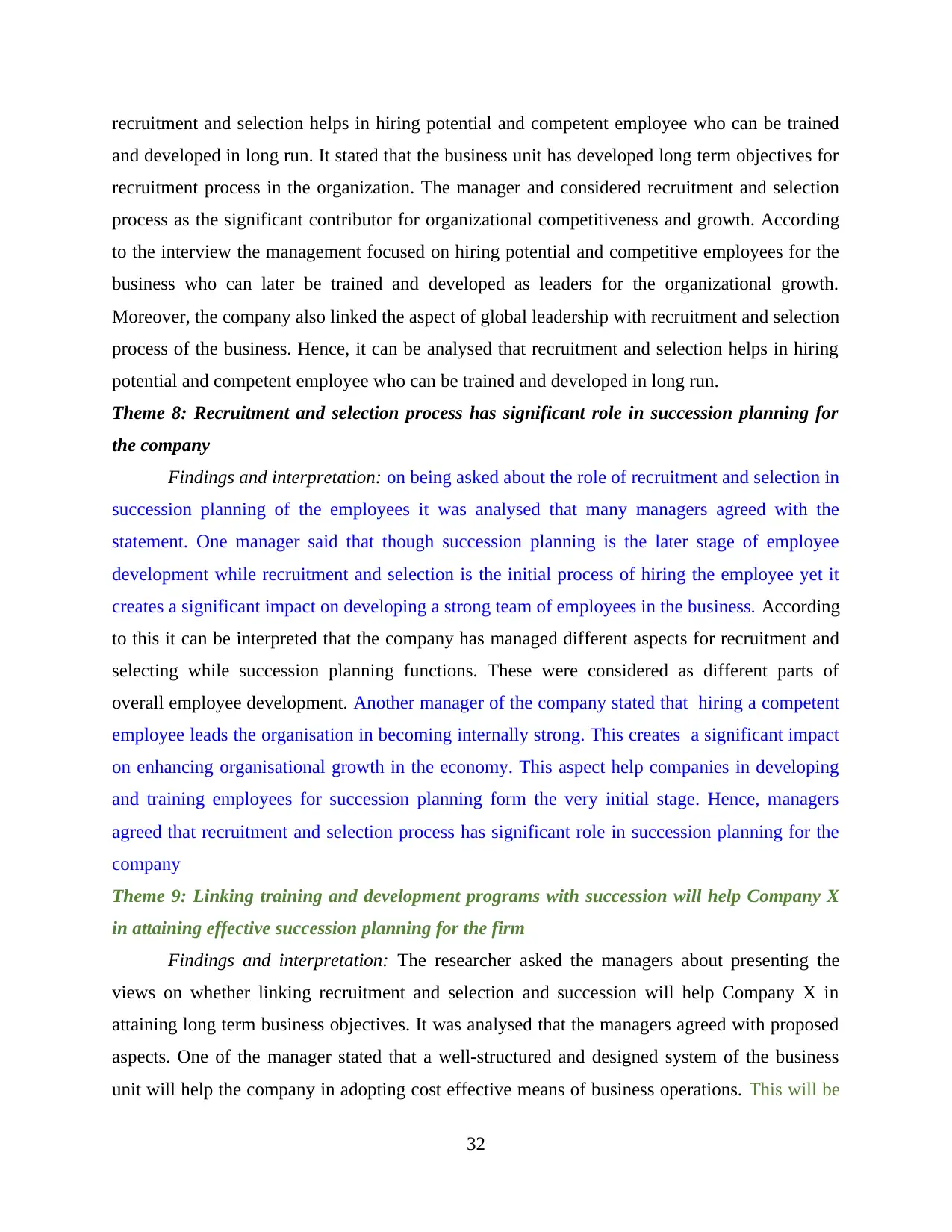
recruitment and selection helps in hiring potential and competent employee who can be trained
and developed in long run. It stated that the business unit has developed long term objectives for
recruitment process in the organization. The manager and considered recruitment and selection
process as the significant contributor for organizational competitiveness and growth. According
to the interview the management focused on hiring potential and competitive employees for the
business who can later be trained and developed as leaders for the organizational growth.
Moreover, the company also linked the aspect of global leadership with recruitment and selection
process of the business. Hence, it can be analysed that recruitment and selection helps in hiring
potential and competent employee who can be trained and developed in long run.
Theme 8: Recruitment and selection process has significant role in succession planning for
the company
Findings and interpretation: on being asked about the role of recruitment and selection in
succession planning of the employees it was analysed that many managers agreed with the
statement. One manager said that though succession planning is the later stage of employee
development while recruitment and selection is the initial process of hiring the employee yet it
creates a significant impact on developing a strong team of employees in the business. According
to this it can be interpreted that the company has managed different aspects for recruitment and
selecting while succession planning functions. These were considered as different parts of
overall employee development. Another manager of the company stated that hiring a competent
employee leads the organisation in becoming internally strong. This creates a significant impact
on enhancing organisational growth in the economy. This aspect help companies in developing
and training employees for succession planning form the very initial stage. Hence, managers
agreed that recruitment and selection process has significant role in succession planning for the
company
Theme 9: Linking training and development programs with succession will help Company X
in attaining effective succession planning for the firm
Findings and interpretation: The researcher asked the managers about presenting the
views on whether linking recruitment and selection and succession will help Company X in
attaining long term business objectives. It was analysed that the managers agreed with proposed
aspects. One of the manager stated that a well-structured and designed system of the business
unit will help the company in adopting cost effective means of business operations. This will be
32
and developed in long run. It stated that the business unit has developed long term objectives for
recruitment process in the organization. The manager and considered recruitment and selection
process as the significant contributor for organizational competitiveness and growth. According
to the interview the management focused on hiring potential and competitive employees for the
business who can later be trained and developed as leaders for the organizational growth.
Moreover, the company also linked the aspect of global leadership with recruitment and selection
process of the business. Hence, it can be analysed that recruitment and selection helps in hiring
potential and competent employee who can be trained and developed in long run.
Theme 8: Recruitment and selection process has significant role in succession planning for
the company
Findings and interpretation: on being asked about the role of recruitment and selection in
succession planning of the employees it was analysed that many managers agreed with the
statement. One manager said that though succession planning is the later stage of employee
development while recruitment and selection is the initial process of hiring the employee yet it
creates a significant impact on developing a strong team of employees in the business. According
to this it can be interpreted that the company has managed different aspects for recruitment and
selecting while succession planning functions. These were considered as different parts of
overall employee development. Another manager of the company stated that hiring a competent
employee leads the organisation in becoming internally strong. This creates a significant impact
on enhancing organisational growth in the economy. This aspect help companies in developing
and training employees for succession planning form the very initial stage. Hence, managers
agreed that recruitment and selection process has significant role in succession planning for the
company
Theme 9: Linking training and development programs with succession will help Company X
in attaining effective succession planning for the firm
Findings and interpretation: The researcher asked the managers about presenting the
views on whether linking recruitment and selection and succession will help Company X in
attaining long term business objectives. It was analysed that the managers agreed with proposed
aspects. One of the manager stated that a well-structured and designed system of the business
unit will help the company in adopting cost effective means of business operations. This will be
32
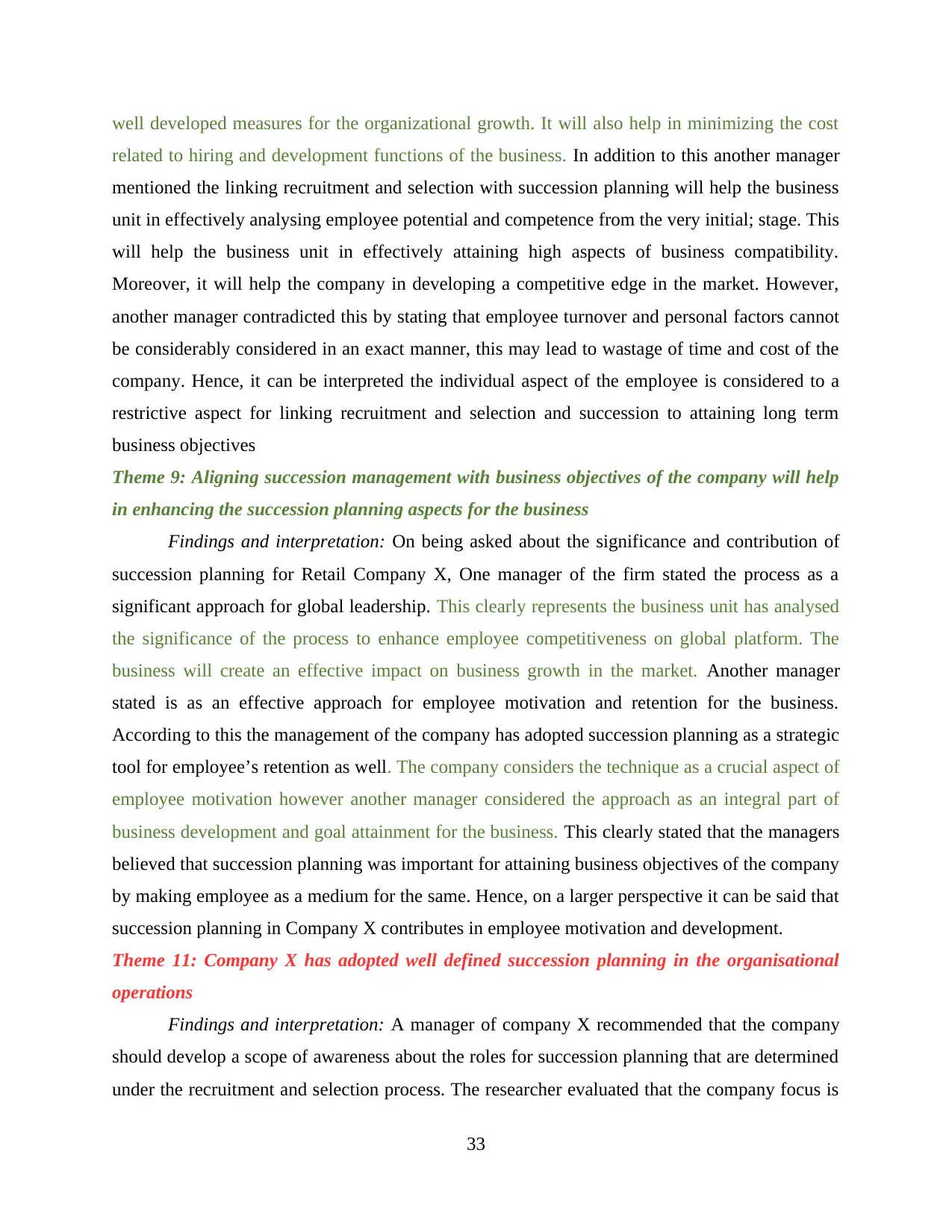
well developed measures for the organizational growth. It will also help in minimizing the cost
related to hiring and development functions of the business. In addition to this another manager
mentioned the linking recruitment and selection with succession planning will help the business
unit in effectively analysing employee potential and competence from the very initial; stage. This
will help the business unit in effectively attaining high aspects of business compatibility.
Moreover, it will help the company in developing a competitive edge in the market. However,
another manager contradicted this by stating that employee turnover and personal factors cannot
be considerably considered in an exact manner, this may lead to wastage of time and cost of the
company. Hence, it can be interpreted the individual aspect of the employee is considered to a
restrictive aspect for linking recruitment and selection and succession to attaining long term
business objectives
Theme 9: Aligning succession management with business objectives of the company will help
in enhancing the succession planning aspects for the business
Findings and interpretation: On being asked about the significance and contribution of
succession planning for Retail Company X, One manager of the firm stated the process as a
significant approach for global leadership. This clearly represents the business unit has analysed
the significance of the process to enhance employee competitiveness on global platform. The
business will create an effective impact on business growth in the market. Another manager
stated is as an effective approach for employee motivation and retention for the business.
According to this the management of the company has adopted succession planning as a strategic
tool for employee’s retention as well. The company considers the technique as a crucial aspect of
employee motivation however another manager considered the approach as an integral part of
business development and goal attainment for the business. This clearly stated that the managers
believed that succession planning was important for attaining business objectives of the company
by making employee as a medium for the same. Hence, on a larger perspective it can be said that
succession planning in Company X contributes in employee motivation and development.
Theme 11: Company X has adopted well defined succession planning in the organisational
operations
Findings and interpretation: A manager of company X recommended that the company
should develop a scope of awareness about the roles for succession planning that are determined
under the recruitment and selection process. The researcher evaluated that the company focus is
33
related to hiring and development functions of the business. In addition to this another manager
mentioned the linking recruitment and selection with succession planning will help the business
unit in effectively analysing employee potential and competence from the very initial; stage. This
will help the business unit in effectively attaining high aspects of business compatibility.
Moreover, it will help the company in developing a competitive edge in the market. However,
another manager contradicted this by stating that employee turnover and personal factors cannot
be considerably considered in an exact manner, this may lead to wastage of time and cost of the
company. Hence, it can be interpreted the individual aspect of the employee is considered to a
restrictive aspect for linking recruitment and selection and succession to attaining long term
business objectives
Theme 9: Aligning succession management with business objectives of the company will help
in enhancing the succession planning aspects for the business
Findings and interpretation: On being asked about the significance and contribution of
succession planning for Retail Company X, One manager of the firm stated the process as a
significant approach for global leadership. This clearly represents the business unit has analysed
the significance of the process to enhance employee competitiveness on global platform. The
business will create an effective impact on business growth in the market. Another manager
stated is as an effective approach for employee motivation and retention for the business.
According to this the management of the company has adopted succession planning as a strategic
tool for employee’s retention as well. The company considers the technique as a crucial aspect of
employee motivation however another manager considered the approach as an integral part of
business development and goal attainment for the business. This clearly stated that the managers
believed that succession planning was important for attaining business objectives of the company
by making employee as a medium for the same. Hence, on a larger perspective it can be said that
succession planning in Company X contributes in employee motivation and development.
Theme 11: Company X has adopted well defined succession planning in the organisational
operations
Findings and interpretation: A manager of company X recommended that the company
should develop a scope of awareness about the roles for succession planning that are determined
under the recruitment and selection process. The researcher evaluated that the company focus is
33
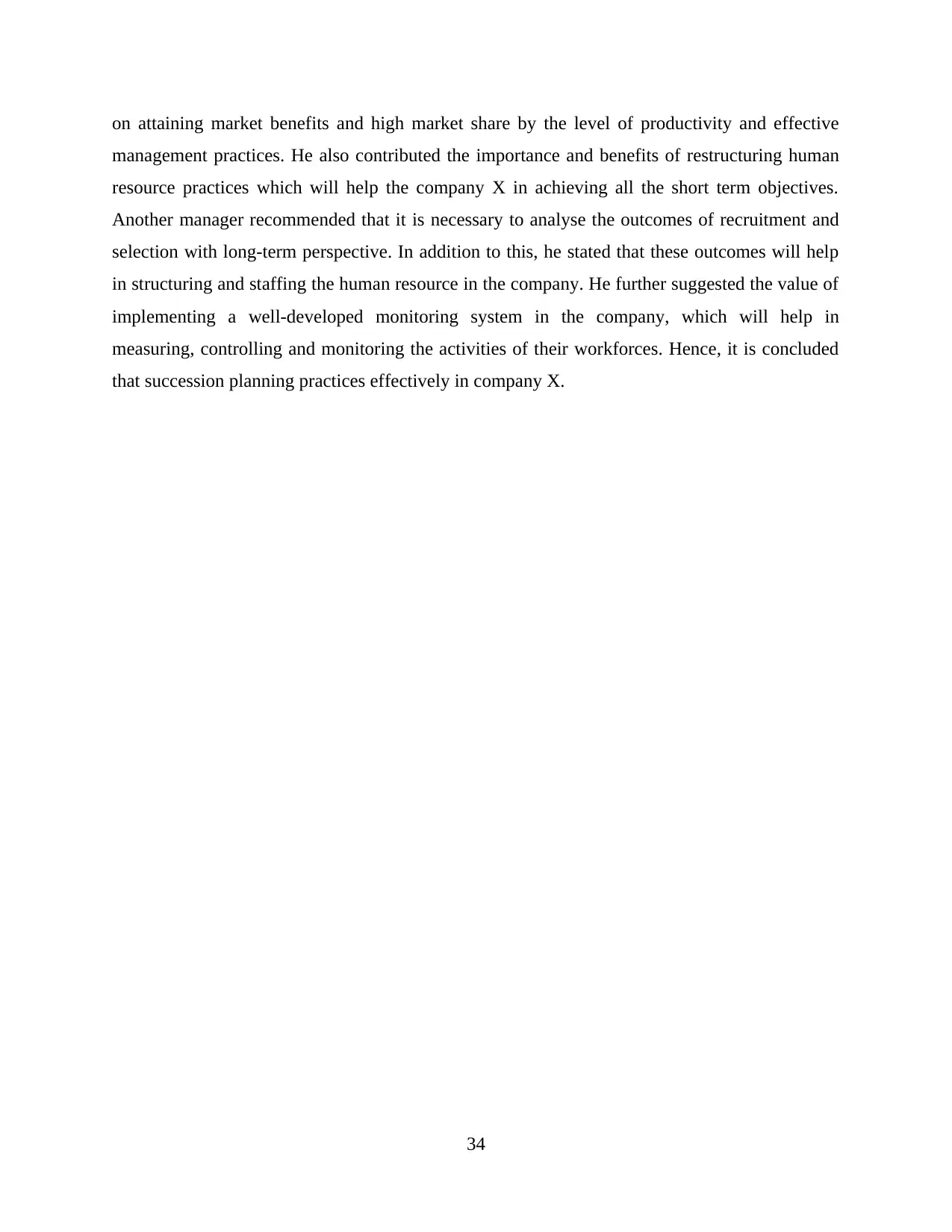
on attaining market benefits and high market share by the level of productivity and effective
management practices. He also contributed the importance and benefits of restructuring human
resource practices which will help the company X in achieving all the short term objectives.
Another manager recommended that it is necessary to analyse the outcomes of recruitment and
selection with long-term perspective. In addition to this, he stated that these outcomes will help
in structuring and staffing the human resource in the company. He further suggested the value of
implementing a well-developed monitoring system in the company, which will help in
measuring, controlling and monitoring the activities of their workforces. Hence, it is concluded
that succession planning practices effectively in company X.
34
management practices. He also contributed the importance and benefits of restructuring human
resource practices which will help the company X in achieving all the short term objectives.
Another manager recommended that it is necessary to analyse the outcomes of recruitment and
selection with long-term perspective. In addition to this, he stated that these outcomes will help
in structuring and staffing the human resource in the company. He further suggested the value of
implementing a well-developed monitoring system in the company, which will help in
measuring, controlling and monitoring the activities of their workforces. Hence, it is concluded
that succession planning practices effectively in company X.
34
Paraphrase This Document
Need a fresh take? Get an instant paraphrase of this document with our AI Paraphraser
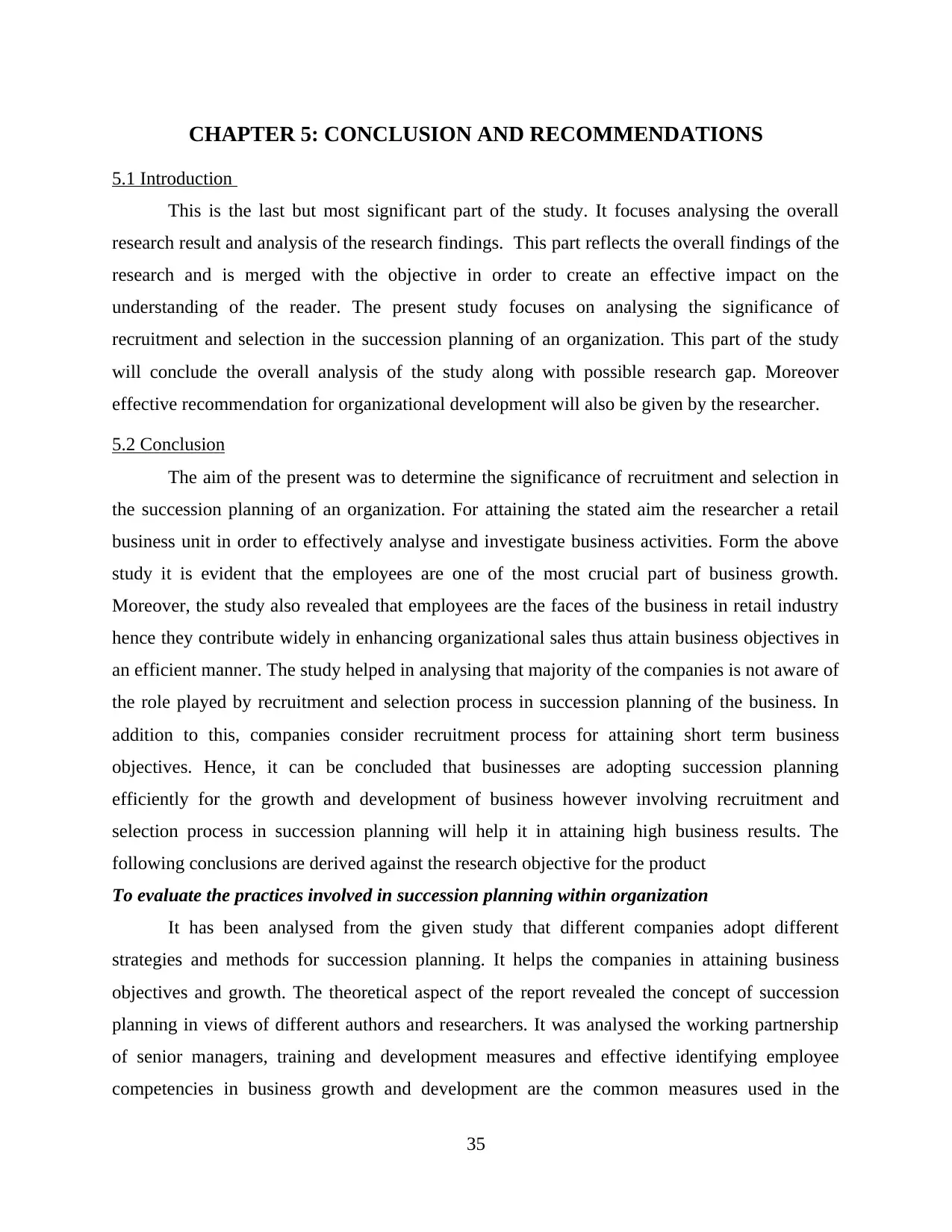
CHAPTER 5: CONCLUSION AND RECOMMENDATIONS
5.1 Introduction
This is the last but most significant part of the study. It focuses analysing the overall
research result and analysis of the research findings. This part reflects the overall findings of the
research and is merged with the objective in order to create an effective impact on the
understanding of the reader. The present study focuses on analysing the significance of
recruitment and selection in the succession planning of an organization. This part of the study
will conclude the overall analysis of the study along with possible research gap. Moreover
effective recommendation for organizational development will also be given by the researcher.
5.2 Conclusion
The aim of the present was to determine the significance of recruitment and selection in
the succession planning of an organization. For attaining the stated aim the researcher a retail
business unit in order to effectively analyse and investigate business activities. Form the above
study it is evident that the employees are one of the most crucial part of business growth.
Moreover, the study also revealed that employees are the faces of the business in retail industry
hence they contribute widely in enhancing organizational sales thus attain business objectives in
an efficient manner. The study helped in analysing that majority of the companies is not aware of
the role played by recruitment and selection process in succession planning of the business. In
addition to this, companies consider recruitment process for attaining short term business
objectives. Hence, it can be concluded that businesses are adopting succession planning
efficiently for the growth and development of business however involving recruitment and
selection process in succession planning will help it in attaining high business results. The
following conclusions are derived against the research objective for the product
To evaluate the practices involved in succession planning within organization
It has been analysed from the given study that different companies adopt different
strategies and methods for succession planning. It helps the companies in attaining business
objectives and growth. The theoretical aspect of the report revealed the concept of succession
planning in views of different authors and researchers. It was analysed the working partnership
of senior managers, training and development measures and effective identifying employee
competencies in business growth and development are the common measures used in the
35
5.1 Introduction
This is the last but most significant part of the study. It focuses analysing the overall
research result and analysis of the research findings. This part reflects the overall findings of the
research and is merged with the objective in order to create an effective impact on the
understanding of the reader. The present study focuses on analysing the significance of
recruitment and selection in the succession planning of an organization. This part of the study
will conclude the overall analysis of the study along with possible research gap. Moreover
effective recommendation for organizational development will also be given by the researcher.
5.2 Conclusion
The aim of the present was to determine the significance of recruitment and selection in
the succession planning of an organization. For attaining the stated aim the researcher a retail
business unit in order to effectively analyse and investigate business activities. Form the above
study it is evident that the employees are one of the most crucial part of business growth.
Moreover, the study also revealed that employees are the faces of the business in retail industry
hence they contribute widely in enhancing organizational sales thus attain business objectives in
an efficient manner. The study helped in analysing that majority of the companies is not aware of
the role played by recruitment and selection process in succession planning of the business. In
addition to this, companies consider recruitment process for attaining short term business
objectives. Hence, it can be concluded that businesses are adopting succession planning
efficiently for the growth and development of business however involving recruitment and
selection process in succession planning will help it in attaining high business results. The
following conclusions are derived against the research objective for the product
To evaluate the practices involved in succession planning within organization
It has been analysed from the given study that different companies adopt different
strategies and methods for succession planning. It helps the companies in attaining business
objectives and growth. The theoretical aspect of the report revealed the concept of succession
planning in views of different authors and researchers. It was analysed the working partnership
of senior managers, training and development measures and effective identifying employee
competencies in business growth and development are the common measures used in the
35
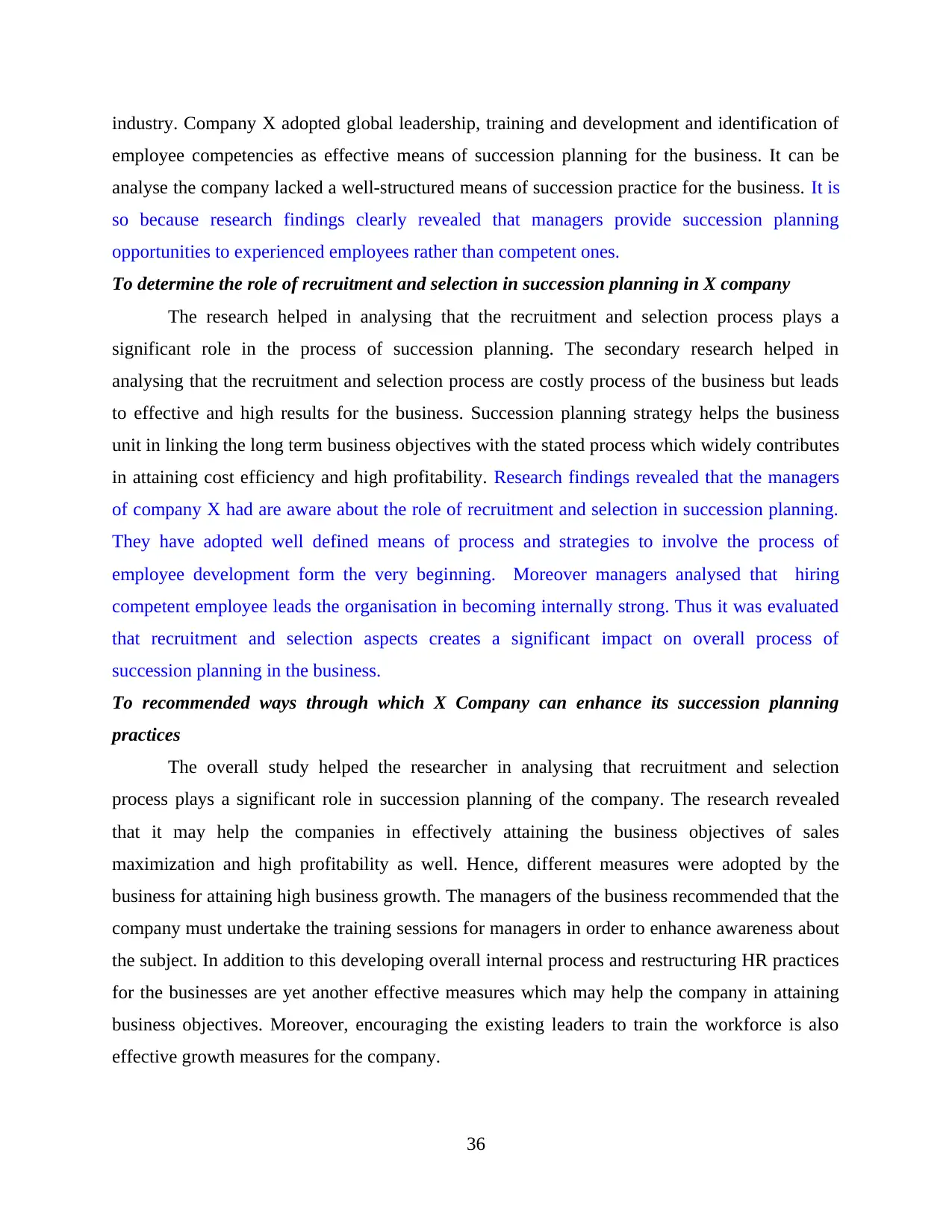
industry. Company X adopted global leadership, training and development and identification of
employee competencies as effective means of succession planning for the business. It can be
analyse the company lacked a well-structured means of succession practice for the business. It is
so because research findings clearly revealed that managers provide succession planning
opportunities to experienced employees rather than competent ones.
To determine the role of recruitment and selection in succession planning in X company
The research helped in analysing that the recruitment and selection process plays a
significant role in the process of succession planning. The secondary research helped in
analysing that the recruitment and selection process are costly process of the business but leads
to effective and high results for the business. Succession planning strategy helps the business
unit in linking the long term business objectives with the stated process which widely contributes
in attaining cost efficiency and high profitability. Research findings revealed that the managers
of company X had are aware about the role of recruitment and selection in succession planning.
They have adopted well defined means of process and strategies to involve the process of
employee development form the very beginning. Moreover managers analysed that hiring
competent employee leads the organisation in becoming internally strong. Thus it was evaluated
that recruitment and selection aspects creates a significant impact on overall process of
succession planning in the business.
To recommended ways through which X Company can enhance its succession planning
practices
The overall study helped the researcher in analysing that recruitment and selection
process plays a significant role in succession planning of the company. The research revealed
that it may help the companies in effectively attaining the business objectives of sales
maximization and high profitability as well. Hence, different measures were adopted by the
business for attaining high business growth. The managers of the business recommended that the
company must undertake the training sessions for managers in order to enhance awareness about
the subject. In addition to this developing overall internal process and restructuring HR practices
for the businesses are yet another effective measures which may help the company in attaining
business objectives. Moreover, encouraging the existing leaders to train the workforce is also
effective growth measures for the company.
36
employee competencies as effective means of succession planning for the business. It can be
analyse the company lacked a well-structured means of succession practice for the business. It is
so because research findings clearly revealed that managers provide succession planning
opportunities to experienced employees rather than competent ones.
To determine the role of recruitment and selection in succession planning in X company
The research helped in analysing that the recruitment and selection process plays a
significant role in the process of succession planning. The secondary research helped in
analysing that the recruitment and selection process are costly process of the business but leads
to effective and high results for the business. Succession planning strategy helps the business
unit in linking the long term business objectives with the stated process which widely contributes
in attaining cost efficiency and high profitability. Research findings revealed that the managers
of company X had are aware about the role of recruitment and selection in succession planning.
They have adopted well defined means of process and strategies to involve the process of
employee development form the very beginning. Moreover managers analysed that hiring
competent employee leads the organisation in becoming internally strong. Thus it was evaluated
that recruitment and selection aspects creates a significant impact on overall process of
succession planning in the business.
To recommended ways through which X Company can enhance its succession planning
practices
The overall study helped the researcher in analysing that recruitment and selection
process plays a significant role in succession planning of the company. The research revealed
that it may help the companies in effectively attaining the business objectives of sales
maximization and high profitability as well. Hence, different measures were adopted by the
business for attaining high business growth. The managers of the business recommended that the
company must undertake the training sessions for managers in order to enhance awareness about
the subject. In addition to this developing overall internal process and restructuring HR practices
for the businesses are yet another effective measures which may help the company in attaining
business objectives. Moreover, encouraging the existing leaders to train the workforce is also
effective growth measures for the company.
36
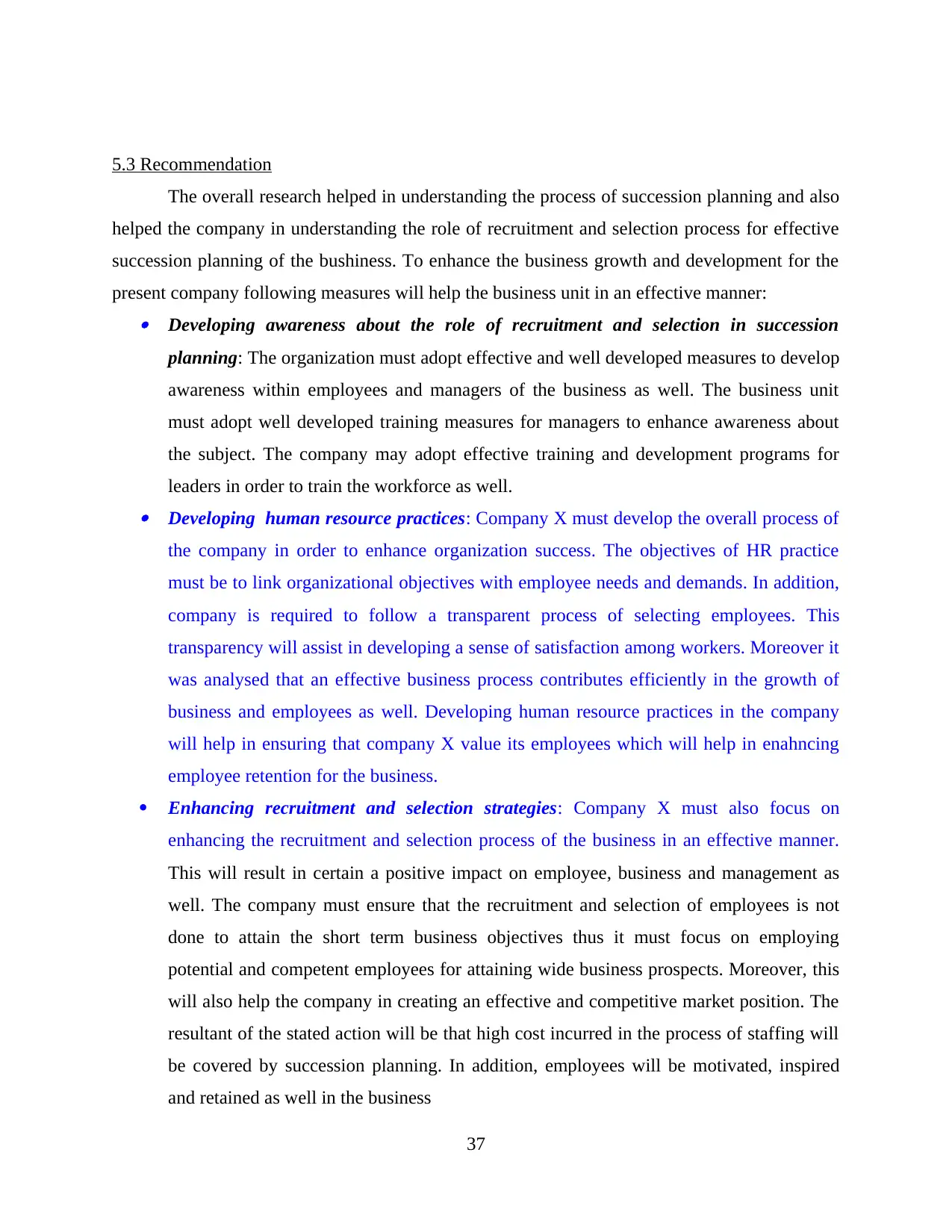
5.3 Recommendation
The overall research helped in understanding the process of succession planning and also
helped the company in understanding the role of recruitment and selection process for effective
succession planning of the bushiness. To enhance the business growth and development for the
present company following measures will help the business unit in an effective manner: Developing awareness about the role of recruitment and selection in succession
planning: The organization must adopt effective and well developed measures to develop
awareness within employees and managers of the business as well. The business unit
must adopt well developed training measures for managers to enhance awareness about
the subject. The company may adopt effective training and development programs for
leaders in order to train the workforce as well. Developing human resource practices: Company X must develop the overall process of
the company in order to enhance organization success. The objectives of HR practice
must be to link organizational objectives with employee needs and demands. In addition,
company is required to follow a transparent process of selecting employees. This
transparency will assist in developing a sense of satisfaction among workers. Moreover it
was analysed that an effective business process contributes efficiently in the growth of
business and employees as well. Developing human resource practices in the company
will help in ensuring that company X value its employees which will help in enahncing
employee retention for the business.
Enhancing recruitment and selection strategies: Company X must also focus on
enhancing the recruitment and selection process of the business in an effective manner.
This will result in certain a positive impact on employee, business and management as
well. The company must ensure that the recruitment and selection of employees is not
done to attain the short term business objectives thus it must focus on employing
potential and competent employees for attaining wide business prospects. Moreover, this
will also help the company in creating an effective and competitive market position. The
resultant of the stated action will be that high cost incurred in the process of staffing will
be covered by succession planning. In addition, employees will be motivated, inspired
and retained as well in the business
37
The overall research helped in understanding the process of succession planning and also
helped the company in understanding the role of recruitment and selection process for effective
succession planning of the bushiness. To enhance the business growth and development for the
present company following measures will help the business unit in an effective manner: Developing awareness about the role of recruitment and selection in succession
planning: The organization must adopt effective and well developed measures to develop
awareness within employees and managers of the business as well. The business unit
must adopt well developed training measures for managers to enhance awareness about
the subject. The company may adopt effective training and development programs for
leaders in order to train the workforce as well. Developing human resource practices: Company X must develop the overall process of
the company in order to enhance organization success. The objectives of HR practice
must be to link organizational objectives with employee needs and demands. In addition,
company is required to follow a transparent process of selecting employees. This
transparency will assist in developing a sense of satisfaction among workers. Moreover it
was analysed that an effective business process contributes efficiently in the growth of
business and employees as well. Developing human resource practices in the company
will help in ensuring that company X value its employees which will help in enahncing
employee retention for the business.
Enhancing recruitment and selection strategies: Company X must also focus on
enhancing the recruitment and selection process of the business in an effective manner.
This will result in certain a positive impact on employee, business and management as
well. The company must ensure that the recruitment and selection of employees is not
done to attain the short term business objectives thus it must focus on employing
potential and competent employees for attaining wide business prospects. Moreover, this
will also help the company in creating an effective and competitive market position. The
resultant of the stated action will be that high cost incurred in the process of staffing will
be covered by succession planning. In addition, employees will be motivated, inspired
and retained as well in the business
37
Secure Best Marks with AI Grader
Need help grading? Try our AI Grader for instant feedback on your assignments.
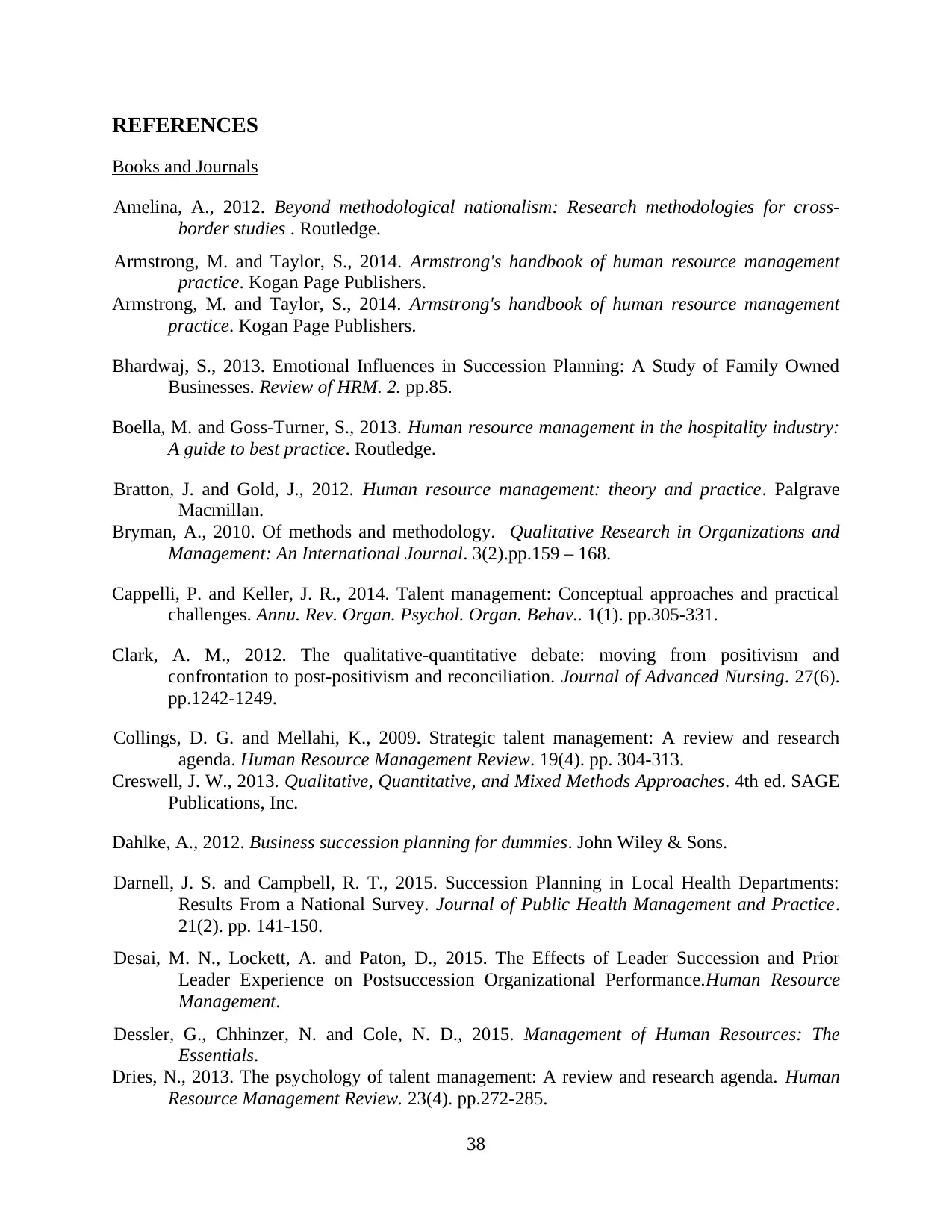
REFERENCES
Books and Journals
Amelina, A., 2012. Beyond methodological nationalism: Research methodologies for cross-
border studies . Routledge.
Armstrong, M. and Taylor, S., 2014. Armstrong's handbook of human resource management
practice. Kogan Page Publishers.
Armstrong, M. and Taylor, S., 2014. Armstrong's handbook of human resource management
practice. Kogan Page Publishers.
Bhardwaj, S., 2013. Emotional Influences in Succession Planning: A Study of Family Owned
Businesses. Review of HRM. 2. pp.85.
Boella, M. and Goss-Turner, S., 2013. Human resource management in the hospitality industry:
A guide to best practice. Routledge.
Bratton, J. and Gold, J., 2012. Human resource management: theory and practice. Palgrave
Macmillan.
Bryman, A., 2010. Of methods and methodology. Qualitative Research in Organizations and
Management: An International Journal. 3(2).pp.159 – 168.
Cappelli, P. and Keller, J. R., 2014. Talent management: Conceptual approaches and practical
challenges. Annu. Rev. Organ. Psychol. Organ. Behav.. 1(1). pp.305-331.
Clark, A. M., 2012. The qualitative-quantitative debate: moving from positivism and
confrontation to post-positivism and reconciliation. Journal of Advanced Nursing. 27(6).
pp.1242-1249.
Collings, D. G. and Mellahi, K., 2009. Strategic talent management: A review and research
agenda. Human Resource Management Review. 19(4). pp. 304-313.
Creswell, J. W., 2013. Qualitative, Quantitative, and Mixed Methods Approaches. 4th ed. SAGE
Publications, Inc.
Dahlke, A., 2012. Business succession planning for dummies. John Wiley & Sons.
Darnell, J. S. and Campbell, R. T., 2015. Succession Planning in Local Health Departments:
Results From a National Survey. Journal of Public Health Management and Practice.
21(2). pp. 141-150.
Desai, M. N., Lockett, A. and Paton, D., 2015. The Effects of Leader Succession and Prior
Leader Experience on Postsuccession Organizational Performance.Human Resource
Management.
Dessler, G., Chhinzer, N. and Cole, N. D., 2015. Management of Human Resources: The
Essentials.
Dries, N., 2013. The psychology of talent management: A review and research agenda. Human
Resource Management Review. 23(4). pp.272-285.
38
Books and Journals
Amelina, A., 2012. Beyond methodological nationalism: Research methodologies for cross-
border studies . Routledge.
Armstrong, M. and Taylor, S., 2014. Armstrong's handbook of human resource management
practice. Kogan Page Publishers.
Armstrong, M. and Taylor, S., 2014. Armstrong's handbook of human resource management
practice. Kogan Page Publishers.
Bhardwaj, S., 2013. Emotional Influences in Succession Planning: A Study of Family Owned
Businesses. Review of HRM. 2. pp.85.
Boella, M. and Goss-Turner, S., 2013. Human resource management in the hospitality industry:
A guide to best practice. Routledge.
Bratton, J. and Gold, J., 2012. Human resource management: theory and practice. Palgrave
Macmillan.
Bryman, A., 2010. Of methods and methodology. Qualitative Research in Organizations and
Management: An International Journal. 3(2).pp.159 – 168.
Cappelli, P. and Keller, J. R., 2014. Talent management: Conceptual approaches and practical
challenges. Annu. Rev. Organ. Psychol. Organ. Behav.. 1(1). pp.305-331.
Clark, A. M., 2012. The qualitative-quantitative debate: moving from positivism and
confrontation to post-positivism and reconciliation. Journal of Advanced Nursing. 27(6).
pp.1242-1249.
Collings, D. G. and Mellahi, K., 2009. Strategic talent management: A review and research
agenda. Human Resource Management Review. 19(4). pp. 304-313.
Creswell, J. W., 2013. Qualitative, Quantitative, and Mixed Methods Approaches. 4th ed. SAGE
Publications, Inc.
Dahlke, A., 2012. Business succession planning for dummies. John Wiley & Sons.
Darnell, J. S. and Campbell, R. T., 2015. Succession Planning in Local Health Departments:
Results From a National Survey. Journal of Public Health Management and Practice.
21(2). pp. 141-150.
Desai, M. N., Lockett, A. and Paton, D., 2015. The Effects of Leader Succession and Prior
Leader Experience on Postsuccession Organizational Performance.Human Resource
Management.
Dessler, G., Chhinzer, N. and Cole, N. D., 2015. Management of Human Resources: The
Essentials.
Dries, N., 2013. The psychology of talent management: A review and research agenda. Human
Resource Management Review. 23(4). pp.272-285.
38
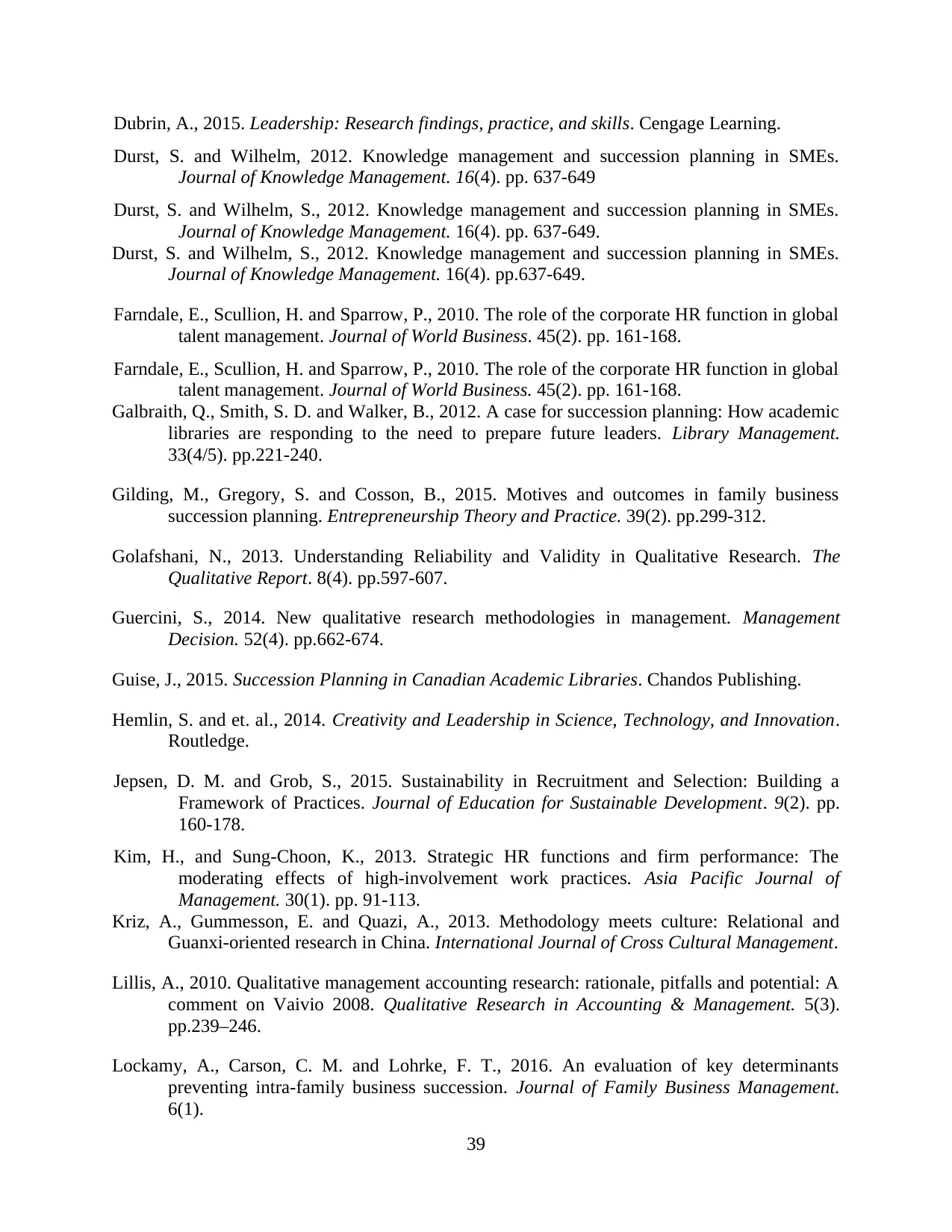
Dubrin, A., 2015. Leadership: Research findings, practice, and skills. Cengage Learning.
Durst, S. and Wilhelm, 2012. Knowledge management and succession planning in SMEs.
Journal of Knowledge Management. 16(4). pp. 637-649
Durst, S. and Wilhelm, S., 2012. Knowledge management and succession planning in SMEs.
Journal of Knowledge Management. 16(4). pp. 637-649.
Durst, S. and Wilhelm, S., 2012. Knowledge management and succession planning in SMEs.
Journal of Knowledge Management. 16(4). pp.637-649.
Farndale, E., Scullion, H. and Sparrow, P., 2010. The role of the corporate HR function in global
talent management. Journal of World Business. 45(2). pp. 161-168.
Farndale, E., Scullion, H. and Sparrow, P., 2010. The role of the corporate HR function in global
talent management. Journal of World Business. 45(2). pp. 161-168.
Galbraith, Q., Smith, S. D. and Walker, B., 2012. A case for succession planning: How academic
libraries are responding to the need to prepare future leaders. Library Management.
33(4/5). pp.221-240.
Gilding, M., Gregory, S. and Cosson, B., 2015. Motives and outcomes in family business
succession planning. Entrepreneurship Theory and Practice. 39(2). pp.299-312.
Golafshani, N., 2013. Understanding Reliability and Validity in Qualitative Research. The
Qualitative Report. 8(4). pp.597-607.
Guercini, S., 2014. New qualitative research methodologies in management. Management
Decision. 52(4). pp.662-674.
Guise, J., 2015. Succession Planning in Canadian Academic Libraries. Chandos Publishing.
Hemlin, S. and et. al., 2014. Creativity and Leadership in Science, Technology, and Innovation.
Routledge.
Jepsen, D. M. and Grob, S., 2015. Sustainability in Recruitment and Selection: Building a
Framework of Practices. Journal of Education for Sustainable Development. 9(2). pp.
160-178.
Kim, H., and Sung-Choon, K., 2013. Strategic HR functions and firm performance: The
moderating effects of high-involvement work practices. Asia Pacific Journal of
Management. 30(1). pp. 91-113.
Kriz, A., Gummesson, E. and Quazi, A., 2013. Methodology meets culture: Relational and
Guanxi-oriented research in China. International Journal of Cross Cultural Management.
Lillis, A., 2010. Qualitative management accounting research: rationale, pitfalls and potential: A
comment on Vaivio 2008. Qualitative Research in Accounting & Management. 5(3).
pp.239–246.
Lockamy, A., Carson, C. M. and Lohrke, F. T., 2016. An evaluation of key determinants
preventing intra-family business succession. Journal of Family Business Management.
6(1).
39
Durst, S. and Wilhelm, 2012. Knowledge management and succession planning in SMEs.
Journal of Knowledge Management. 16(4). pp. 637-649
Durst, S. and Wilhelm, S., 2012. Knowledge management and succession planning in SMEs.
Journal of Knowledge Management. 16(4). pp. 637-649.
Durst, S. and Wilhelm, S., 2012. Knowledge management and succession planning in SMEs.
Journal of Knowledge Management. 16(4). pp.637-649.
Farndale, E., Scullion, H. and Sparrow, P., 2010. The role of the corporate HR function in global
talent management. Journal of World Business. 45(2). pp. 161-168.
Farndale, E., Scullion, H. and Sparrow, P., 2010. The role of the corporate HR function in global
talent management. Journal of World Business. 45(2). pp. 161-168.
Galbraith, Q., Smith, S. D. and Walker, B., 2012. A case for succession planning: How academic
libraries are responding to the need to prepare future leaders. Library Management.
33(4/5). pp.221-240.
Gilding, M., Gregory, S. and Cosson, B., 2015. Motives and outcomes in family business
succession planning. Entrepreneurship Theory and Practice. 39(2). pp.299-312.
Golafshani, N., 2013. Understanding Reliability and Validity in Qualitative Research. The
Qualitative Report. 8(4). pp.597-607.
Guercini, S., 2014. New qualitative research methodologies in management. Management
Decision. 52(4). pp.662-674.
Guise, J., 2015. Succession Planning in Canadian Academic Libraries. Chandos Publishing.
Hemlin, S. and et. al., 2014. Creativity and Leadership in Science, Technology, and Innovation.
Routledge.
Jepsen, D. M. and Grob, S., 2015. Sustainability in Recruitment and Selection: Building a
Framework of Practices. Journal of Education for Sustainable Development. 9(2). pp.
160-178.
Kim, H., and Sung-Choon, K., 2013. Strategic HR functions and firm performance: The
moderating effects of high-involvement work practices. Asia Pacific Journal of
Management. 30(1). pp. 91-113.
Kriz, A., Gummesson, E. and Quazi, A., 2013. Methodology meets culture: Relational and
Guanxi-oriented research in China. International Journal of Cross Cultural Management.
Lillis, A., 2010. Qualitative management accounting research: rationale, pitfalls and potential: A
comment on Vaivio 2008. Qualitative Research in Accounting & Management. 5(3).
pp.239–246.
Lockamy, A., Carson, C. M. and Lohrke, F. T., 2016. An evaluation of key determinants
preventing intra-family business succession. Journal of Family Business Management.
6(1).
39
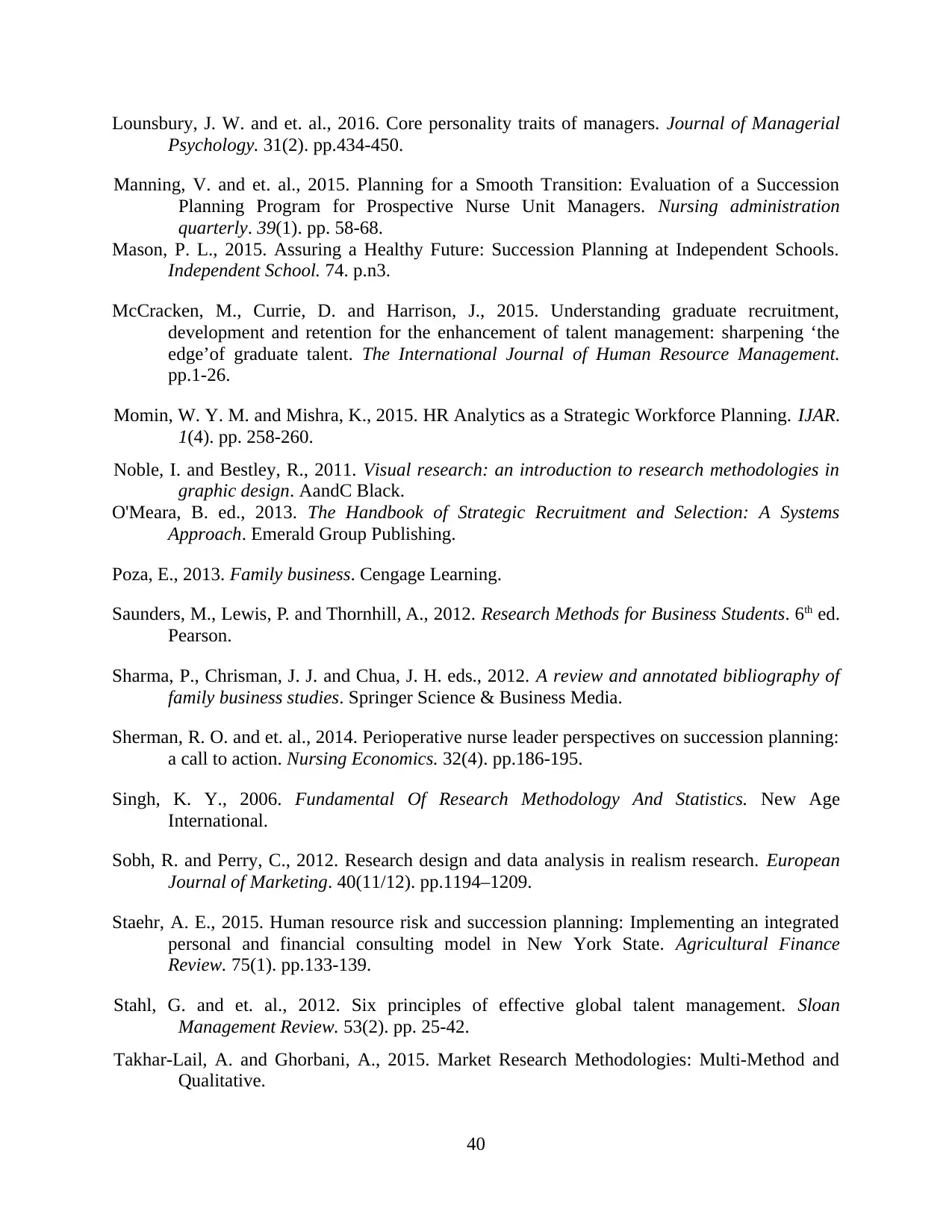
Lounsbury, J. W. and et. al., 2016. Core personality traits of managers. Journal of Managerial
Psychology. 31(2). pp.434-450.
Manning, V. and et. al., 2015. Planning for a Smooth Transition: Evaluation of a Succession
Planning Program for Prospective Nurse Unit Managers. Nursing administration
quarterly. 39(1). pp. 58-68.
Mason, P. L., 2015. Assuring a Healthy Future: Succession Planning at Independent Schools.
Independent School. 74. p.n3.
McCracken, M., Currie, D. and Harrison, J., 2015. Understanding graduate recruitment,
development and retention for the enhancement of talent management: sharpening ‘the
edge’of graduate talent. The International Journal of Human Resource Management.
pp.1-26.
Momin, W. Y. M. and Mishra, K., 2015. HR Analytics as a Strategic Workforce Planning. IJAR.
1(4). pp. 258-260.
Noble, I. and Bestley, R., 2011. Visual research: an introduction to research methodologies in
graphic design. AandC Black.
O'Meara, B. ed., 2013. The Handbook of Strategic Recruitment and Selection: A Systems
Approach. Emerald Group Publishing.
Poza, E., 2013. Family business. Cengage Learning.
Saunders, M., Lewis, P. and Thornhill, A., 2012. Research Methods for Business Students. 6th ed.
Pearson.
Sharma, P., Chrisman, J. J. and Chua, J. H. eds., 2012. A review and annotated bibliography of
family business studies. Springer Science & Business Media.
Sherman, R. O. and et. al., 2014. Perioperative nurse leader perspectives on succession planning:
a call to action. Nursing Economics. 32(4). pp.186-195.
Singh, K. Y., 2006. Fundamental Of Research Methodology And Statistics. New Age
International.
Sobh, R. and Perry, C., 2012. Research design and data analysis in realism research. European
Journal of Marketing. 40(11/12). pp.1194–1209.
Staehr, A. E., 2015. Human resource risk and succession planning: Implementing an integrated
personal and financial consulting model in New York State. Agricultural Finance
Review. 75(1). pp.133-139.
Stahl, G. and et. al., 2012. Six principles of effective global talent management. Sloan
Management Review. 53(2). pp. 25-42.
Takhar-Lail, A. and Ghorbani, A., 2015. Market Research Methodologies: Multi-Method and
Qualitative.
40
Psychology. 31(2). pp.434-450.
Manning, V. and et. al., 2015. Planning for a Smooth Transition: Evaluation of a Succession
Planning Program for Prospective Nurse Unit Managers. Nursing administration
quarterly. 39(1). pp. 58-68.
Mason, P. L., 2015. Assuring a Healthy Future: Succession Planning at Independent Schools.
Independent School. 74. p.n3.
McCracken, M., Currie, D. and Harrison, J., 2015. Understanding graduate recruitment,
development and retention for the enhancement of talent management: sharpening ‘the
edge’of graduate talent. The International Journal of Human Resource Management.
pp.1-26.
Momin, W. Y. M. and Mishra, K., 2015. HR Analytics as a Strategic Workforce Planning. IJAR.
1(4). pp. 258-260.
Noble, I. and Bestley, R., 2011. Visual research: an introduction to research methodologies in
graphic design. AandC Black.
O'Meara, B. ed., 2013. The Handbook of Strategic Recruitment and Selection: A Systems
Approach. Emerald Group Publishing.
Poza, E., 2013. Family business. Cengage Learning.
Saunders, M., Lewis, P. and Thornhill, A., 2012. Research Methods for Business Students. 6th ed.
Pearson.
Sharma, P., Chrisman, J. J. and Chua, J. H. eds., 2012. A review and annotated bibliography of
family business studies. Springer Science & Business Media.
Sherman, R. O. and et. al., 2014. Perioperative nurse leader perspectives on succession planning:
a call to action. Nursing Economics. 32(4). pp.186-195.
Singh, K. Y., 2006. Fundamental Of Research Methodology And Statistics. New Age
International.
Sobh, R. and Perry, C., 2012. Research design and data analysis in realism research. European
Journal of Marketing. 40(11/12). pp.1194–1209.
Staehr, A. E., 2015. Human resource risk and succession planning: Implementing an integrated
personal and financial consulting model in New York State. Agricultural Finance
Review. 75(1). pp.133-139.
Stahl, G. and et. al., 2012. Six principles of effective global talent management. Sloan
Management Review. 53(2). pp. 25-42.
Takhar-Lail, A. and Ghorbani, A., 2015. Market Research Methodologies: Multi-Method and
Qualitative.
40
Paraphrase This Document
Need a fresh take? Get an instant paraphrase of this document with our AI Paraphraser
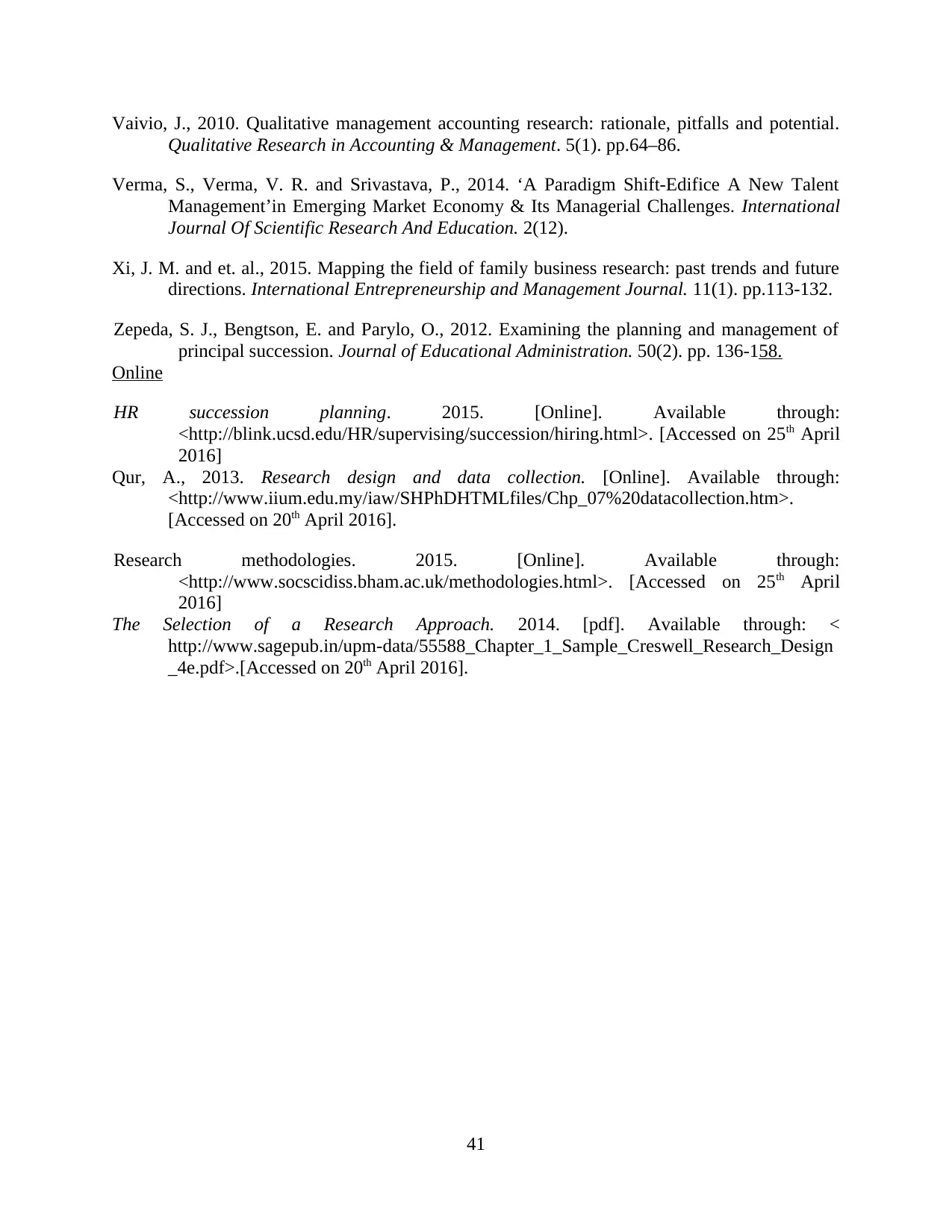
Vaivio, J., 2010. Qualitative management accounting research: rationale, pitfalls and potential.
Qualitative Research in Accounting & Management. 5(1). pp.64–86.
Verma, S., Verma, V. R. and Srivastava, P., 2014. ‘A Paradigm Shift-Edifice A New Talent
Management’in Emerging Market Economy & Its Managerial Challenges. International
Journal Of Scientific Research And Education. 2(12).
Xi, J. M. and et. al., 2015. Mapping the field of family business research: past trends and future
directions. International Entrepreneurship and Management Journal. 11(1). pp.113-132.
Zepeda, S. J., Bengtson, E. and Parylo, O., 2012. Examining the planning and management of
principal succession. Journal of Educational Administration. 50(2). pp. 136-158.
Online
HR succession planning. 2015. [Online]. Available through:
<http://blink.ucsd.edu/HR/supervising/succession/hiring.html>. [Accessed on 25th April
2016]
Qur, A., 2013. Research design and data collection. [Online]. Available through:
<http://www.iium.edu.my/iaw/SHPhDHTMLfiles/Chp_07%20datacollection.htm>.
[Accessed on 20th April 2016].
Research methodologies. 2015. [Online]. Available through:
<http://www.socscidiss.bham.ac.uk/methodologies.html>. [Accessed on 25th April
2016]
The Selection of a Research Approach. 2014. [pdf]. Available through: <
http://www.sagepub.in/upm-data/55588_Chapter_1_Sample_Creswell_Research_Design
_4e.pdf>.[Accessed on 20th April 2016].
41
Qualitative Research in Accounting & Management. 5(1). pp.64–86.
Verma, S., Verma, V. R. and Srivastava, P., 2014. ‘A Paradigm Shift-Edifice A New Talent
Management’in Emerging Market Economy & Its Managerial Challenges. International
Journal Of Scientific Research And Education. 2(12).
Xi, J. M. and et. al., 2015. Mapping the field of family business research: past trends and future
directions. International Entrepreneurship and Management Journal. 11(1). pp.113-132.
Zepeda, S. J., Bengtson, E. and Parylo, O., 2012. Examining the planning and management of
principal succession. Journal of Educational Administration. 50(2). pp. 136-158.
Online
HR succession planning. 2015. [Online]. Available through:
<http://blink.ucsd.edu/HR/supervising/succession/hiring.html>. [Accessed on 25th April
2016]
Qur, A., 2013. Research design and data collection. [Online]. Available through:
<http://www.iium.edu.my/iaw/SHPhDHTMLfiles/Chp_07%20datacollection.htm>.
[Accessed on 20th April 2016].
Research methodologies. 2015. [Online]. Available through:
<http://www.socscidiss.bham.ac.uk/methodologies.html>. [Accessed on 25th April
2016]
The Selection of a Research Approach. 2014. [pdf]. Available through: <
http://www.sagepub.in/upm-data/55588_Chapter_1_Sample_Creswell_Research_Design
_4e.pdf>.[Accessed on 20th April 2016].
41
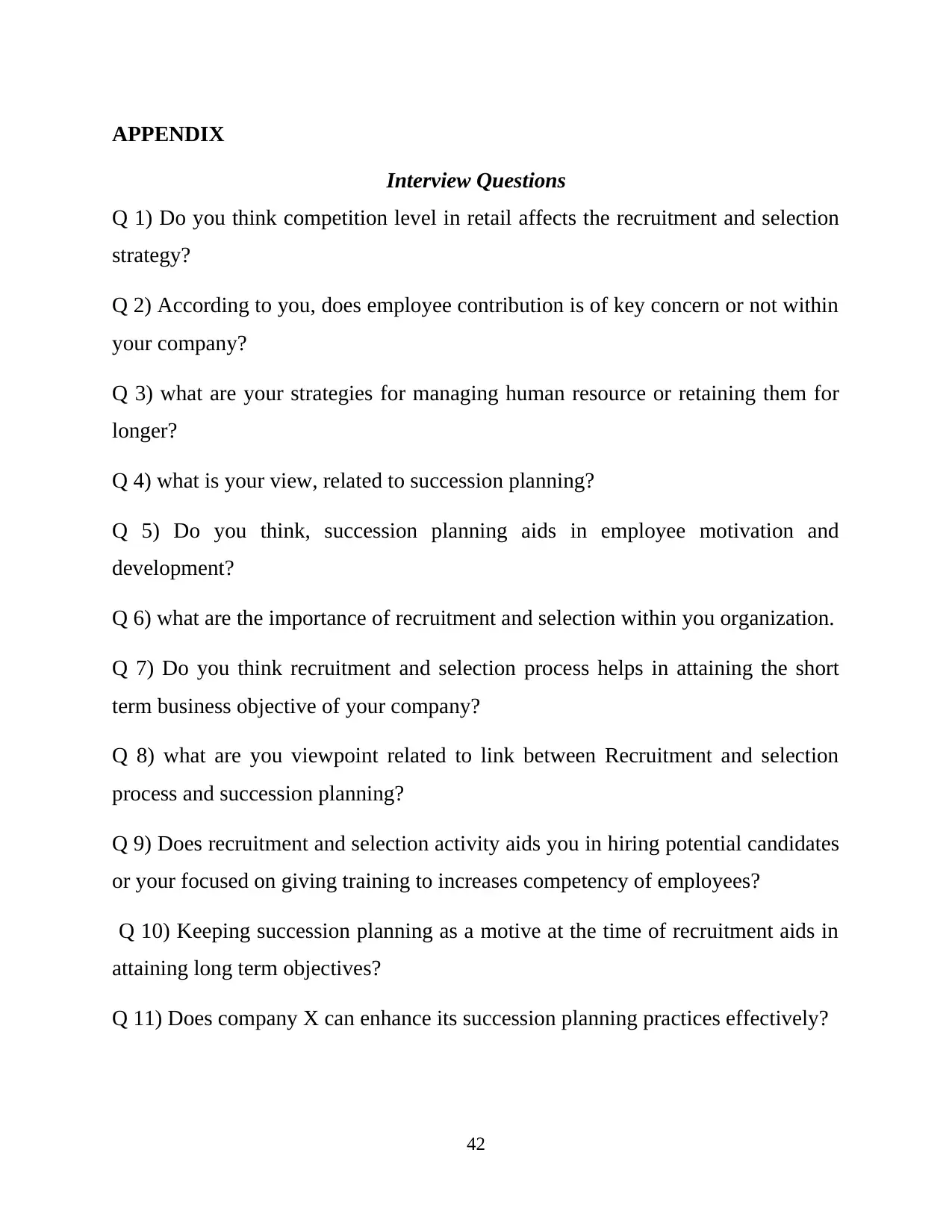
APPENDIX
Interview Questions
Q 1) Do you think competition level in retail affects the recruitment and selection
strategy?
Q 2) According to you, does employee contribution is of key concern or not within
your company?
Q 3) what are your strategies for managing human resource or retaining them for
longer?
Q 4) what is your view, related to succession planning?
Q 5) Do you think, succession planning aids in employee motivation and
development?
Q 6) what are the importance of recruitment and selection within you organization.
Q 7) Do you think recruitment and selection process helps in attaining the short
term business objective of your company?
Q 8) what are you viewpoint related to link between Recruitment and selection
process and succession planning?
Q 9) Does recruitment and selection activity aids you in hiring potential candidates
or your focused on giving training to increases competency of employees?
Q 10) Keeping succession planning as a motive at the time of recruitment aids in
attaining long term objectives?
Q 11) Does company X can enhance its succession planning practices effectively?
42
Interview Questions
Q 1) Do you think competition level in retail affects the recruitment and selection
strategy?
Q 2) According to you, does employee contribution is of key concern or not within
your company?
Q 3) what are your strategies for managing human resource or retaining them for
longer?
Q 4) what is your view, related to succession planning?
Q 5) Do you think, succession planning aids in employee motivation and
development?
Q 6) what are the importance of recruitment and selection within you organization.
Q 7) Do you think recruitment and selection process helps in attaining the short
term business objective of your company?
Q 8) what are you viewpoint related to link between Recruitment and selection
process and succession planning?
Q 9) Does recruitment and selection activity aids you in hiring potential candidates
or your focused on giving training to increases competency of employees?
Q 10) Keeping succession planning as a motive at the time of recruitment aids in
attaining long term objectives?
Q 11) Does company X can enhance its succession planning practices effectively?
42
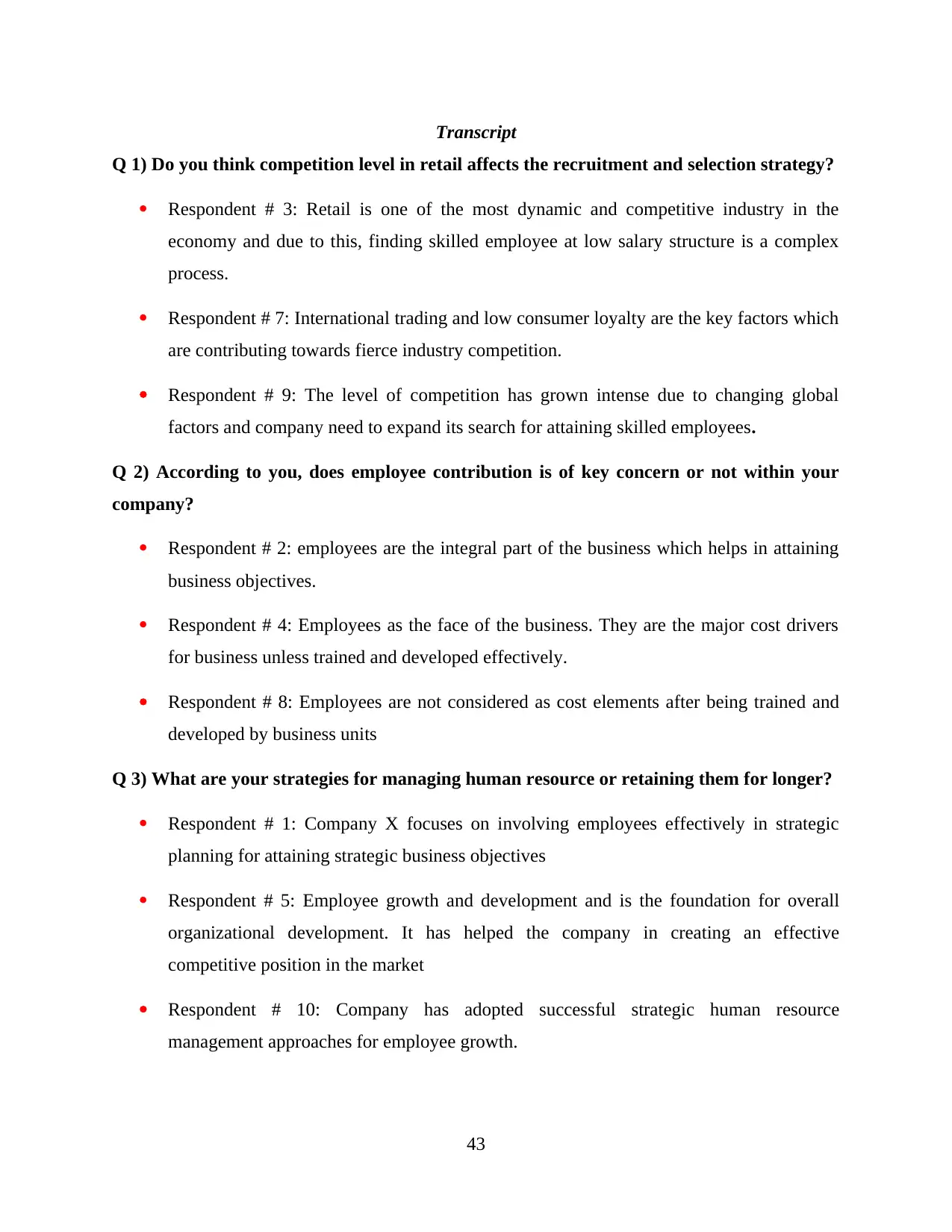
Transcript
Q 1) Do you think competition level in retail affects the recruitment and selection strategy?
Respondent # 3: Retail is one of the most dynamic and competitive industry in the
economy and due to this, finding skilled employee at low salary structure is a complex
process.
Respondent # 7: International trading and low consumer loyalty are the key factors which
are contributing towards fierce industry competition.
Respondent # 9: The level of competition has grown intense due to changing global
factors and company need to expand its search for attaining skilled employees.
Q 2) According to you, does employee contribution is of key concern or not within your
company?
Respondent # 2: employees are the integral part of the business which helps in attaining
business objectives.
Respondent # 4: Employees as the face of the business. They are the major cost drivers
for business unless trained and developed effectively.
Respondent # 8: Employees are not considered as cost elements after being trained and
developed by business units
Q 3) What are your strategies for managing human resource or retaining them for longer?
Respondent # 1: Company X focuses on involving employees effectively in strategic
planning for attaining strategic business objectives
Respondent # 5: Employee growth and development and is the foundation for overall
organizational development. It has helped the company in creating an effective
competitive position in the market
Respondent # 10: Company has adopted successful strategic human resource
management approaches for employee growth.
43
Q 1) Do you think competition level in retail affects the recruitment and selection strategy?
Respondent # 3: Retail is one of the most dynamic and competitive industry in the
economy and due to this, finding skilled employee at low salary structure is a complex
process.
Respondent # 7: International trading and low consumer loyalty are the key factors which
are contributing towards fierce industry competition.
Respondent # 9: The level of competition has grown intense due to changing global
factors and company need to expand its search for attaining skilled employees.
Q 2) According to you, does employee contribution is of key concern or not within your
company?
Respondent # 2: employees are the integral part of the business which helps in attaining
business objectives.
Respondent # 4: Employees as the face of the business. They are the major cost drivers
for business unless trained and developed effectively.
Respondent # 8: Employees are not considered as cost elements after being trained and
developed by business units
Q 3) What are your strategies for managing human resource or retaining them for longer?
Respondent # 1: Company X focuses on involving employees effectively in strategic
planning for attaining strategic business objectives
Respondent # 5: Employee growth and development and is the foundation for overall
organizational development. It has helped the company in creating an effective
competitive position in the market
Respondent # 10: Company has adopted successful strategic human resource
management approaches for employee growth.
43
Secure Best Marks with AI Grader
Need help grading? Try our AI Grader for instant feedback on your assignments.
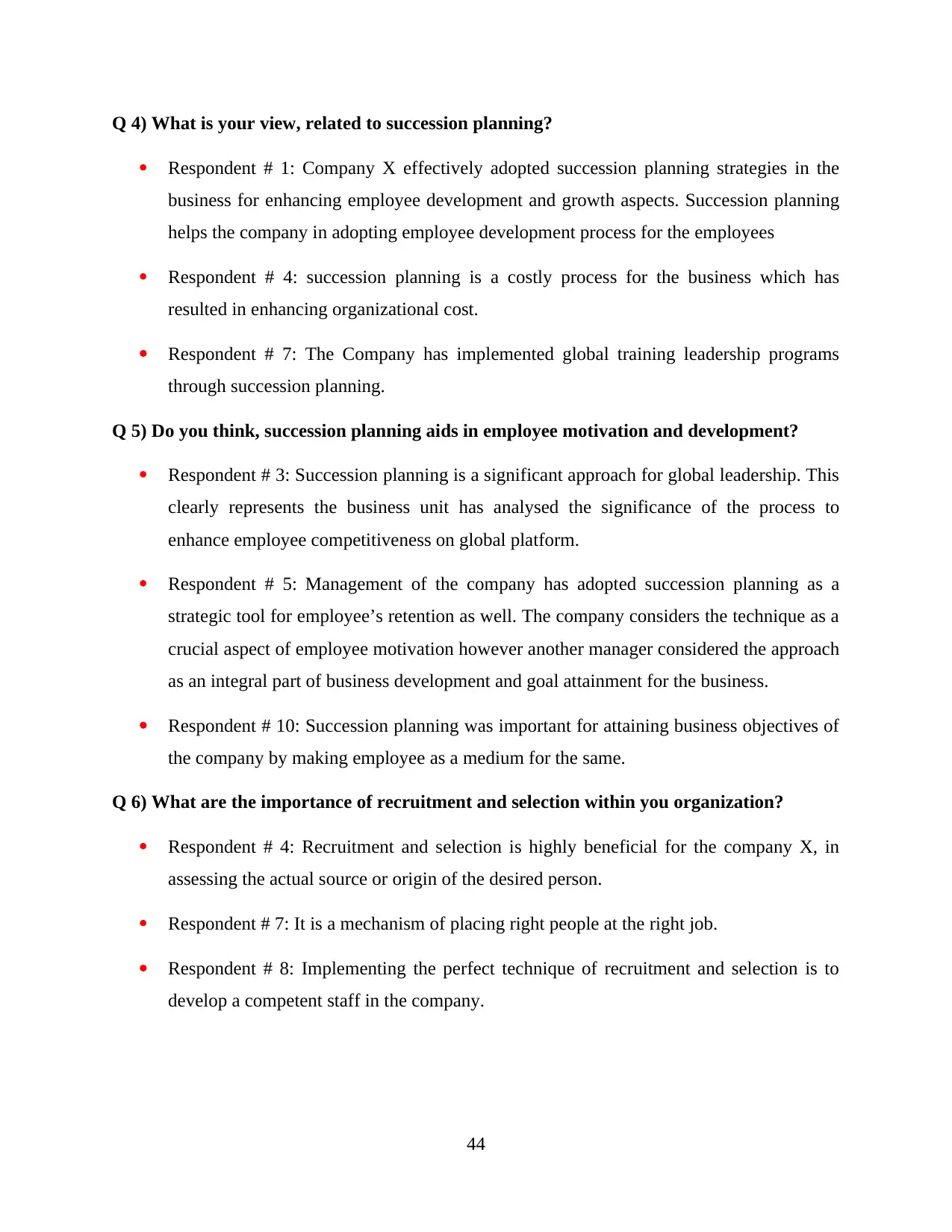
Q 4) What is your view, related to succession planning?
Respondent # 1: Company X effectively adopted succession planning strategies in the
business for enhancing employee development and growth aspects. Succession planning
helps the company in adopting employee development process for the employees
Respondent # 4: succession planning is a costly process for the business which has
resulted in enhancing organizational cost.
Respondent # 7: The Company has implemented global training leadership programs
through succession planning.
Q 5) Do you think, succession planning aids in employee motivation and development?
Respondent # 3: Succession planning is a significant approach for global leadership. This
clearly represents the business unit has analysed the significance of the process to
enhance employee competitiveness on global platform.
Respondent # 5: Management of the company has adopted succession planning as a
strategic tool for employee’s retention as well. The company considers the technique as a
crucial aspect of employee motivation however another manager considered the approach
as an integral part of business development and goal attainment for the business.
Respondent # 10: Succession planning was important for attaining business objectives of
the company by making employee as a medium for the same.
Q 6) What are the importance of recruitment and selection within you organization?
Respondent # 4: Recruitment and selection is highly beneficial for the company X, in
assessing the actual source or origin of the desired person.
Respondent # 7: It is a mechanism of placing right people at the right job.
Respondent # 8: Implementing the perfect technique of recruitment and selection is to
develop a competent staff in the company.
44
Respondent # 1: Company X effectively adopted succession planning strategies in the
business for enhancing employee development and growth aspects. Succession planning
helps the company in adopting employee development process for the employees
Respondent # 4: succession planning is a costly process for the business which has
resulted in enhancing organizational cost.
Respondent # 7: The Company has implemented global training leadership programs
through succession planning.
Q 5) Do you think, succession planning aids in employee motivation and development?
Respondent # 3: Succession planning is a significant approach for global leadership. This
clearly represents the business unit has analysed the significance of the process to
enhance employee competitiveness on global platform.
Respondent # 5: Management of the company has adopted succession planning as a
strategic tool for employee’s retention as well. The company considers the technique as a
crucial aspect of employee motivation however another manager considered the approach
as an integral part of business development and goal attainment for the business.
Respondent # 10: Succession planning was important for attaining business objectives of
the company by making employee as a medium for the same.
Q 6) What are the importance of recruitment and selection within you organization?
Respondent # 4: Recruitment and selection is highly beneficial for the company X, in
assessing the actual source or origin of the desired person.
Respondent # 7: It is a mechanism of placing right people at the right job.
Respondent # 8: Implementing the perfect technique of recruitment and selection is to
develop a competent staff in the company.
44
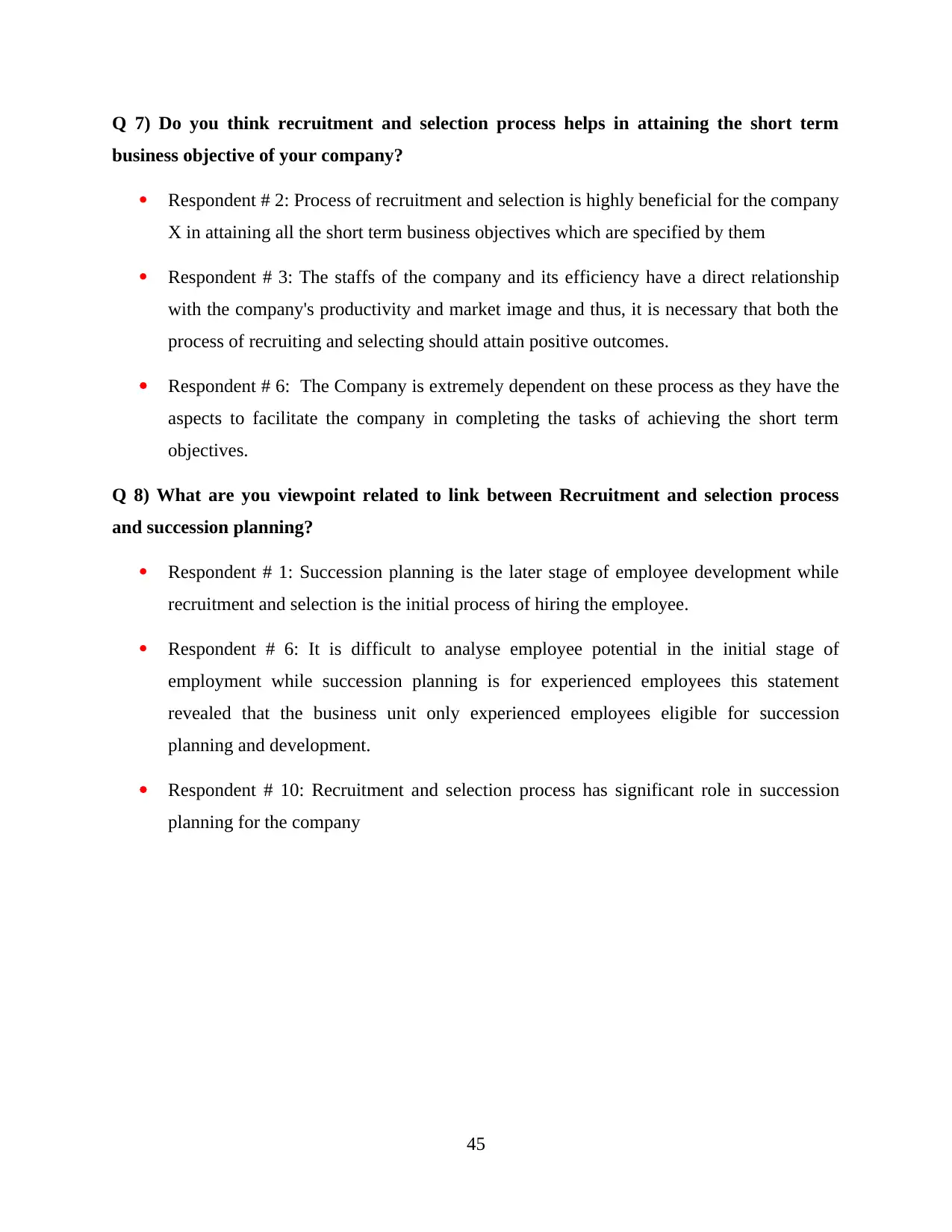
Q 7) Do you think recruitment and selection process helps in attaining the short term
business objective of your company?
Respondent # 2: Process of recruitment and selection is highly beneficial for the company
X in attaining all the short term business objectives which are specified by them
Respondent # 3: The staffs of the company and its efficiency have a direct relationship
with the company's productivity and market image and thus, it is necessary that both the
process of recruiting and selecting should attain positive outcomes.
Respondent # 6: The Company is extremely dependent on these process as they have the
aspects to facilitate the company in completing the tasks of achieving the short term
objectives.
Q 8) What are you viewpoint related to link between Recruitment and selection process
and succession planning?
Respondent # 1: Succession planning is the later stage of employee development while
recruitment and selection is the initial process of hiring the employee.
Respondent # 6: It is difficult to analyse employee potential in the initial stage of
employment while succession planning is for experienced employees this statement
revealed that the business unit only experienced employees eligible for succession
planning and development.
Respondent # 10: Recruitment and selection process has significant role in succession
planning for the company
45
business objective of your company?
Respondent # 2: Process of recruitment and selection is highly beneficial for the company
X in attaining all the short term business objectives which are specified by them
Respondent # 3: The staffs of the company and its efficiency have a direct relationship
with the company's productivity and market image and thus, it is necessary that both the
process of recruiting and selecting should attain positive outcomes.
Respondent # 6: The Company is extremely dependent on these process as they have the
aspects to facilitate the company in completing the tasks of achieving the short term
objectives.
Q 8) What are you viewpoint related to link between Recruitment and selection process
and succession planning?
Respondent # 1: Succession planning is the later stage of employee development while
recruitment and selection is the initial process of hiring the employee.
Respondent # 6: It is difficult to analyse employee potential in the initial stage of
employment while succession planning is for experienced employees this statement
revealed that the business unit only experienced employees eligible for succession
planning and development.
Respondent # 10: Recruitment and selection process has significant role in succession
planning for the company
45
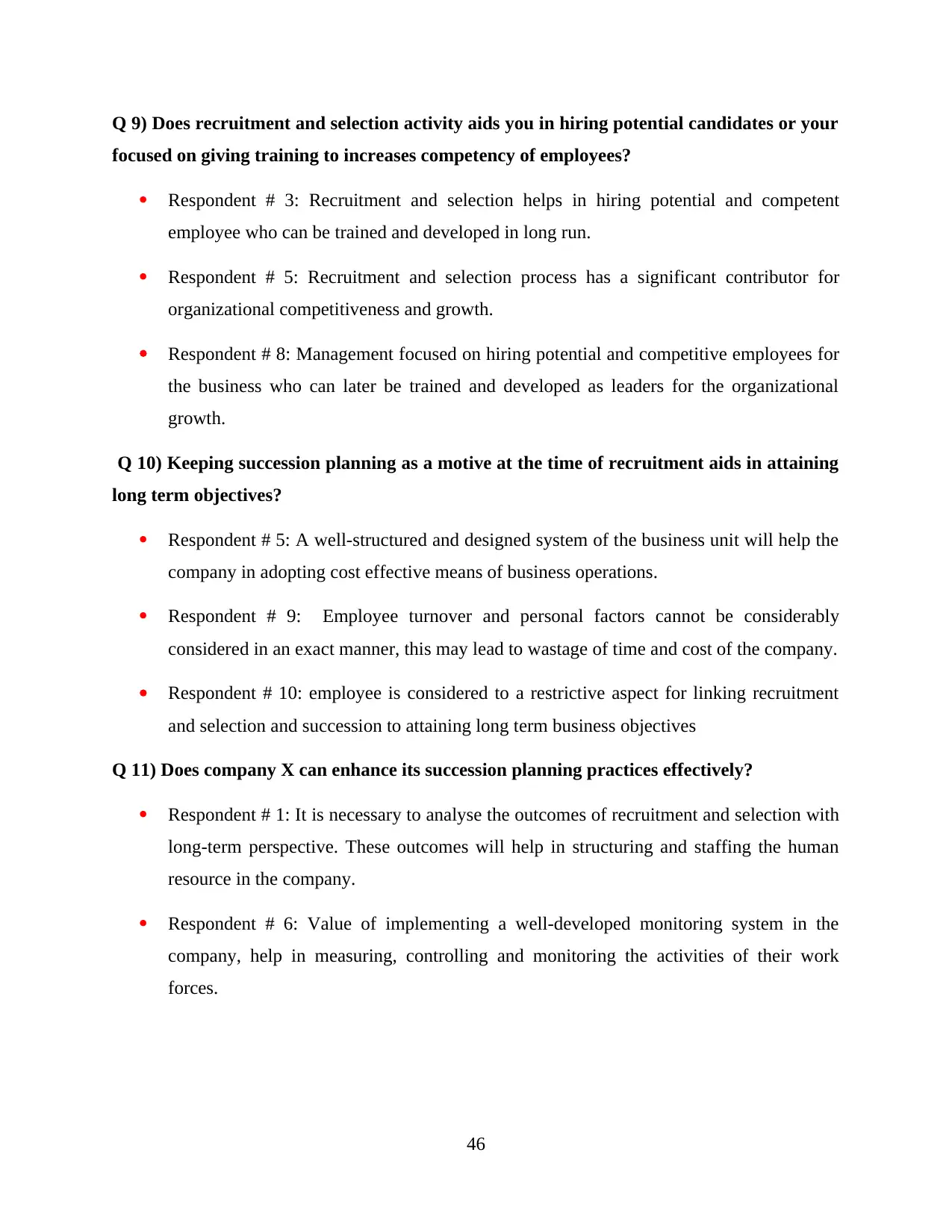
Q 9) Does recruitment and selection activity aids you in hiring potential candidates or your
focused on giving training to increases competency of employees?
Respondent # 3: Recruitment and selection helps in hiring potential and competent
employee who can be trained and developed in long run.
Respondent # 5: Recruitment and selection process has a significant contributor for
organizational competitiveness and growth.
Respondent # 8: Management focused on hiring potential and competitive employees for
the business who can later be trained and developed as leaders for the organizational
growth.
Q 10) Keeping succession planning as a motive at the time of recruitment aids in attaining
long term objectives?
Respondent # 5: A well-structured and designed system of the business unit will help the
company in adopting cost effective means of business operations.
Respondent # 9: Employee turnover and personal factors cannot be considerably
considered in an exact manner, this may lead to wastage of time and cost of the company.
Respondent # 10: employee is considered to a restrictive aspect for linking recruitment
and selection and succession to attaining long term business objectives
Q 11) Does company X can enhance its succession planning practices effectively?
Respondent # 1: It is necessary to analyse the outcomes of recruitment and selection with
long-term perspective. These outcomes will help in structuring and staffing the human
resource in the company.
Respondent # 6: Value of implementing a well-developed monitoring system in the
company, help in measuring, controlling and monitoring the activities of their work
forces.
46
focused on giving training to increases competency of employees?
Respondent # 3: Recruitment and selection helps in hiring potential and competent
employee who can be trained and developed in long run.
Respondent # 5: Recruitment and selection process has a significant contributor for
organizational competitiveness and growth.
Respondent # 8: Management focused on hiring potential and competitive employees for
the business who can later be trained and developed as leaders for the organizational
growth.
Q 10) Keeping succession planning as a motive at the time of recruitment aids in attaining
long term objectives?
Respondent # 5: A well-structured and designed system of the business unit will help the
company in adopting cost effective means of business operations.
Respondent # 9: Employee turnover and personal factors cannot be considerably
considered in an exact manner, this may lead to wastage of time and cost of the company.
Respondent # 10: employee is considered to a restrictive aspect for linking recruitment
and selection and succession to attaining long term business objectives
Q 11) Does company X can enhance its succession planning practices effectively?
Respondent # 1: It is necessary to analyse the outcomes of recruitment and selection with
long-term perspective. These outcomes will help in structuring and staffing the human
resource in the company.
Respondent # 6: Value of implementing a well-developed monitoring system in the
company, help in measuring, controlling and monitoring the activities of their work
forces.
46
Paraphrase This Document
Need a fresh take? Get an instant paraphrase of this document with our AI Paraphraser
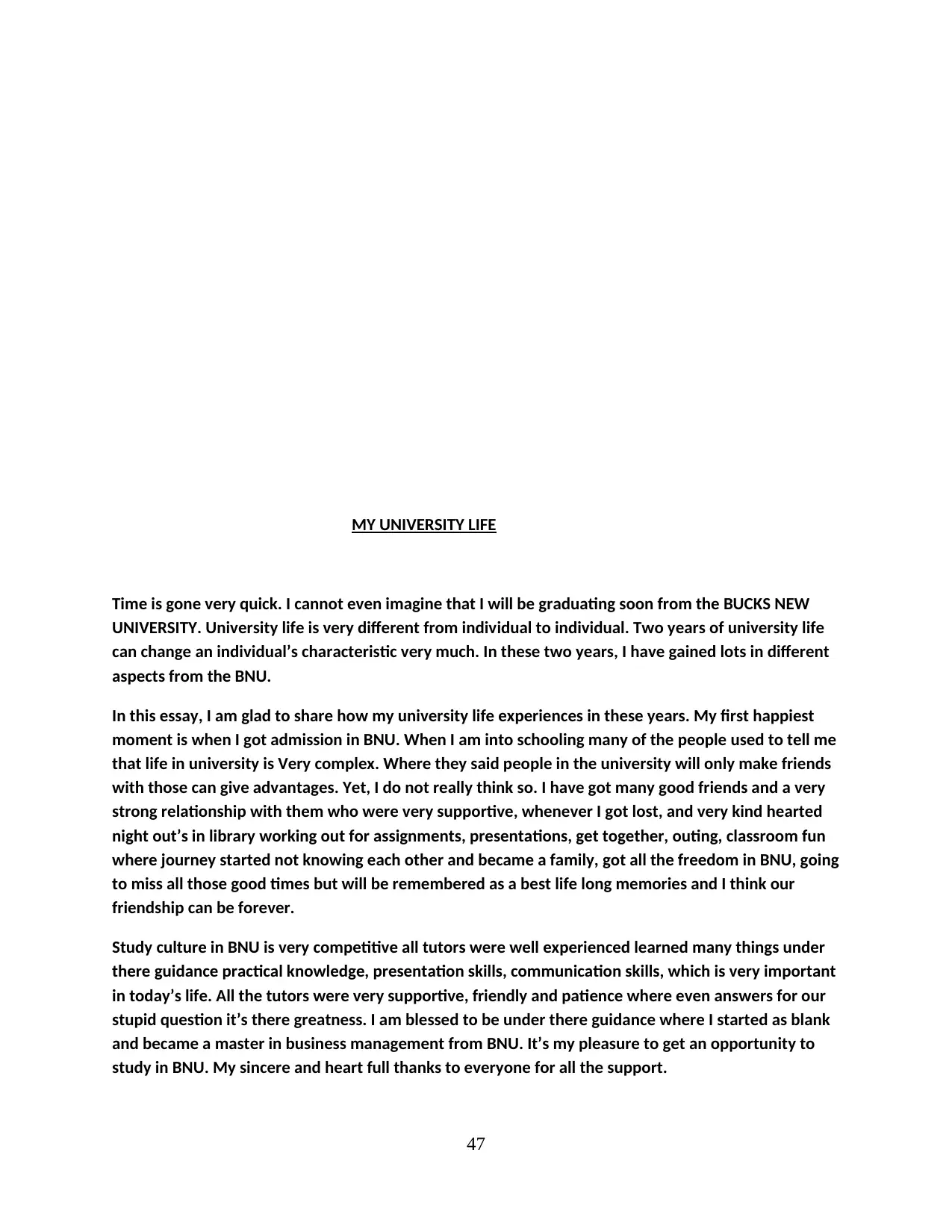
MY UNIVERSITY LIFE
Time is gone very quick. I cannot even imagine that I will be graduating soon from the BUCKS NEW
UNIVERSITY. University life is very different from individual to individual. Two years of university life
can change an individual’s characteristic very much. In these two years, I have gained lots in different
aspects from the BNU.
In this essay, I am glad to share how my university life experiences in these years. My first happiest
moment is when I got admission in BNU. When I am into schooling many of the people used to tell me
that life in university is Very complex. Where they said people in the university will only make friends
with those can give advantages. Yet, I do not really think so. I have got many good friends and a very
strong relationship with them who were very supportive, whenever I got lost, and very kind hearted
night out’s in library working out for assignments, presentations, get together, outing, classroom fun
where journey started not knowing each other and became a family, got all the freedom in BNU, going
to miss all those good times but will be remembered as a best life long memories and I think our
friendship can be forever.
Study culture in BNU is very competitive all tutors were well experienced learned many things under
there guidance practical knowledge, presentation skills, communication skills, which is very important
in today’s life. All the tutors were very supportive, friendly and patience where even answers for our
stupid question it’s there greatness. I am blessed to be under there guidance where I started as blank
and became a master in business management from BNU. It’s my pleasure to get an opportunity to
study in BNU. My sincere and heart full thanks to everyone for all the support.
47
Time is gone very quick. I cannot even imagine that I will be graduating soon from the BUCKS NEW
UNIVERSITY. University life is very different from individual to individual. Two years of university life
can change an individual’s characteristic very much. In these two years, I have gained lots in different
aspects from the BNU.
In this essay, I am glad to share how my university life experiences in these years. My first happiest
moment is when I got admission in BNU. When I am into schooling many of the people used to tell me
that life in university is Very complex. Where they said people in the university will only make friends
with those can give advantages. Yet, I do not really think so. I have got many good friends and a very
strong relationship with them who were very supportive, whenever I got lost, and very kind hearted
night out’s in library working out for assignments, presentations, get together, outing, classroom fun
where journey started not knowing each other and became a family, got all the freedom in BNU, going
to miss all those good times but will be remembered as a best life long memories and I think our
friendship can be forever.
Study culture in BNU is very competitive all tutors were well experienced learned many things under
there guidance practical knowledge, presentation skills, communication skills, which is very important
in today’s life. All the tutors were very supportive, friendly and patience where even answers for our
stupid question it’s there greatness. I am blessed to be under there guidance where I started as blank
and became a master in business management from BNU. It’s my pleasure to get an opportunity to
study in BNU. My sincere and heart full thanks to everyone for all the support.
47
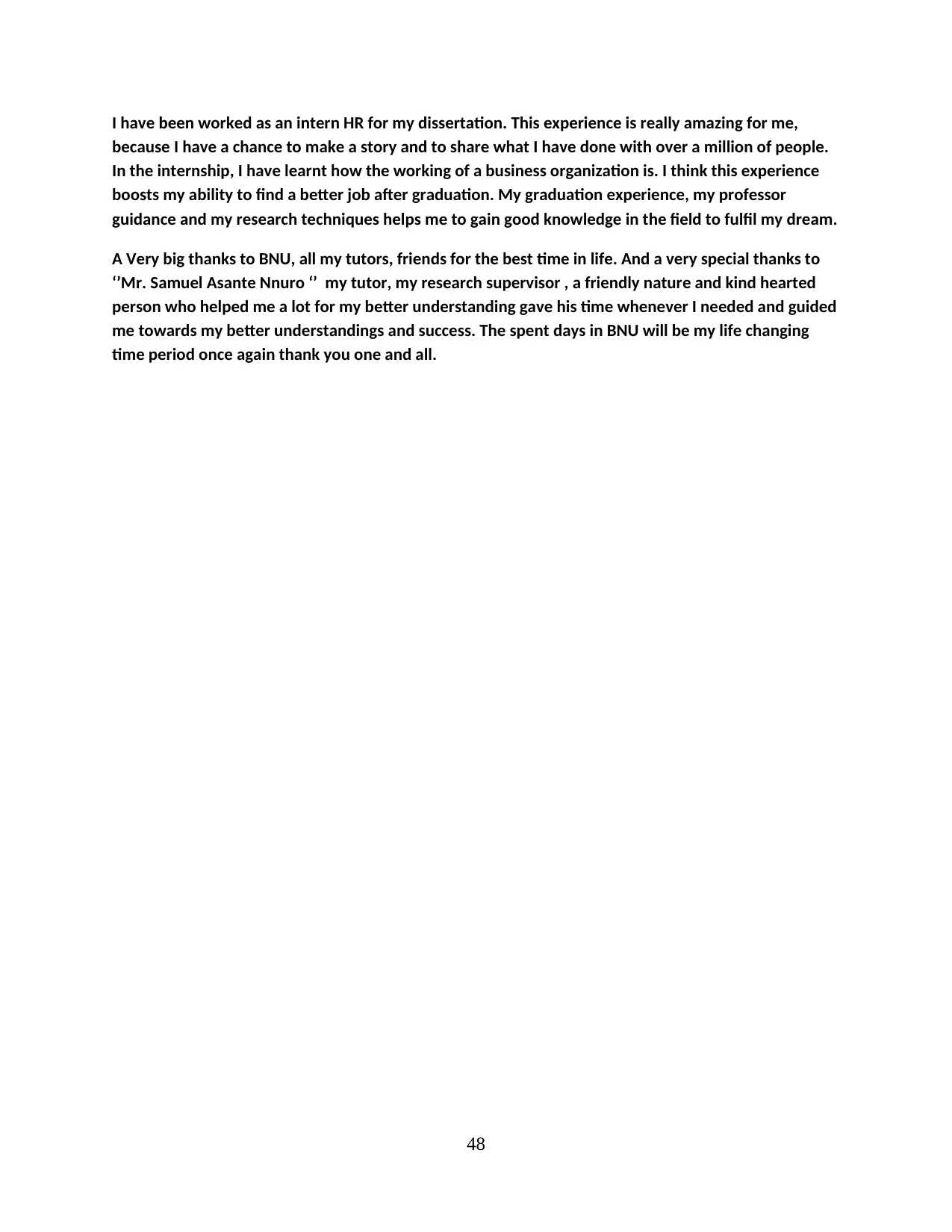
I have been worked as an intern HR for my dissertation. This experience is really amazing for me,
because I have a chance to make a story and to share what I have done with over a million of people.
In the internship, I have learnt how the working of a business organization is. I think this experience
boosts my ability to find a better job after graduation. My graduation experience, my professor
guidance and my research techniques helps me to gain good knowledge in the field to fulfil my dream.
A Very big thanks to BNU, all my tutors, friends for the best time in life. And a very special thanks to
‘’Mr. Samuel Asante Nnuro ‘’ my tutor, my research supervisor , a friendly nature and kind hearted
person who helped me a lot for my better understanding gave his time whenever I needed and guided
me towards my better understandings and success. The spent days in BNU will be my life changing
time period once again thank you one and all.
48
because I have a chance to make a story and to share what I have done with over a million of people.
In the internship, I have learnt how the working of a business organization is. I think this experience
boosts my ability to find a better job after graduation. My graduation experience, my professor
guidance and my research techniques helps me to gain good knowledge in the field to fulfil my dream.
A Very big thanks to BNU, all my tutors, friends for the best time in life. And a very special thanks to
‘’Mr. Samuel Asante Nnuro ‘’ my tutor, my research supervisor , a friendly nature and kind hearted
person who helped me a lot for my better understanding gave his time whenever I needed and guided
me towards my better understandings and success. The spent days in BNU will be my life changing
time period once again thank you one and all.
48
1 out of 51
Related Documents
Your All-in-One AI-Powered Toolkit for Academic Success.
+13062052269
info@desklib.com
Available 24*7 on WhatsApp / Email
![[object Object]](/_next/static/media/star-bottom.7253800d.svg)
Unlock your academic potential
© 2024 | Zucol Services PVT LTD | All rights reserved.





